Search Result
Results for "
nanoparticles
" in MedChemExpress (MCE) Product Catalog:
142
Biochemical Assay Reagents
8
Isotope-Labeled Compounds
| Cat. No. |
Product Name |
Target |
Research Areas |
Chemical Structure |
-
- HY-148648
-
|
|
Liposome
|
Others
|
|
Lipid 29 is an ionizable amino lipid. Lipid 29 can be used to form lipid nanoparticles .
|
-

-
- HY-141629
-
|
Sphingomyelin 16:0
|
Liposome
Endogenous Metabolite
|
Others
|
|
N-Palmitoyl-D-sphingomyelin (Sphingomyelin 16:0) (Compound SM-03) can be used for the synthesis of lipid nanoparticles .
|
-
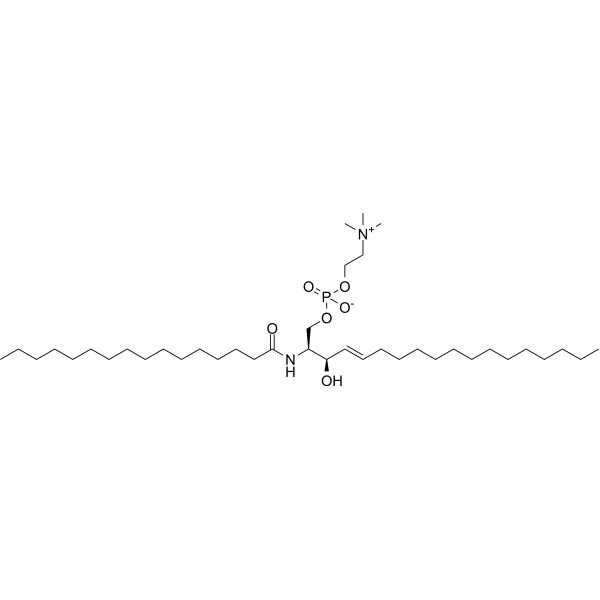
-
- HY-163044
-
|
|
Others
|
Infection
|
|
C12-SPM is a lipid nanoparticle that mediates siRNA delivery. C12-SPM has no significant cytotoxicity and can be used for research on hepatoviral diseases .
|
-
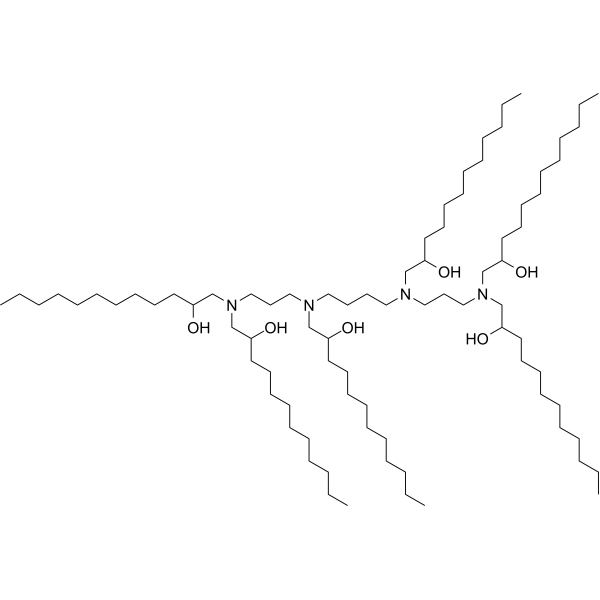
-
- HY-153187
-
|
|
Liposome
|
Others
|
|
LNP Lipid-4 (Compound 8-8) is a lipid compound. LNP Lipid-4 is involved in the synthesis of lipid nanoparticles compositions. LNP Lipid-4 has potential applications in the transportation of biologically active substances .
|
-
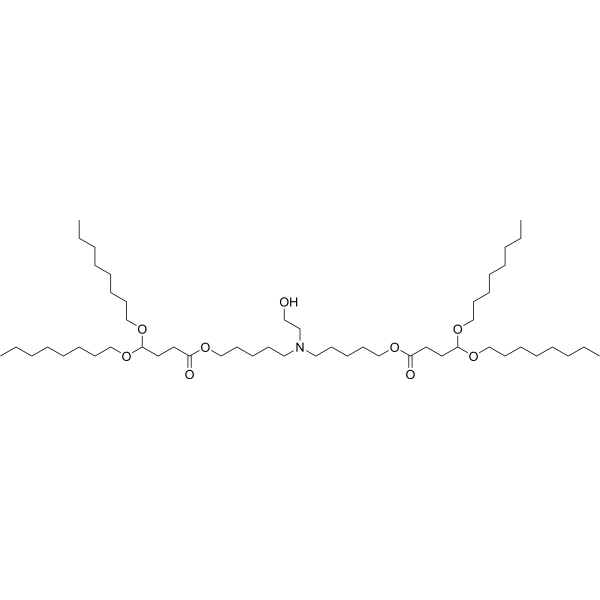
-
- HY-150241
-
|
|
Liposome
|
Others
|
|
DOPE-NHS is a linker. DOPE-NHS can be used for peptides to be conjugated to exosomes and possibly other membrane-based nanoparticles. DOPE-NHS can be used for drug delivery .
|
-
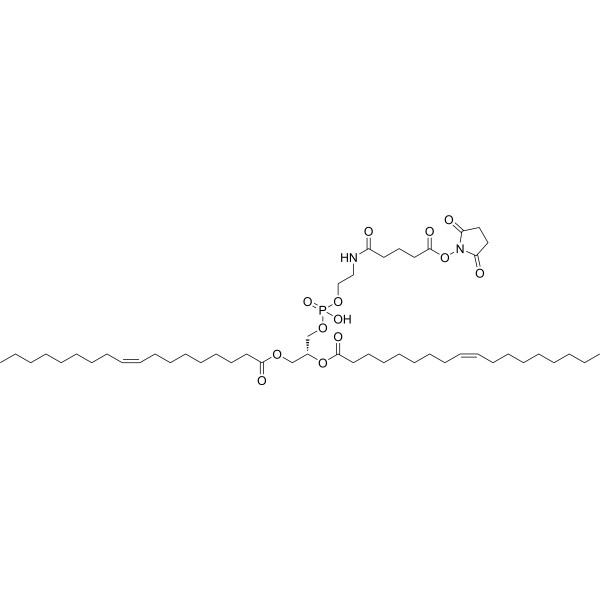
-
- HY-W441014
-
|
|
Liposome
|
Others
|
|
DSPE-PEG-NHS, MW 2000 is a pegylated phospholipid derivatives which can be used to prepare liposome or lipid nanoparticles for targeted drug delivery system, such as DNA or mRNA vaccine.
|
-
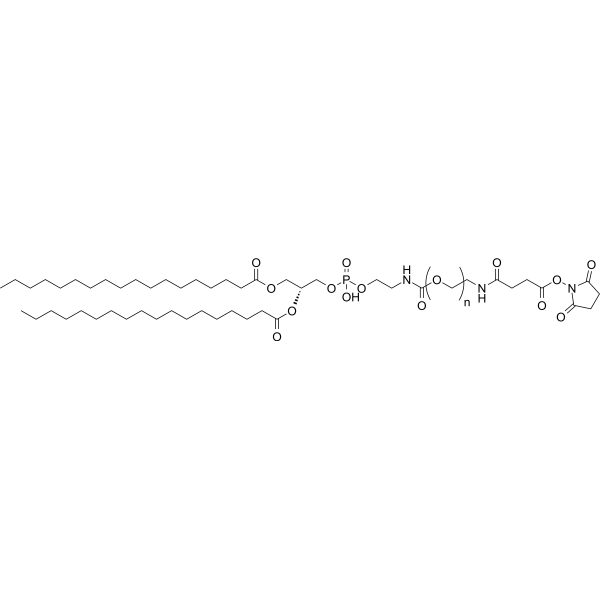
-
- HY-134541
-
SM-102
Maximum Cited Publications
7 Publications Verification
|
Liposome
|
Infection
|
|
SM-102 is an amino cationic lipid useful in the formation of lipid nanoparticles (LNPs). SM-102 has higher transfection efficiency. SM-102 plays an important role in the effectiveness of lipid nanoparticles (LNPs) in delivering mRNA therapeutics and vaccines .
|
-

-
- HY-W040193
-
DSPC
2 Publications Verification
1,2-Distearoyl-sn-glycero-3-PC; 1,2-Distearoyl-sn-glycero-3-phosphorylcholine
|
Liposome
|
Others
|
|
DSPC (1,2-Distearoyl-sn-glycero-3-phosphorylcholine) is a cylindrical-shaped lipid. DSPC is used to synthesize liposomes, and is the lipid component in the lipid nanoparticle (LNP) system .
|
-

-
- HY-46759
-
|
|
Liposome
|
Infection
|
|
Genevant CL1 is an ionizable lipid (lipid 10, pKa=6.3), and it can be used for mRNA lipid nanoparticle (LNP) vaccine delivery [1][2].
|
-

-
- HY-133952
-
|
|
Liposome
|
Cancer
|
|
7-Oxotridecanedioic acid is a biodegradable cationic lipid intermediate compound for lipid nanoparticles formation. 7-Oxotridecanedioic acid can be incorporated into a lipid particle for delivering active agents .
|
-
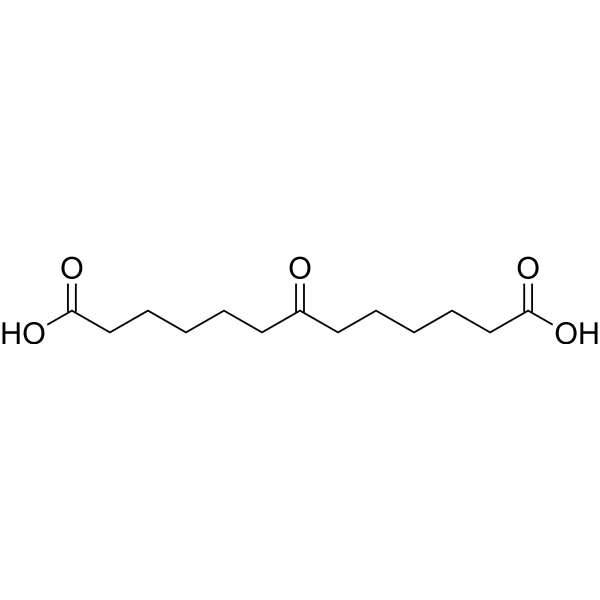
-
- HY-147081
-
|
AGRO-100
|
Others
|
Cancer
|
|
AS1411 is a nucleic acid aptamer that targets nucleolin. AS1411 can deliver nanoparticles, oligonucleotides, and small molecules to cancer cells, exerting antitumor effects .
|
-

-
- HY-143700
-
-
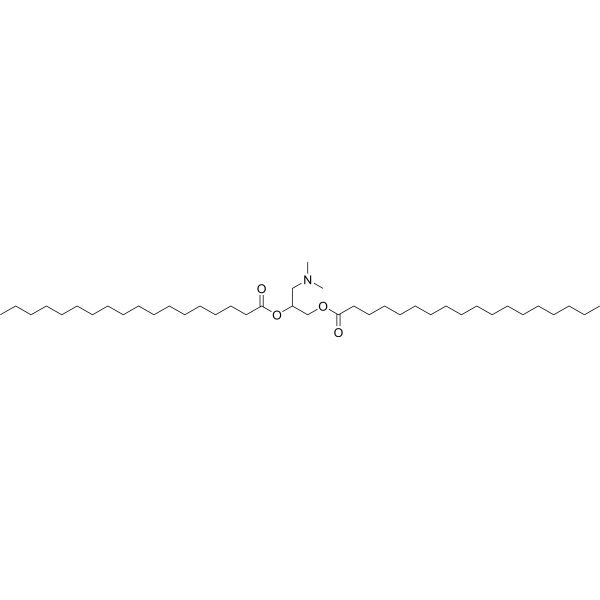
-
- HY-W440779
-
|
|
Liposome
|
Metabolic Disease
|
|
BP Lipid 135 is a cationieally ionizable lipid. BP Lipid 135 can be used to prepare lipid nanoparticles (LNP) (WO2022218503A1) .
|
-
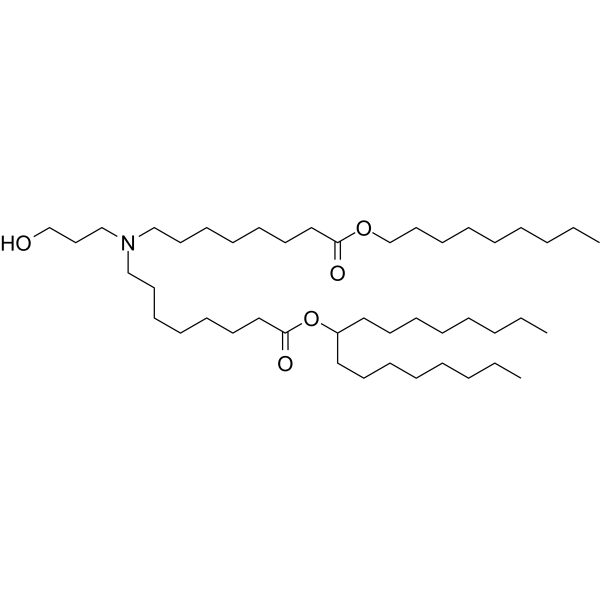
-
- HY-W094581
-
|
|
Biochemical Assay Reagents
|
Others
|
|
Gold (III) chloride trihydrate is a reducing agent. Gold (III) chromium trihydrate can be used for chemical synthesis of gold nanoparticles (NP) and spirochromene derivatives .
|
-
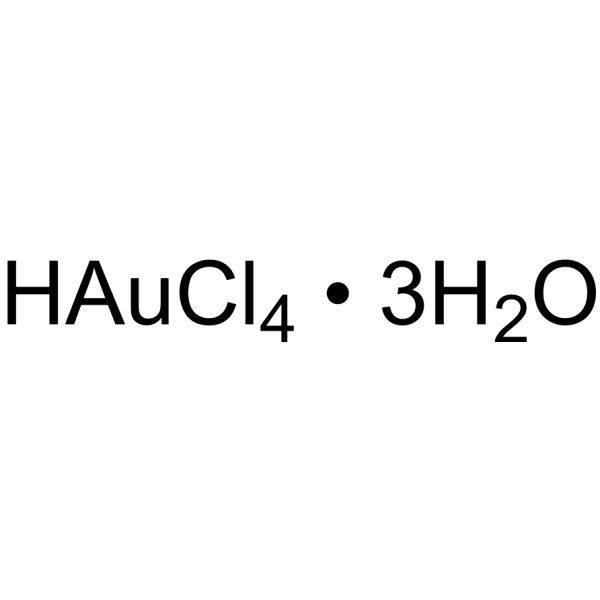
-
- HY-108932A
-
|
Gemcitabine 5′-phosphate disodium
|
Apoptosis
|
Cancer
|
|
Gemcitabine monophosphate (Gemcitabine 5′-phosphate) disodium can be used to synthesis nanoparticles. Gemcitabine monophosphate disodium is one of the active intermediates of Gemcitabine (HY-17026). Gemcitabine monophosphate disodium can be used for bladder cancer research .
|
-
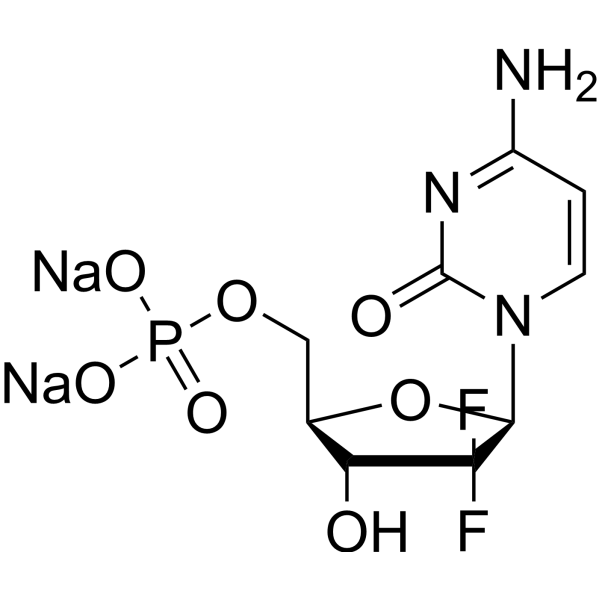
-
- HY-151507
-
|
|
Liposome
|
Others
|
|
306Oi10 is a branched-chain ionizable lipidoid that can be used for constructing lipid nanoparticles (LNPs) for the delivery of messenger RNA .
|
-
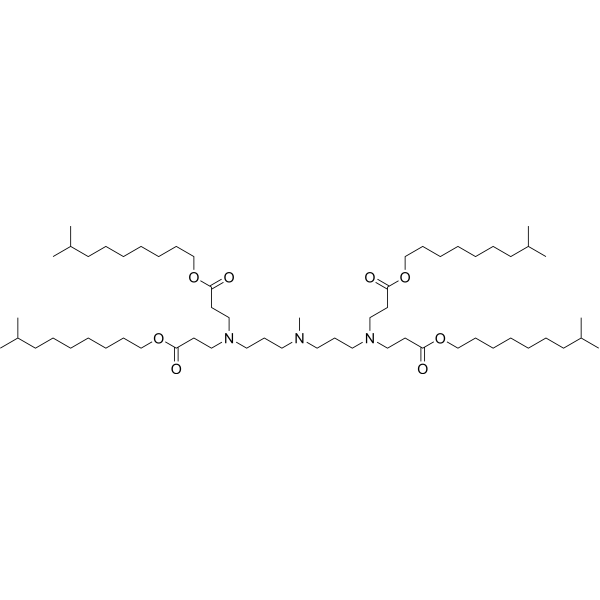
-
- HY-148033
-
|
N,N,N-Trimethylchitosan
|
Others
|
Others
|
|
Trimethyl chitosan (N,N,N-Trimethylchitosan) is a water-soluble multifunctional polymer which is a Chitosan (HY-B2144A) derivative. Trimethyl chitosan can be used for drug delivery and to synthesize nanoparticles .
|
-
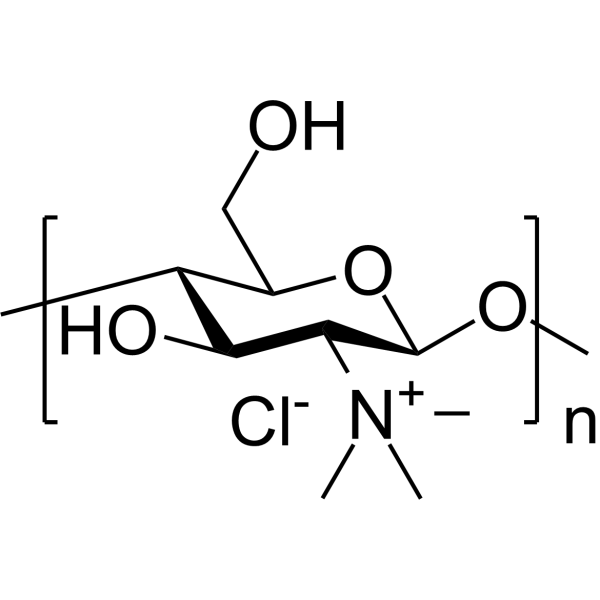
-
- HY-138170
-
ALC-0315
Maximum Cited Publications
7 Publications Verification
|
Liposome
SARS-CoV
|
Infection
|
|
ALC-0315 is an ionisable aminolipid that is responsible for mRNA compaction and aids mRNA cellular delivery and its cytoplasmic release through suspected endosomal destabilization. ALC-0315 can be used to form lipid nanoparticle (LNP) delivery vehicles. Lipid-Nanoparticles have been used in the research of mRNA COVID-19 vaccine .
|
-
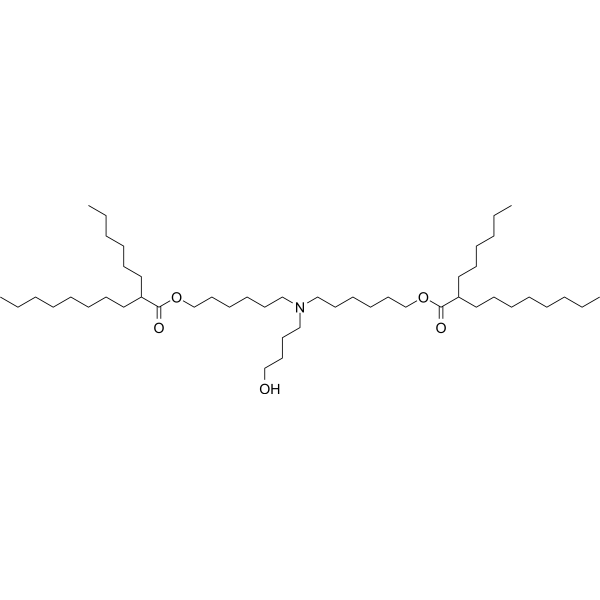
-
- HY-153375
-
|
|
Liposome
|
Others
|
|
LNP Lipid-5 (Compound Lipid 2) is an ionizable lipid (amino lipid). LNP Lipid-5 can be used to prepare lipid nanoparticles (LNP) .
|
-

-
- HY-153376
-
|
|
Liposome
|
Others
|
|
LNP Lipid-6 (Compound Lipid 5) is an ionizable lipid (amino lipid). LNP Lipid-6 can be used to prepare lipid nanoparticles (LNP) .
|
-
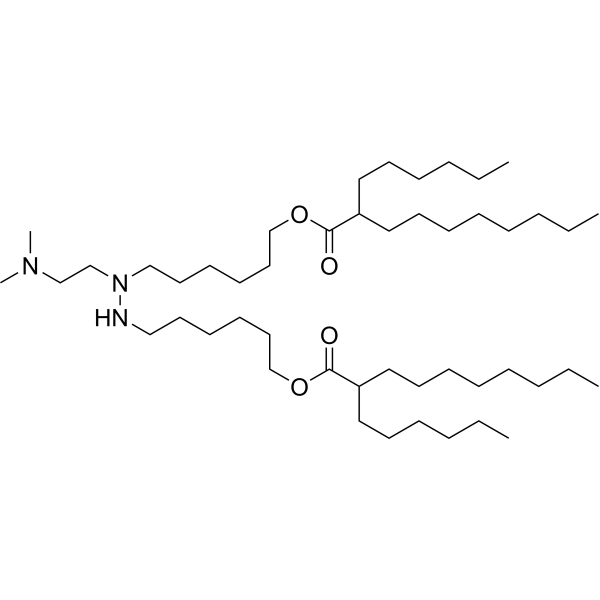
-
- HY-160045
-
|
|
Cholecystokinin Receptor
|
Cancer
|
|
AP1153 aptamer sodium is a DNA aptamer that specifically binds to the cholecystokinin receptor CCKBR (Kd: ~15 pM), but does not activate CCKBR-related signaling pathways. AP1153 aptamer sodium is internalized by pancreatic ductal adenocarcinoma (PDAC) cells in a receptor-mediated manner. AP1153 aptamer sodium can bioconjugate to the surface of fluorescent nanoparticles to facilitate nanoparticle delivery to PDAC tumors in vivo .
|
-
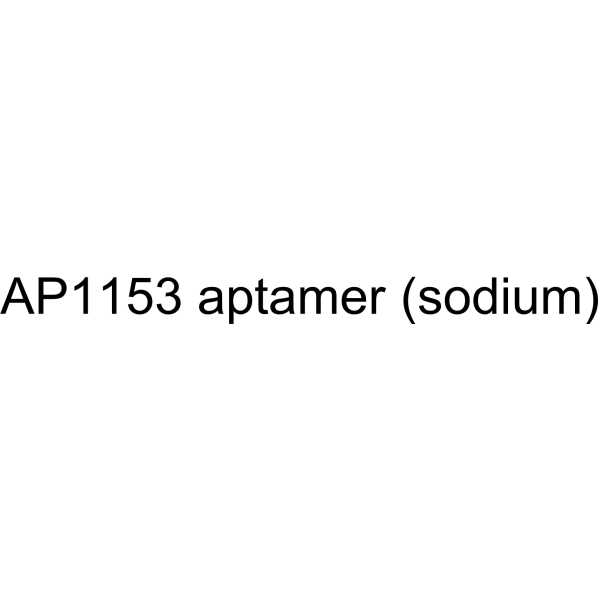
-
- HY-160439
-
|
|
Liposome
|
Others
|
|
Ionizable lipid-2 (compound 1) is an ionizable lipid used for nucleic acid delivery and construct lipid nanoparticles (LNPs) .
|
-
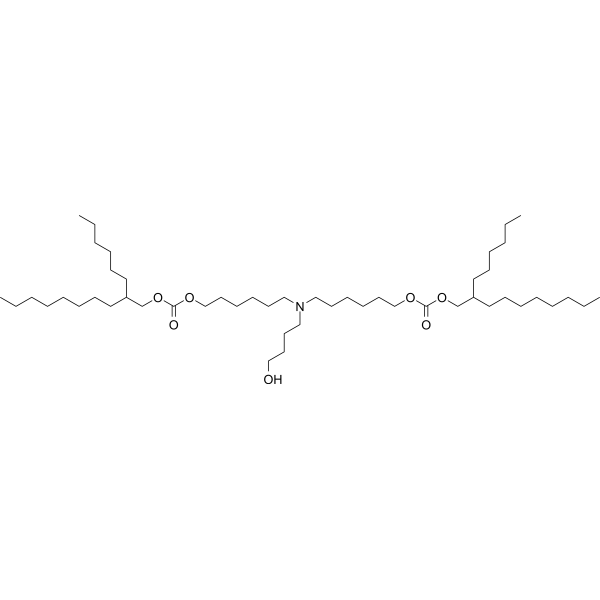
-
- HY-148363
-
|
|
Liposome
|
Inflammation/Immunology
|
|
Heptadecan-9-yl 8-((6-(decyloxy)-6-oxohexyl)(2-hydroxyethyl)amino)octanoate can be used in lipid nanoparticles (LNP) delivery systems for mRNA vaccine delivery .
|
-
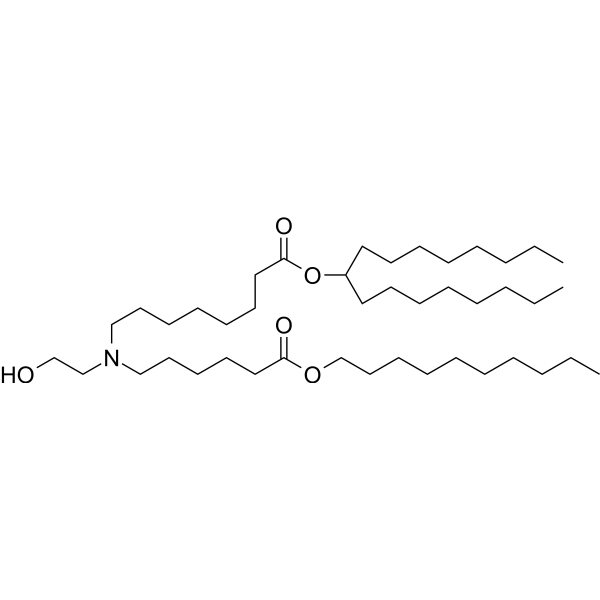
-
- HY-155902B
-
|
Maleimide-PEG-Hydroxy (MW 1000)
|
Liposome
|
Others
|
|
Mal-PEG-OH (MW 1000) was used as a macroinitiator to obtain amphiphilic diblock copolymers by ring-opening polymerization of LA. Nanoparticles prepared using amphiphilic block copolymers can form active drug delivery systems. Nanoparticles encapsulate Triptolide (HY-32735), which can avoid the disadvantage of Triptolide’s poor water solubility and reduce its toxicity.
|
-
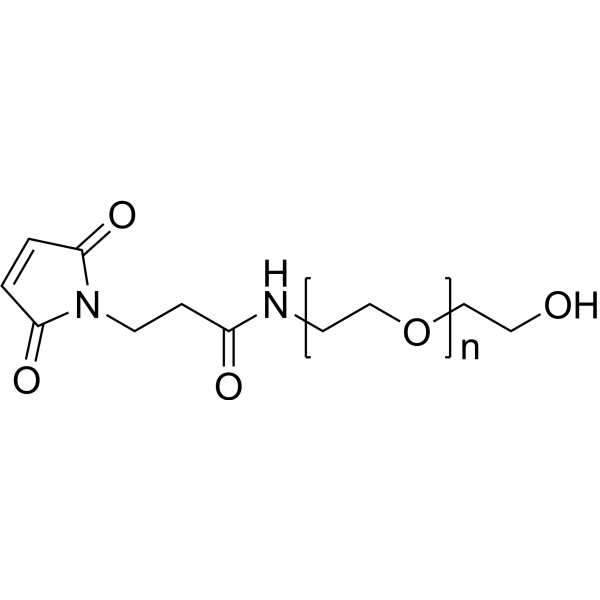
-
- HY-W440835
-
|
|
Liposome
|
Others
|
|
DSPE-PEG-DBCO, MW 2000 is a phospholipid-PEG polymer that can be used to form micelles as lipid nanoparticles for drug delivery . DSPE-PEG-DBCO, MW 2000 is a click chemistry reagent, it contains a DBCO group that can undergo strain-promoted alkyne-azide cycloaddition (SPAAC) with molecules containing Azide groups.
|
-
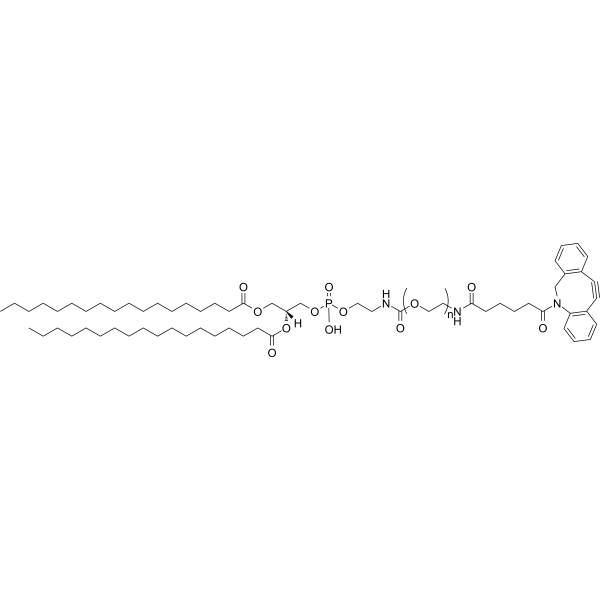
-
- HY-155902
-
|
Maleimide-PEG-Hydroxy (MW 5000)
|
Liposome
|
Others
|
|
Mal-PEG-OH (MW 5000) can be used as a macroinitiator to obtain amphiphilic diblock copolymers by ring-opening polymerization of LA. Nanoparticles prepared using amphiphilic block copolymers can form active drug delivery systems. Nanoparticles encapsulate Triptolide (HY-32735), which can avoid the disadvantage of Triptolide’s poor water solubility and reduce its toxicity.
|
-
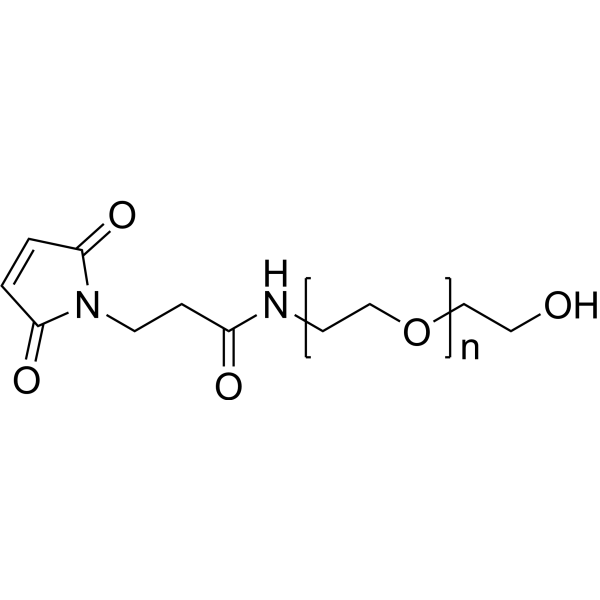
-
- HY-155902A
-
|
Maleimide-PEG-Hydroxy (MW 2000)
|
Liposome
|
Others
|
|
Mal-PEG-OH (MW 2000) can be used as a macroinitiator to obtain amphiphilic diblock copolymers by ring-opening polymerization of LA. Nanoparticles prepared using amphiphilic block copolymers can form active drug delivery systems. Nanoparticles encapsulate Triptolide (HY-32735), which can avoid the disadvantage of Triptolide’s poor water solubility and reduce its toxicity.
|
-
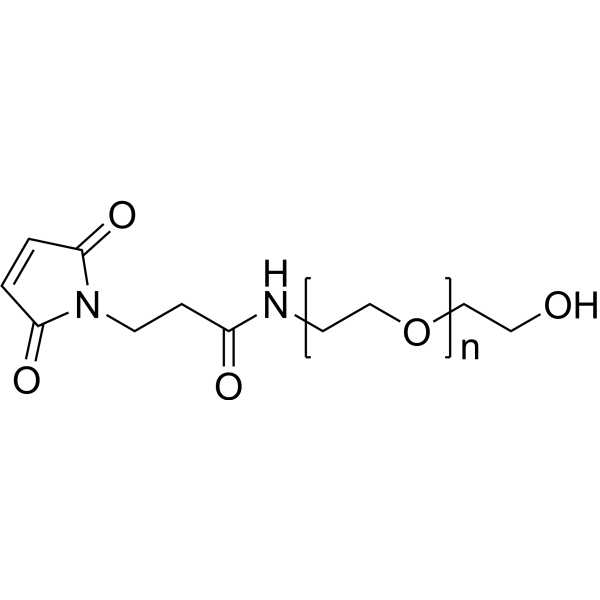
-
- HY-W441002
-
|
|
Liposome
|
Others
|
|
DSPE-succinic acid is a phophalipid capped with a carboxylic acid moiety. The carboxylic acid moiety is reactive with amine to from a stable amide linkage. DSPE-succinic acid can be used to prepare nanoparticles or liposomes for agent nanocarrier to deliver therapeutics .
|
-
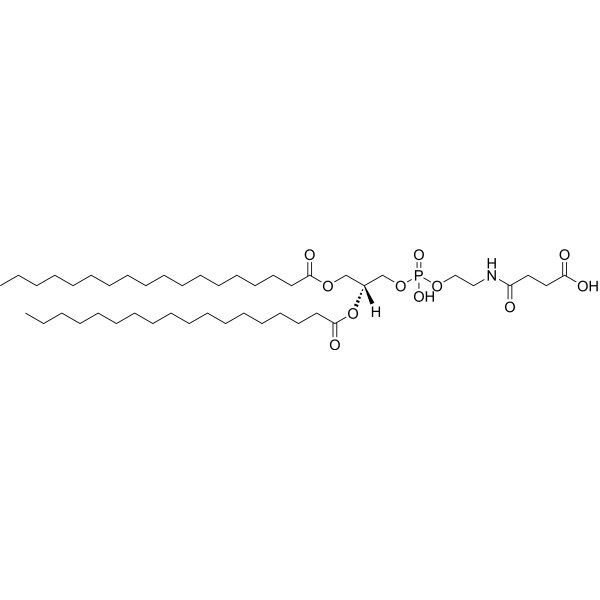
-
- HY-112752
-
|
|
Liposome
|
Others
|
|
Gal-C4-Chol is a glycosylated cholesterol derivative. Gal-C4-Chol can be used as a ligand for asialoglycoprotein receptors (ASGPR) to prepare Galactosylated (Gal) liposomes. Gal-C4-Chol can be used to prepare simple lipid-based nanoparticles .
|
-
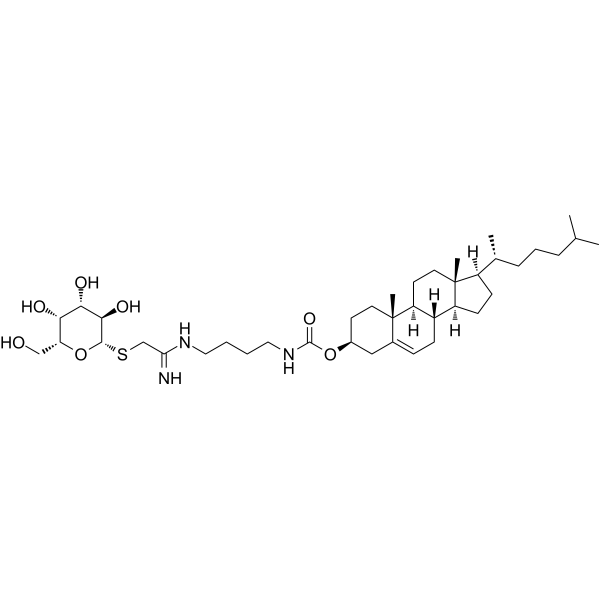
-
- HY-125924
-
|
DSPE-PEG-NH2, MW 2000 ammonium
|
Liposome
|
Others
|
|
DSPE-PEG-Amine, MW 2000 (ammonium), an amine derivative of phospholipid poly ethylene glycol, is used in the synthesis of solid lipid and thermosensitive liposomal nanoparticles for the delivery of anticancer agents .
|
-
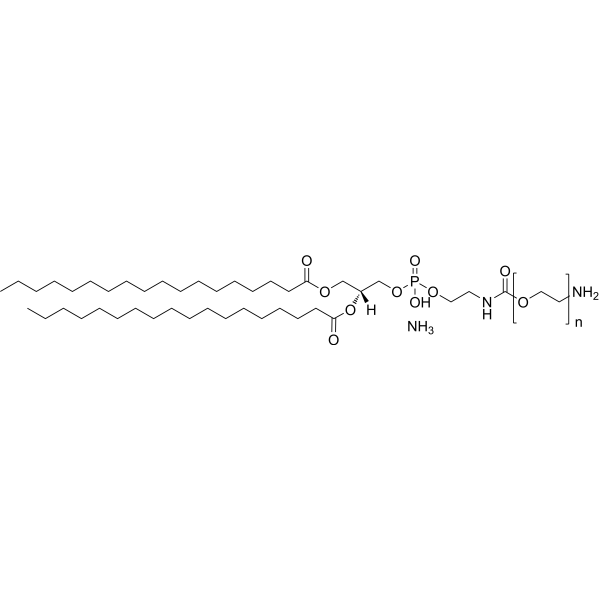
-
- HY-136304
-
-
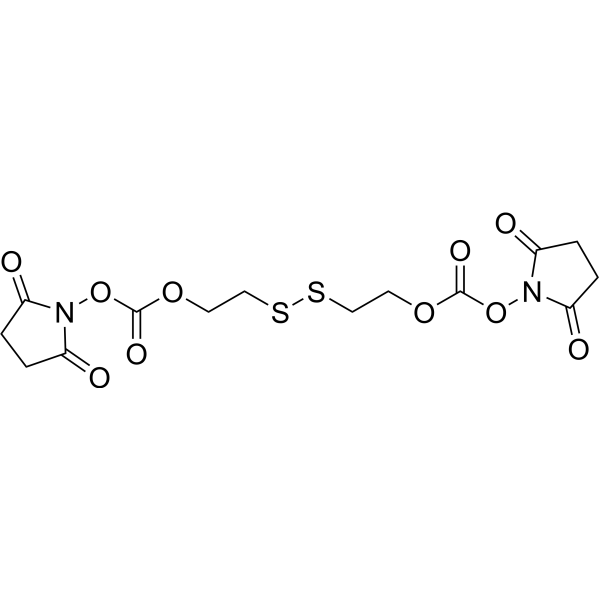
-
- HY-112760
-
|
DSPE-mPEG2000 sodium; 1,2-Distearoyl-sn-glycero-3-phosphoethanolamine-N-[methoxy(polyethylene glycol)-2000] sodium
|
Liposome
|
Cancer
|
|
18:0 mPEG2000 PE sodium can be used for the preparation of stabilized nucleic acid-lipid particllipid particles (SNALPs). SNALPs represent some of the earliest and best functional siRNA-ABC nanoparticles described .
|
-
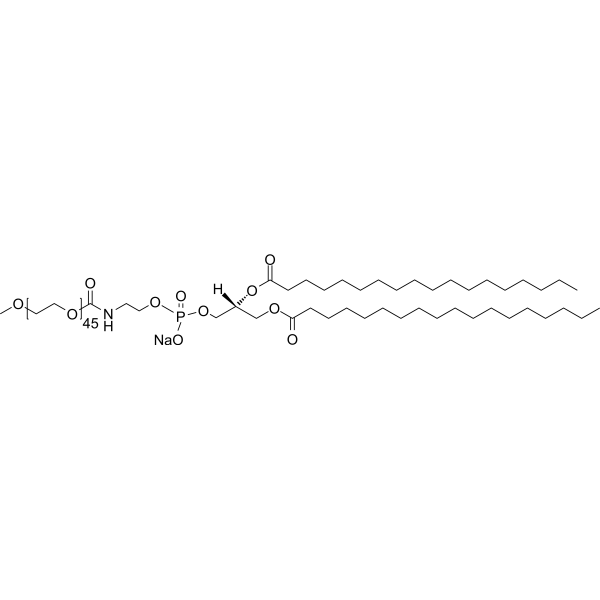
-
- HY-112764
-
|
|
Liposome
|
Metabolic Disease
|
|
DMG-PEG 2000 is used for the preparation of liposome for siRNA delivery with improved transfection efficiency in vitro. DMG-PEG 2000 is also used for the lipid nanoparticle for an oral plasmid DNA delivery approach in vivo through a facile surface modification to improve the mucus permeability and delivery efficiency of the nanoparticles .
|
-

-
- HY-139306
-
|
|
Liposome
|
Inflammation/Immunology
|
|
BAMEAO16B is a lipid nanoparticle. BAMEAO16B integrated with disulfide bonds, can efficiently deliver Cas9 mRNA and sgRNA into cells while releasing RNA in response to the reductive intracellular environment for genome editing. BAMEAO16B can be used for the research of gene editing .
|
-
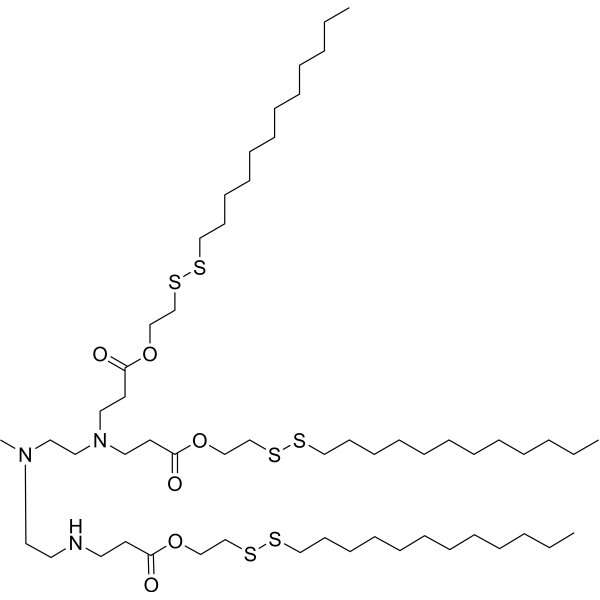
-
- HY-157252
-
|
|
Liposome
|
Cancer
|
|
CL4F8-6 is an ionizable cationic lipid with a pKa of 6.14. CL4F8-6 can be used in lipid nanoparticles (LNPs)-based mRNA therapeutics. CL4F8-6 LNPs carrying Cas9 mRNA and sgRNA could induce CRISPR-mediated gene knockdown in mice .
|
-
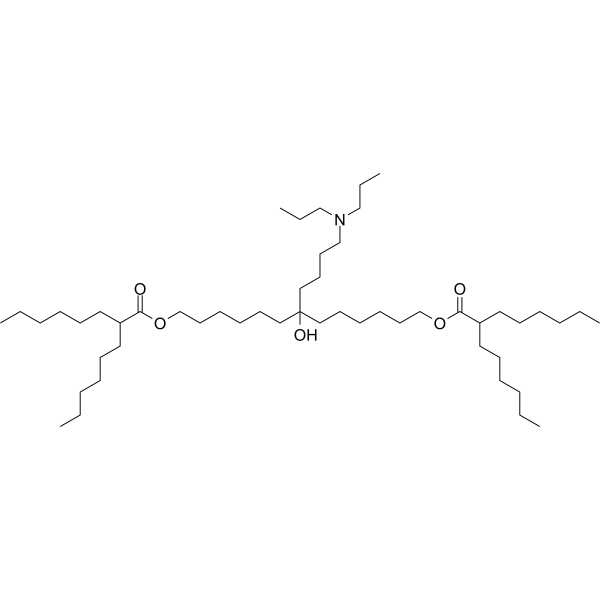
-
- HY-D0917
-
|
|
DNA Stain
|
Cancer
|
|
TO-PRO 1 is a DNA binding fluorochrome, that atached to the surface of the Feraheme (FH) nanoparticle (NP), to obtain a fluorochrome-functionalized NP. TO-PRO 1 binds DNA through intercalation, and acts as a vital fluorochrome for necrotic cells .
|
-
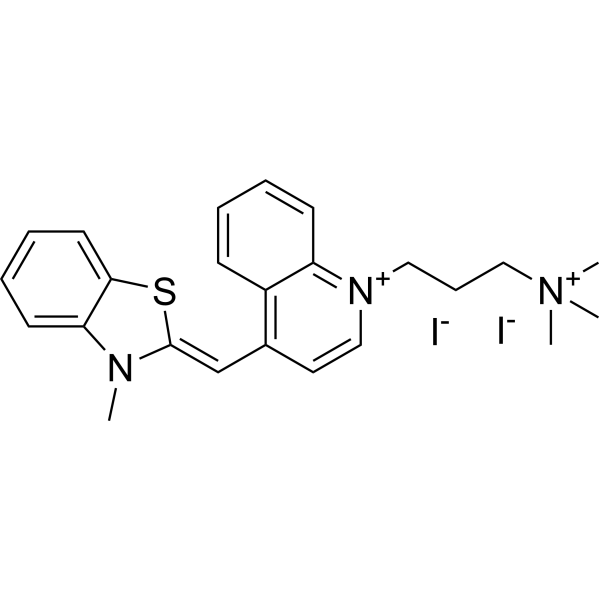
-
- HY-151508
-
|
|
Liposome
|
Cancer
|
|
Diamino lipid DAL4 is diamino lipid for the preparation of lipid nanoparticles (LNPs) encapsulated with mRNAs encoding cytokines including IL-12, IL-27 and GM-CSF. Diamino lipid DAL4 delivers mRNA to tumor cells to exert anti-tumor activity .
|
-
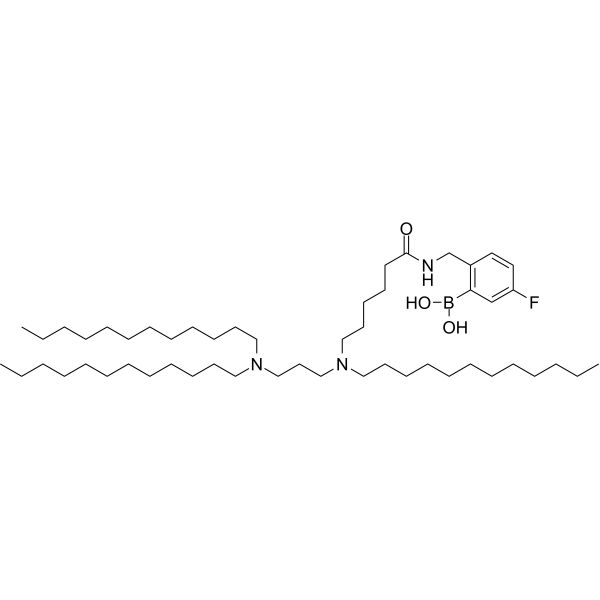
-
- HY-156985
-
|
|
Isotope-Labeled Compounds
Liposome
|
Others
|
|
Lipid AX4 is an ionizable cationic lipid with the pKa of 6.89, and can be used the study for the formation of lipid nanoparticles (LNPs) for the delivery of mRNA in vivo .
|
-
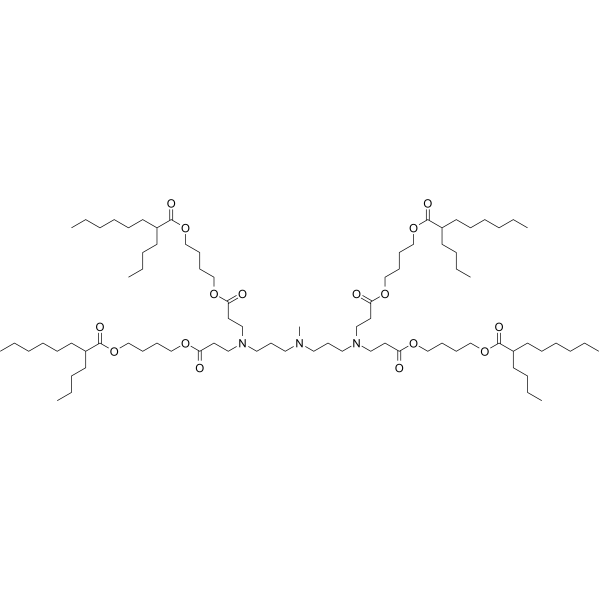
-
- HY-N6613
-
|
Galacturonic acid polymer
|
Others
|
Infection
Inflammation/Immunology
|
|
Polygalacturonic acid (Galacturonic acid polymer) is transparent colloid, is a major component of the cell wall. Polygalacturonic acid can be used to prepare silver nanoparticles (AgNPs), as an antioxidant and anti-inflammatory that protect cells from destructive effect of elevated ROS and accelerate wound healing. Polygalacturonic acid nanoparticles also displays anti-bacterial activity .
|
-
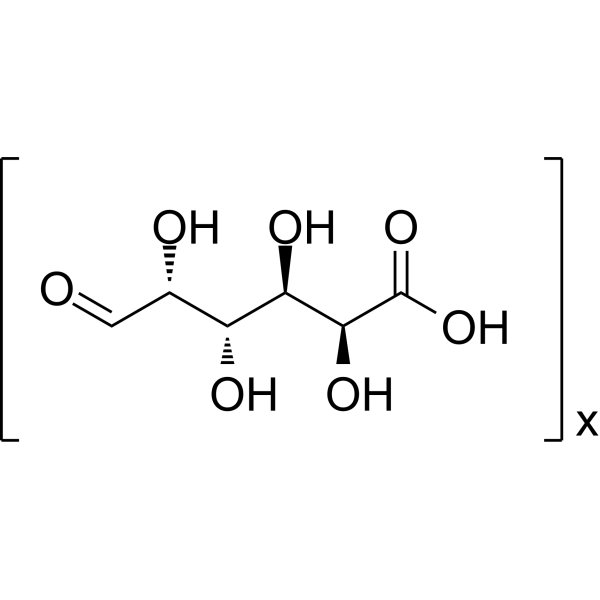
-
- HY-W414069
-
|
|
Endogenous Metabolite
Liposome
|
Others
|
|
Thiocholesterol is a member of the class of cholesteric liquid crystals (CLCs) that can be used to synthesis cationic lipid. Thiocholesterol is a stronger stabilizer of silver nanoparticles (SNPs). Thiocholesterol can be used for plasma membrane research and drug delivery .
|
-

-
- HY-N2362
-
|
DL-2-Aminopropionic acid
|
Endogenous Metabolite
|
Metabolic Disease
|
|
DL-alanine, an orally active amino acid, is the racemic compound of L- and D-alanine. DL-alanine is employed both as a reducing and a capping agent, used with silver nitrate aqueous solutions for the production of nanoparticles. DL-alanine can be used for the research of transition metals chelation, such as Cu(II), Zn(II), Cd(11). DL-alanine, a sweetener, is classed together with glycine and sodium saccharin. DL-alanine plays a key role in the glucose-alanine cycle between tissues and liver .
|
-
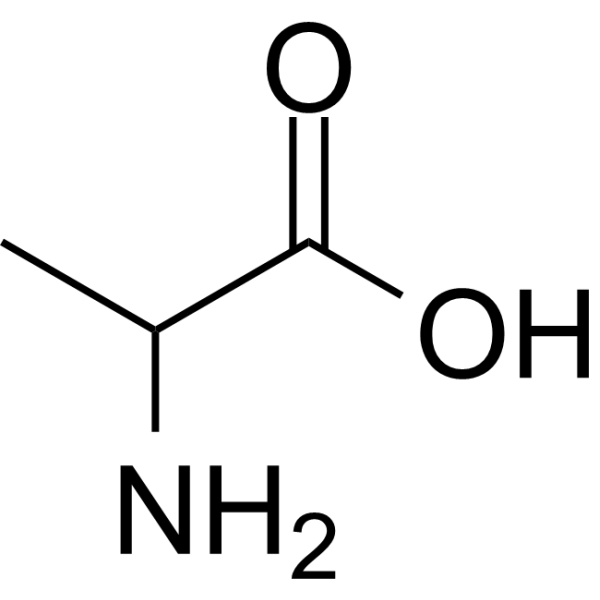
-
- HY-160552
-
|
|
Liposome
|
Others
|
|
244cis, a piperazine-containing ionizable cationic lipid, has been used to generate lipid nanoparticles (LNPs). LNPs containing 244cis and coated with mRNA reporter gene were specifically accumulated in mouse lungs compared with LNPs containing SM-102. Induces a decrease in serum chemokine (C-C motif) ligand 2 (CCL2) levels .
|
-
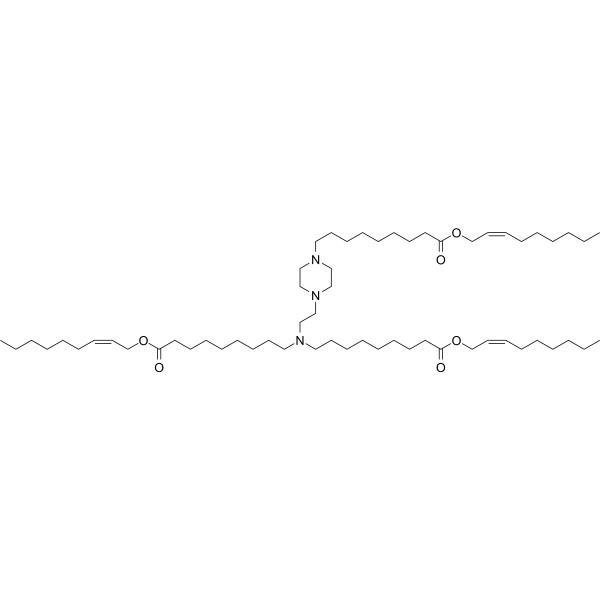
-
- HY-P4115
-
|
|
FABP
|
Cancer
|
|
CooP is a linear glioblastoma-targeting nonapeptide. CooP binds to the mammary-derived growth inhibitor/fatty acid binding protein 3 (FABP3) in the glioblastoma cells and its associated vasculature. CooP is used for the targeted delivery of chemotherapy and different nanoparticles .
|
-

-
- HY-D1540
-
|
Cy 5.5 amine; Lumiprobe Cy 5.5 amine
|
Fluorescent Dye
|
Others
|
|
Cyanine5.5 amine (Cy 5.5 amine), a Cy5.5 Analogue, is a near-infrared (NIR) fluorescent dye (Ex=648 nm, Em=710 nm). Cyanine5.5 amine can be used in the preparation of Cy5.5-labeled nanoparticles, which can be tracked and imaged with low fluorescence background using confocal microscopy .
|
-
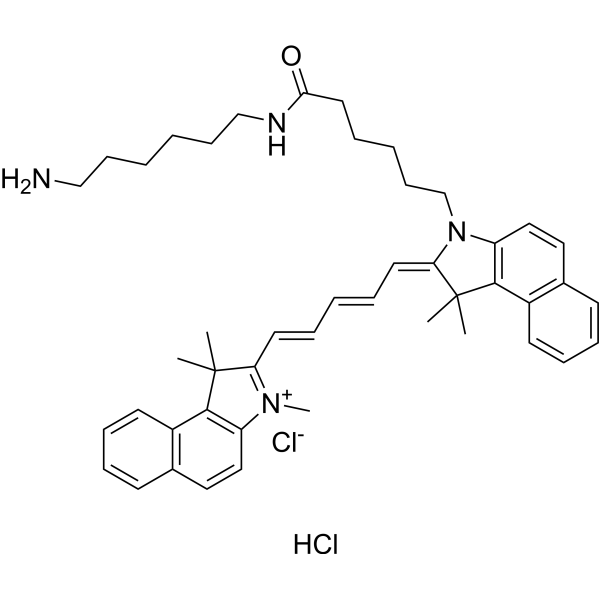
-
- HY-154974
-
|
|
Liposome
|
Cancer
|
|
LNP Lipid-8 (11-A-M) is an ionizable lipid, which can be used for lipid nanoparticles (LNP) to deliver siRNA to T cells without targeting to ligands. LNP LIPs-8 loaded with GFP siRNA (siGFP), and significantly causes GFP gene silencing in mice model .
|
-

-
- HY-W145518
-
|
|
Endogenous Metabolite
Bacterial
Antibiotic
|
Infection
|
|
Pectin is a heteropolysaccharide, derived from the cell wall of higher plants. Pectin involves in the formation of nanoparticles as a delivery vehicle of agents. Pectin is also an adsorbent, a broad-spectrum antimicrobial agent that binds to bacteria toxins and other irritants in the intestinal mucosa, relieves irritated mucosa .
|
-
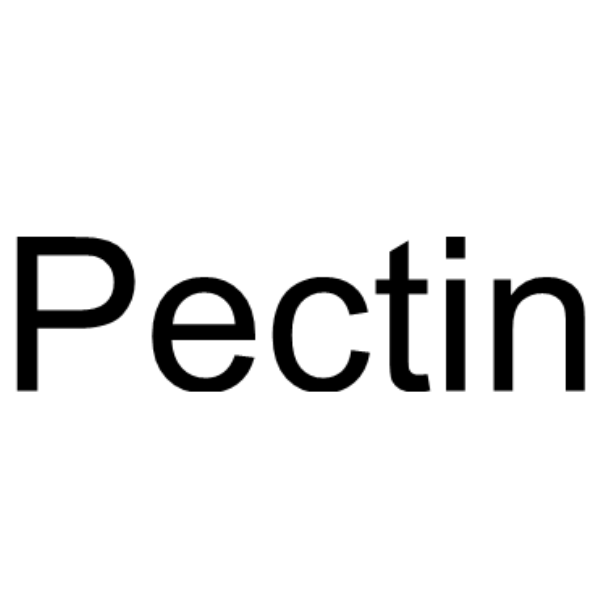
-
- HY-113217
-
|
|
Liposome
Endogenous Metabolite
|
Others
|
|
Cholesteryl oleate is an esterified form of Cholesterol. Cholesteryl oleate can be used in the generation of solid lipid nanoparticle (SLN, a nanoparticle-based method for gene therapy) .
|
-
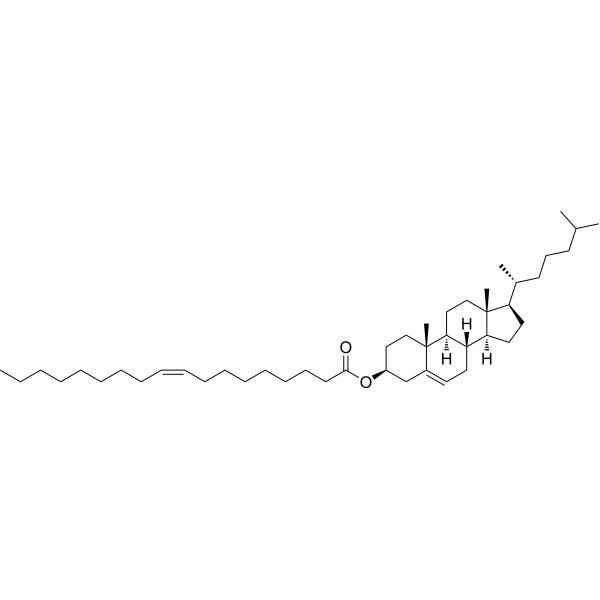
-
- HY-144012A
-
|
DPPE-PEG350; 1,2-Dipalmitoyl-sn-glycero-3-phosphoethanolamine-N-[methoxy(polyethylene glycol)-350] ammonium
|
Liposome
|
Others
|
|
16:0 PEG350 PE is a PEG lipid functional end group used in the synthesis of liposomes (LPs) for the design of conjugated polymer nanoparticles. Through biotin modification and carboxyl terminus, lipid nanoparticles (LNPs) further coupling with other biomolecules can be achieved. Functionalized nanoparticles can be used for targeted labeling of specific cellular proteins. With streptavidin as a linker, biotinylated PEG lipid-conjugated polymer nanoparticles are able to bind to biotinylated antibodies on cell surface receptors, yielding the utility of fluorescence-based imaging and sensing.
|
-
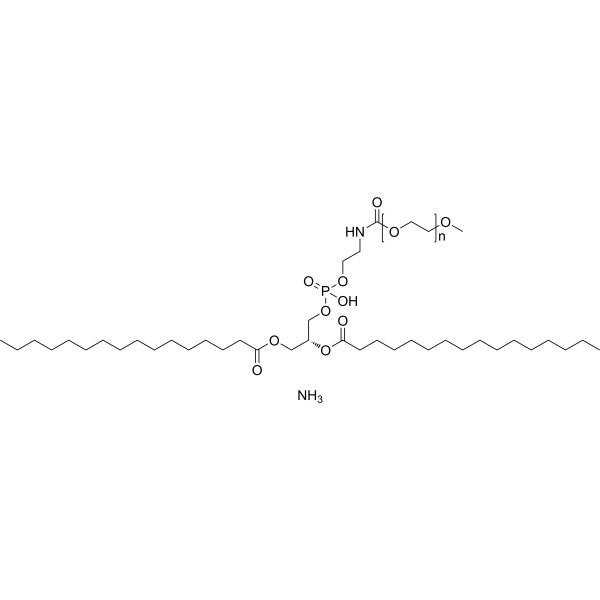
-
- HY-144012B
-
|
DPPE-PEG550; 1,2-Dipalmitoyl-sn-glycero-3-phosphoethanolamine-N-[methoxy(polyethylene glycol)-550] ammonium
|
Biochemical Assay Reagents
Liposome
|
Others
|
|
16:0 PEG550 PE is a PEG lipid functional end group used in the synthesis of liposomes (LPs) for the design of conjugated polymer nanoparticles. Through biotin modification and carboxyl terminus, lipid nanoparticles (LNPs) further coupling with other biomolecules can be achieved. Functionalized nanoparticles can be used for targeted labeling of specific cellular proteins. With streptavidin as a linker, biotinylated PEG lipid-conjugated polymer nanoparticles are able to bind to biotinylated antibodies on cell surface receptors, yielding the utility of fluorescence-based imaging and sensing.
|
-
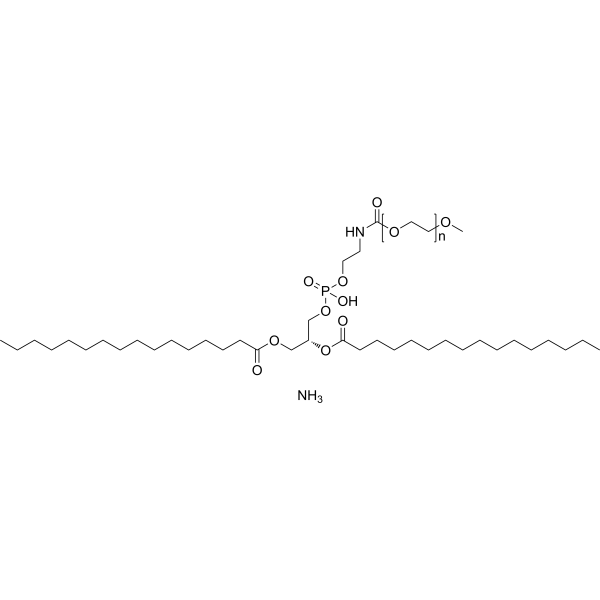
-
- HY-144012C
-
|
DPPE-PEG750; 1,2-Dipalmitoyl-sn-glycero-3-phosphoethanolamine-N-[methoxy(polyethylene glycol)-750] ammonium
|
Biochemical Assay Reagents
Liposome
|
Others
|
|
16:0 PEG750 PE is a PEG lipid functional end group used in the synthesis of liposomes (LPs) for the design of conjugated polymer nanoparticles. Through biotin modification and carboxyl terminus, lipid nanoparticles (LNPs) further coupling with other biomolecules can be achieved. Functionalized nanoparticles can be used for targeted labeling of specific cellular proteins. With streptavidin as a linker, biotinylated PEG lipid-conjugated polymer nanoparticles are able to bind to biotinylated antibodies on cell surface receptors, yielding the utility of fluorescence-based imaging and sensing.
|
-

- HY-144013A
-
|
DSPE-mPEG350 ammonium; 1,2-Distearoyl-sn-glycero-3-phosphoethanolamine-N-[methoxy(polyethylene glycol)-350] ammonium
|
Liposome
|
Others
|
|
18:0 mPEG350 PE (ammonium) is a PEG lipid functional end group used in the synthesis of liposomes (LPs) for the design of conjugated polymer nanoparticles. Through biotin modification and carboxyl terminus, lipid nanoparticles (LNPs) further coupling with other biomolecules can be achieved. Functionalized nanoparticles can be used for targeted labeling of specific cellular proteins. With streptavidin as a linker, biotinylated PEG lipid-conjugated polymer nanoparticles are able to bind to biotinylated antibodies on cell surface receptors, yielding the utility of fluorescence-based imaging and sensing.
|
-
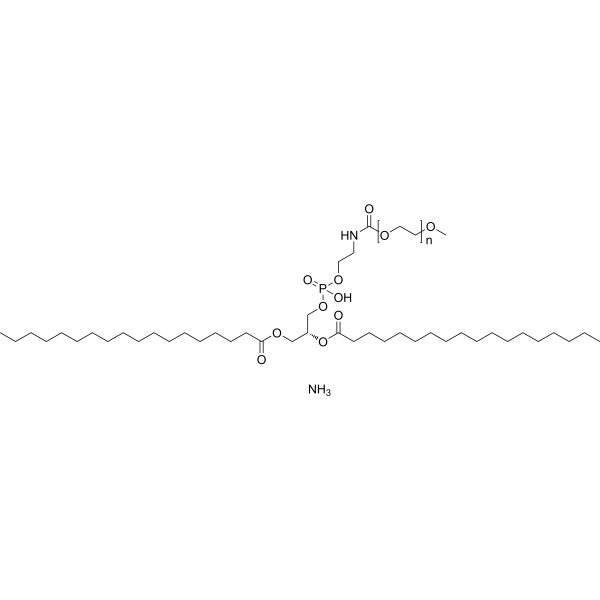
- HY-144013B
-
|
DSPE-mPEG550 ammonium; 1,2-Distearoyl-sn-glycero-3-phosphoethanolamine-N-[methoxy(polyethylene glycol)-550] ammonium
|
Biochemical Assay Reagents
Liposome
|
Others
|
|
18:0 mPEG550 PE (ammonium) is a PEG lipid functional end group used in the synthesis of liposomes (LPs) for the design of conjugated polymeric nanoparticles. Through biotin modification and carboxyl terminus, lipid nanoparticles (LNPs) further coupling with other biomolecules can be achieved. Functionalized nanoparticles can be used for targeted labeling of specific cellular proteins. With streptavidin as a linker, biotinylated PEG lipid-conjugated polymer nanoparticles are able to bind to biotinylated antibodies on cell surface receptors, yielding the utility of fluorescence-based imaging and sensing.
|
-

- HY-144013C
-
|
DSPE-mPEG750 ammonium; 1,2-Distearoyl-sn-glycero-3-phosphoethanolamine-N-[methoxy(polyethylene glycol)-750] ammonium
|
Biochemical Assay Reagents
Liposome
|
Others
|
|
18:0 mPEG750 PE (ammonium) is a PEG lipid functional end group used in the synthesis of liposomes (LPs) for the design of conjugated polymeric nanoparticles. Through biotin modification and carboxyl terminus, lipid nanoparticles (LNPs) further coupling with other biomolecules can be achieved. Functionalized nanoparticles can be used for targeted labeling of specific cellular proteins. With streptavidin as a linker, biotinylated PEG lipid-conjugated polymer nanoparticles are able to bind to biotinylated antibodies on cell surface receptors, yielding the utility of fluorescence-based imaging and sensing.
|
-
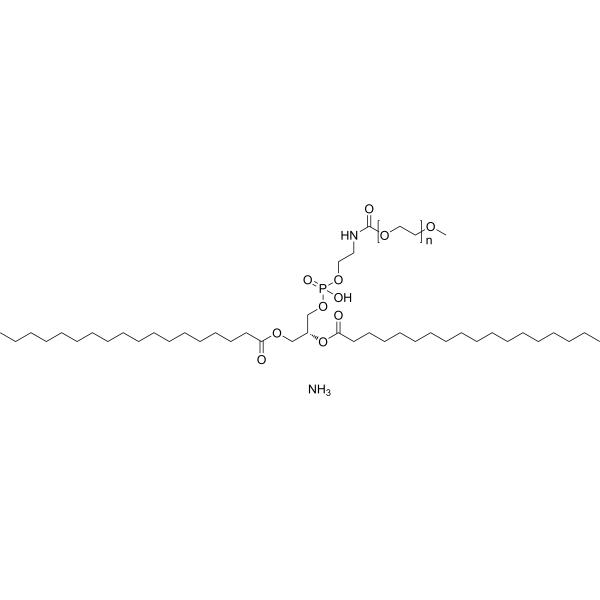
- HY-144012D
-
|
DPPE-PEG1000; 1,2-Dipalmitoyl-sn-glycero-3-phosphoethanolamine-N-[methoxy(polyethylene glycol)-1000] ammonium
|
Liposome
|
Others
|
|
16:0 PEG1000 PE is a PEG lipid functional end group used in the synthesis of liposomes (LPs) for the design of conjugated polymer nanoparticles. Through biotin modification and carboxyl terminus, lipid nanoparticles (LNPs) further coupling with other biomolecules can be achieved. Functionalized nanoparticles can be used for targeted labeling of specific cellular proteins. With streptavidin as a linker, biotinylated PEG lipid-conjugated polymer nanoparticles are able to bind to biotinylated antibodies on cell surface receptors, yielding the utility of fluorescence-based imaging and sensing.
|
-

- HY-144012E
-
|
DPPE-PEG3000; 1,2-Dipalmitoyl-sn-glycero-3-phosphoethanolamine-N-[methoxy(polyethylene glycol)-3000] ammonium
|
Liposome
|
Others
|
|
16:0 PEG3000 PE is a PEG lipid functional end group used in the synthesis of liposomes (LPs) for the design of conjugated polymer nanoparticles. Through biotin modification and carboxyl terminus, lipid nanoparticles (LNPs) further coupling with other biomolecules can be achieved. Functionalized nanoparticles can be used for targeted labeling of specific cellular proteins. With streptavidin as a linker, biotinylated PEG lipid-conjugated polymer nanoparticles are able to bind to biotinylated antibodies on cell surface receptors, yielding the utility of fluorescence-based imaging and sensing.
|
-
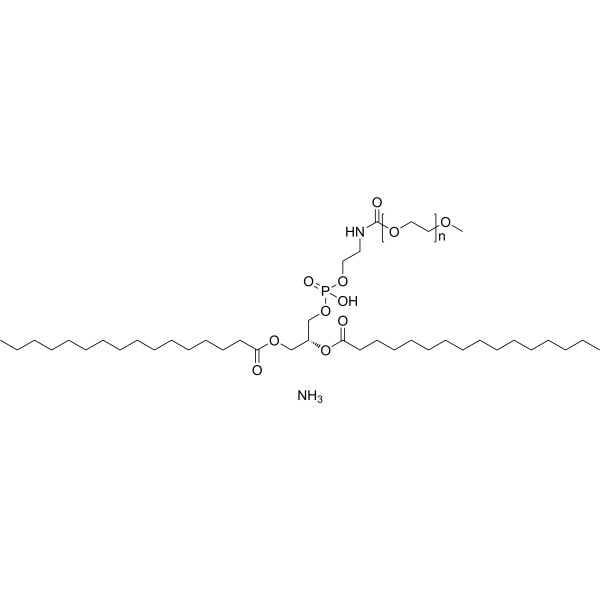
- HY-144012H
-
|
DPPE-PEG5000; 1,2-Dipalmitoyl-sn-glycero-3-phosphoethanolamine-N-[methoxy(polyethylene glycol)-5000] ammonium
|
Liposome
|
Others
|
|
16:0 PEG5000 PE is a PEG lipid functional end group used in the synthesis of liposomes (LPs) for the design of conjugated polymer nanoparticles. Through biotin modification and carboxyl terminus, lipid nanoparticles (LNPs) further coupling with other biomolecules can be achieved. Functionalized nanoparticles can be used for targeted labeling of specific cellular proteins. With streptavidin as a linker, biotinylated PEG lipid-conjugated polymer nanoparticles are able to bind to biotinylated antibodies on cell surface receptors, yielding the utility of fluorescence-based imaging and sensing.
|
-
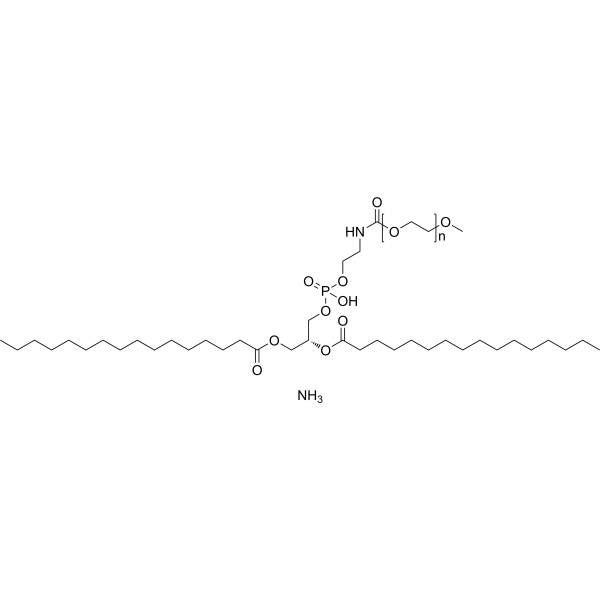
- HY-144013D
-
|
DSPE-mPEG1000 ammonium; 1,2-Distearoyl-sn-glycero-3-phosphoethanolamine-N-[methoxy(polyethylene glycol)-1000] ammonium
|
Liposome
|
Others
|
|
18:0 mPEG1000 PE (ammonium) is a PEG lipid functional end group used in the synthesis of liposomes (LPs) for the design of conjugated polymeric nanoparticles. Through biotin modification and carboxyl terminus, lipid nanoparticles (LNPs) further coupling with other biomolecules can be achieved. Functionalized nanoparticles can be used for targeted labeling of specific cellular proteins. With streptavidin as a linker, biotinylated PEG lipid-conjugated polymer nanoparticles are able to bind to biotinylated antibodies on cell surface receptors, yielding the utility of fluorescence-based imaging and sensing.
|
-
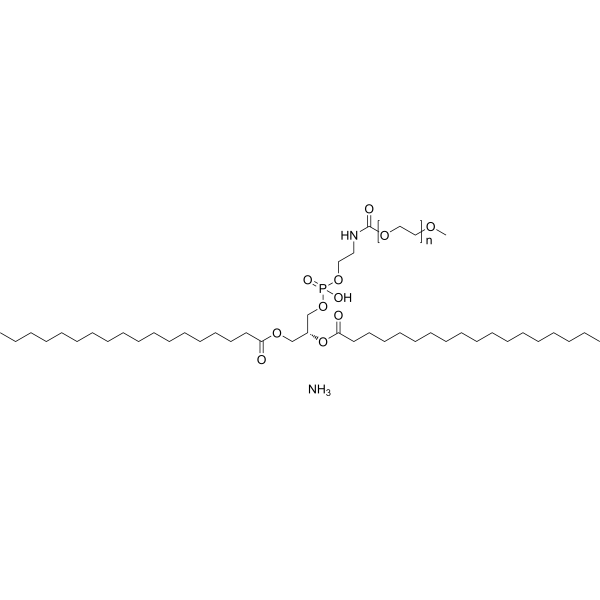
- HY-144013E
-
|
DSPE-mPEG3000 ammonium; 1,2-Distearoyl-sn-glycero-3-phosphoethanolamine-N-[methoxy(polyethylene glycol)-3000] ammonium
|
Liposome
|
Others
|
|
18:0 mPEG3000 PE (ammonium) is a PEG lipid functional end group used in the synthesis of liposomes (LPs) for the design of conjugated polymeric nanoparticles. Through biotin modification and carboxyl terminus, lipid nanoparticles (LNPs) further coupling with other biomolecules can be achieved. Functionalized nanoparticles can be used for targeted labeling of specific cellular proteins. With streptavidin as a linker, biotinylated PEG lipid-conjugated polymer nanoparticles are able to bind to biotinylated antibodies on cell surface receptors, yielding the utility of fluorescence-based imaging and sensing.
|
-

- HY-144013H
-
|
DSPE-mPEG5000 ammonium; 1,2-Distearoyl-sn-glycero-3-phosphoethanolamine-N-[methoxy(polyethylene glycol)-5000] ammonium
|
Liposome
|
Others
|
|
18:0 mPEG5000 PE (ammonium) is a PEG lipid functional end group used in the synthesis of liposomes (LPs) for the design of conjugated polymeric nanoparticles. Through biotin modification and carboxyl terminus, lipid nanoparticles (LNPs) further coupling with other biomolecules can be achieved. Functionalized nanoparticles can be used for targeted labeling of specific cellular proteins. With streptavidin as a linker, biotinylated PEG lipid-conjugated polymer nanoparticles are able to bind to biotinylated antibodies on cell surface receptors, yielding the utility of fluorescence-based imaging and sensing.
|
-
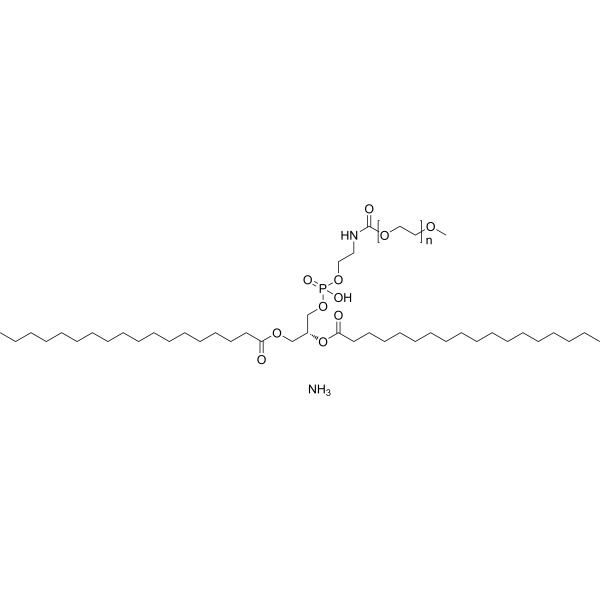
- HY-155924
-
|
DMPE-PEG350; 1,2-Dimyristoyl-sn-glycero-3-phosphoethanolamine-N-[methoxy(polyethylene glycol)-350] ammonium
|
Liposome
|
Others
|
|
14:0 PEG350 PE is a PEG lipid functional end group used in the synthesis of liposomes (LPs) for the design of conjugated polymer nanoparticles. Through biotin modification and carboxyl terminus, lipid nanoparticles (LNPs) further coupling with other biomolecules can be achieved. Functionalized nanoparticles can be used for targeted labeling of specific cellular proteins. With streptavidin as a linker, biotinylated PEG lipid-conjugated polymer nanoparticles are able to bind to biotinylated antibodies on cell surface receptors, yielding the utility of fluorescence-based imaging and sensing.
|
-

- HY-155925
-
|
DMPE-PEG550; 1,2-Dimyristoyl-sn-glycero-3-phosphoethanolamine-N-[methoxy(polyethylene glycol)-550] ammonium
|
Liposome
|
Others
|
|
14:0 PEG550 PE is a PEG lipid functional end group used in the synthesis of liposomes (LPs) for the design of conjugated polymeric nanoparticles. Through biotin modification and carboxyl terminus, lipid nanoparticles (LNPs) further coupling with other biomolecules can be achieved. Functionalized nanoparticles can be used for targeted labeling of specific cellular proteins. With streptavidin as a linker, biotinylated PEG lipid-conjugated polymer nanoparticles are able to bind to biotinylated antibodies on cell surface receptors, yielding the utility of fluorescence-based imaging and sensing.
|
-
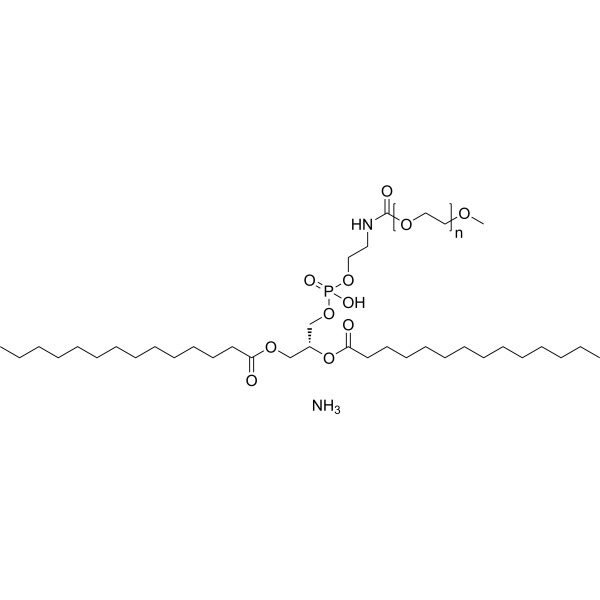
- HY-155926
-
|
DMPE-PEG750; 1,2-Dimyristoyl-sn-glycero-3-phosphoethanolamine-N-[methoxy(polyethylene glycol)-750] ammonium
|
Liposome
|
Others
|
|
14:0 PEG750 PE is a PEG lipid functional end group used in the synthesis of liposomes (LPs) for the design of conjugated polymeric nanoparticles. Through biotin modification and carboxyl terminus, lipid nanoparticles (LNPs) further coupling with other biomolecules can be achieved. Functionalized nanoparticles can be used for targeted labeling of specific cellular proteins. With streptavidin as a linker, biotinylated PEG lipid-conjugated polymer nanoparticles are able to bind to biotinylated antibodies on cell surface receptors, yielding the utility of fluorescence-based imaging and sensing.
|
-
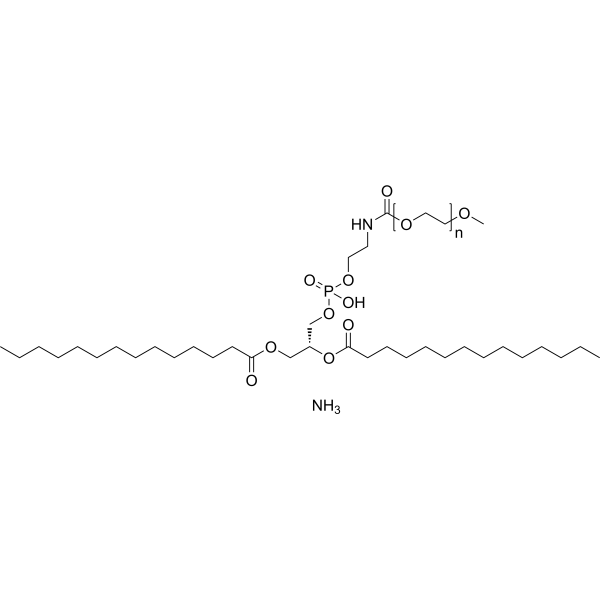
- HY-155927
-
|
DMPE-PEG1000; 1,2-Dimyristoyl-sn-glycero-3-phosphoethanolamine-N-[methoxy(polyethylene glycol)-1000] ammonium
|
Liposome
|
Others
|
|
14:0 PEG1000 PE is a PEG lipid functional end group used in the synthesis of liposomes (LPs) for the design of conjugated polymer nanoparticles. Through biotin modification and carboxyl terminus, lipid nanoparticles (LNPs) further coupling with other biomolecules can be achieved. Functionalized nanoparticles can be used for targeted labeling of specific cellular proteins. With streptavidin as a linker, biotinylated PEG lipid-conjugated polymer nanoparticles are able to bind to biotinylated antibodies on cell surface receptors, yielding the utility of fluorescence-based imaging and sensing.
|
-
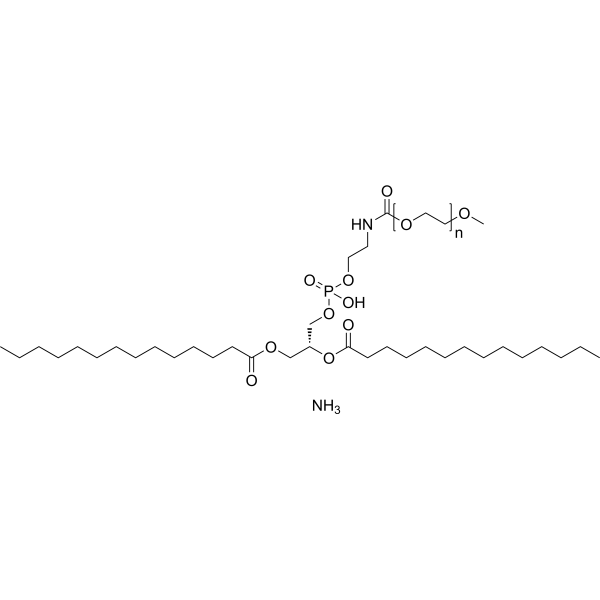
- HY-155928
-
|
DMPE-PEG3000; 1,2-Dimyristoyl-sn-glycero-3-phosphoethanolamine-N-[methoxy(polyethylene glycol)-3000] ammonium
|
Liposome
|
Others
|
|
14:0 PEG3000 PE is a PEG lipid functional end group used in the synthesis of liposomes (LPs) for the design of conjugated polymer nanoparticles. Through biotin modification and carboxyl terminus, lipid nanoparticles (LNPs) further coupling with other biomolecules can be achieved. Functionalized nanoparticles can be used for targeted labeling of specific cellular proteins. With streptavidin as a linker, biotinylated PEG lipid-conjugated polymer nanoparticles are able to bind to biotinylated antibodies on cell surface receptors, yielding the utility of fluorescence-based imaging and sensing.
|
-
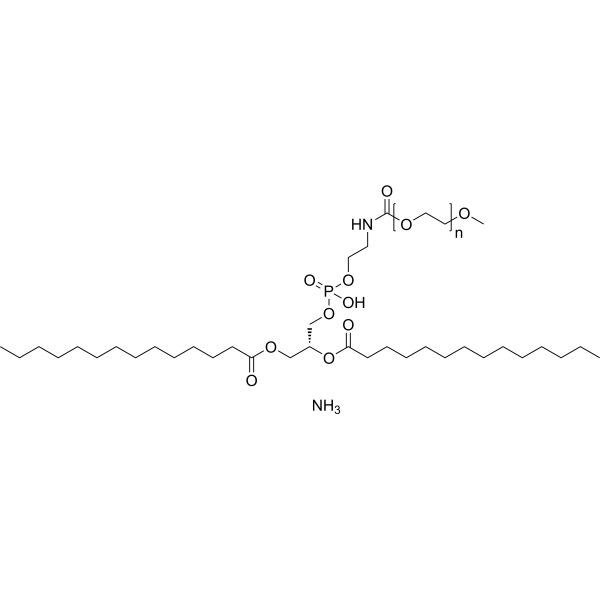
- HY-155929
-
|
DMPE-PEG5000; 1,2-Dimyristoyl-sn-glycero-3-phosphoethanolamine-N-[methoxy(polyethylene glycol)-5000] ammonium
|
Liposome
|
Others
|
|
14:0 PEG5000 PE is a PEG lipid functional end group used in the synthesis of liposomes (LPs) for the design of conjugated polymer nanoparticles. Through biotin modification and carboxyl terminus, lipid nanoparticles (LNPs) further coupling with other biomolecules can be achieved. Functionalized nanoparticles can be used for targeted labeling of specific cellular proteins. With streptavidin as a linker, biotinylated PEG lipid-conjugated polymer nanoparticles are able to bind to biotinylated antibodies on cell surface receptors, yielding the utility of fluorescence-based imaging and sensing.
|
-

- HY-155930
-
|
DOPE-PEG350; 1,2-Dioleoyl-sn-glycero-3-phosphoethanolamine-N-[methoxy(polyethylene glycol)-350] ammonium
|
Liposome
|
Others
|
|
18:1 PEG350 PE is a PEG lipid functional end group used in the synthesis of liposomes (LPs) for the design of conjugated polymer nanoparticles. Through biotin modification and carboxyl terminus, lipid nanoparticles (LNPs) further coupling with other biomolecules can be achieved. Functionalized nanoparticles can be used for targeted labeling of specific cellular proteins. With streptavidin as a linker, biotinylated PEG lipid-conjugated polymer nanoparticles are able to bind to biotinylated antibodies on cell surface receptors, yielding the utility of fluorescence-based imaging and sensing.
|
-

- HY-155931
-
|
DOPE-PEG550; 1,2-Dioleoyl-sn-glycero-3-phosphoethanolamine-N-[methoxy(polyethylene glycol)-550] ammonium
|
Liposome
|
Others
|
|
18:1 PEG550 PE is a PEG lipid functional end group used in the synthesis of liposomes (LPs) for the design of conjugated polymer nanoparticles. Through biotin modification and carboxyl terminus, lipid nanoparticles (LNPs) further coupling with other biomolecules can be achieved. Functionalized nanoparticles can be used for targeted labeling of specific cellular proteins. With streptavidin as a linker, biotinylated PEG lipid-conjugated polymer nanoparticles are able to bind to biotinylated antibodies on cell surface receptors, yielding the utility of fluorescence-based imaging and sensing.
|
-

- HY-155932
-
|
DOPE-PEG1000; 1,2-Dioleoyl-sn-glycero-3-phosphoethanolamine-N-[methoxy(polyethylene glycol)-1000] ammonium
|
Liposome
|
Others
|
|
18:1 PEG1000 PE is a PEG lipid functional end group used in the synthesis of liposomes (LPs) for the design of conjugated polymer nanoparticles. Through biotin modification and carboxyl terminus, lipid nanoparticles (LNPs) further coupling with other biomolecules can be achieved. Functionalized nanoparticles can be used for targeted labeling of specific cellular proteins. With streptavidin as a linker, biotinylated PEG lipid-conjugated polymer nanoparticles are able to bind to biotinylated antibodies on cell surface receptors, yielding the utility of fluorescence-based imaging and sensing.
|
-

- HY-155933
-
|
DOPE-PEG3000; 1,2-Dioleoyl-sn-glycero-3-phosphoethanolamine-N-[methoxy(polyethylene glycol)-3000] ammonium
|
Liposome
|
Others
|
|
18:1 PEG3000 PE is a PEG lipid functional end group used in the synthesis of liposomes (LPs) for the design of conjugated polymer nanoparticles. Through biotin modification and carboxyl terminus, lipid nanoparticles (LNPs) further coupling with other biomolecules can be achieved. Functionalized nanoparticles can be used for targeted labeling of specific cellular proteins. With streptavidin as a linker, biotinylated PEG lipid-conjugated polymer nanoparticles are able to bind to biotinylated antibodies on cell surface receptors, yielding the utility of fluorescence-based imaging and sensing.
|
-

- HY-155934
-
|
DOPE-PEG5000; 1,2-Dioleoyl-sn-glycero-3-phosphoethanolamine-N-[methoxy(polyethylene glycol)-5000] ammonium
|
Liposome
|
Others
|
|
18:1 PEG5000 PE is a PEG lipid functional end group used in the synthesis of liposomes (LPs) for the design of conjugated polymer nanoparticles. Through biotin modification and carboxyl terminus, lipid nanoparticles (LNPs) further coupling with other biomolecules can be achieved. Functionalized nanoparticles can be used for targeted labeling of specific cellular proteins. With streptavidin as a linker, biotinylated PEG lipid-conjugated polymer nanoparticles are able to bind to biotinylated antibodies on cell surface receptors, yielding the utility of fluorescence-based imaging and sensing.
|
-

- HY-113217S1
-
|
|
Isotope-Labeled Compounds
Endogenous Metabolite
|
Others
|
|
Cholesteryl oleate-d7-1 is deuterium labeled Cholesteryl oleate. Cholesteryl oleate is an esterified form of Cholesterol. Cholesteryl oleate can be used in the generation of solid lipid nanoparticle (SLN, a nanoparticle-based method for gene therapy)
|
-

- HY-113217S
-
|
|
Endogenous Metabolite
|
Others
|
|
Cholesteryl oleate-d7 is deuterium labeled Cholesteryl oleate. Cholesteryl oleate is an esterified form of Cholesterol. Cholesteryl oleate can be used in the generation of solid lipid nanoparticle (SLN, a nanoparticle-based method for gene therapy)[1
|
-
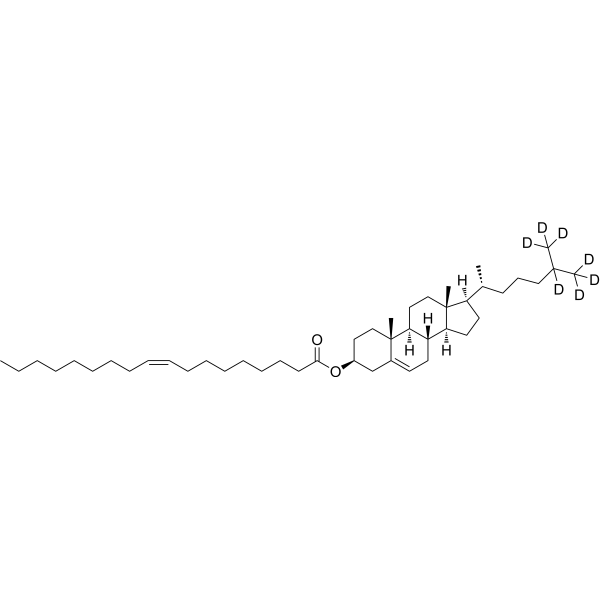
- HY-W440810
-
|
|
Liposome
|
Others
|
|
Undecyl 6-bromohexanoate can be useful for the preparation of lipid nanoparticles.
|
-
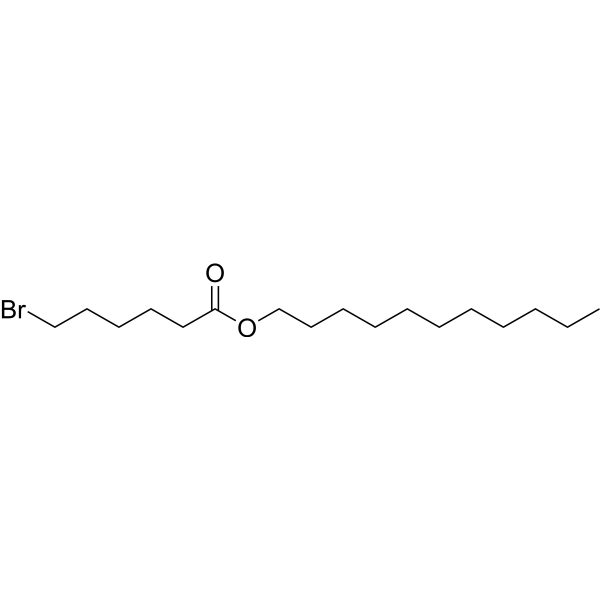
- HY-147332
-
|
|
Liposome
|
Neurological Disease
|
|
TCL053 is an ionizable lipid carrier and used to introduce active components, in particular nucleic acids, into cells with excellent efriciency. TCL053, together with DPPC (Dipalmitoylphosphatidylcholine), PEG-DMG (Polyethylene glycoldimyristoyl glycerol), and cholesterol, forms lipid nanoparticle (LNP) which is able to deliver Cas9 mRNA and sgRNA into skeletal muscle .
|
-
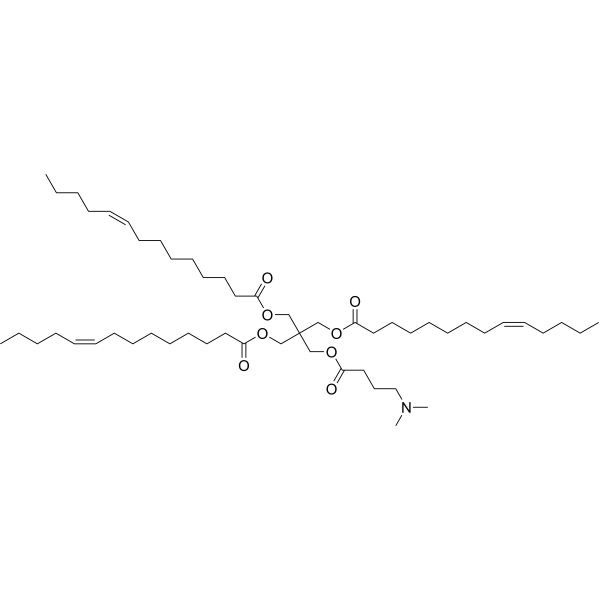
- HY-150116
-
|
|
Liposome
|
Others
|
|
Lipid 1 is an ionizable amino lipid used for the generation of Lipid nanoparticles (LNPs).
|
-
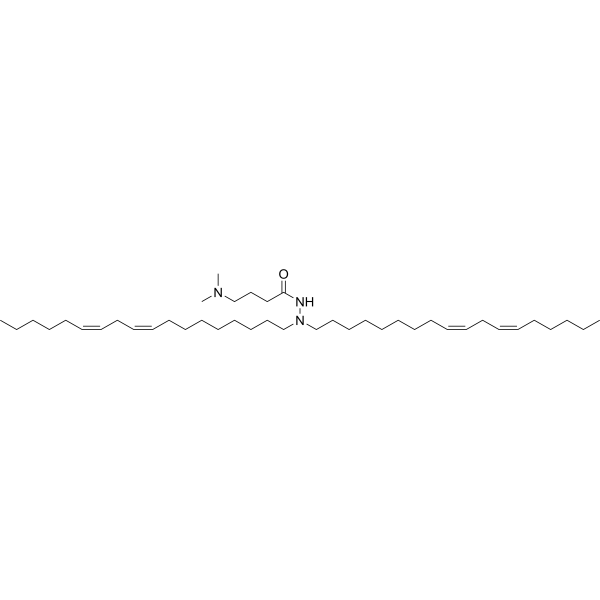
- HY-150115
-
|
|
Liposome
|
Others
|
|
Lipid 10 is an ionizable amino lipid used for the generation of Lipid nanoparticles (LNPs).
|
-
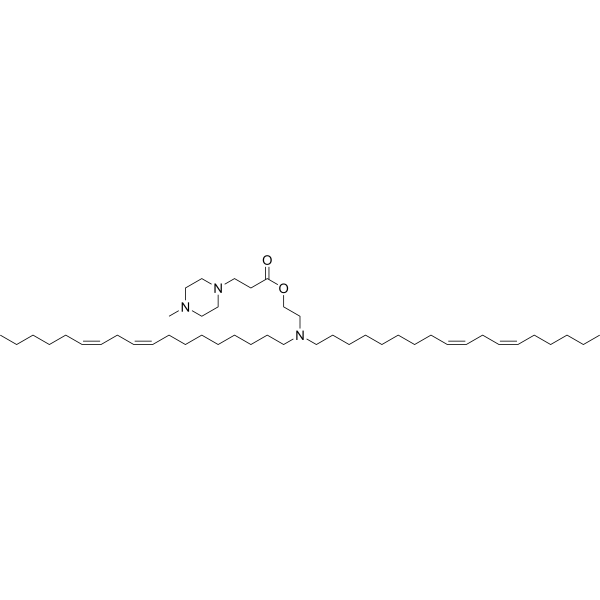
- HY-153378
-
|
|
Liposome
|
Others
|
|
Lipid 15 is an ionizable amino lipid used for the generation of Lipid nanoparticles (LNPs).
|
-
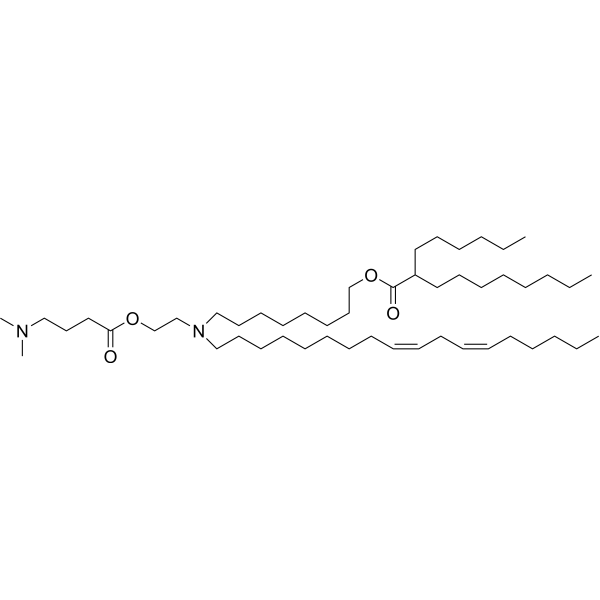
- HY-150117
-
|
|
Liposome
|
Others
|
|
Lipid 6 is an ionizable amino lipid used for the generation of Lipid nanoparticles (LNPs).
|
-
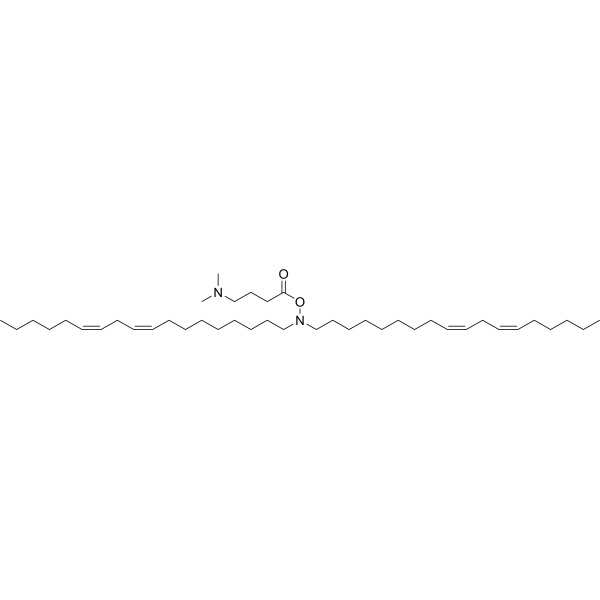
- HY-150118
-
|
|
Liposome
|
Others
|
|
Lipid 8 is an ionizable amino lipid used for the generation of Lipid nanoparticles (LNPs).
|
-
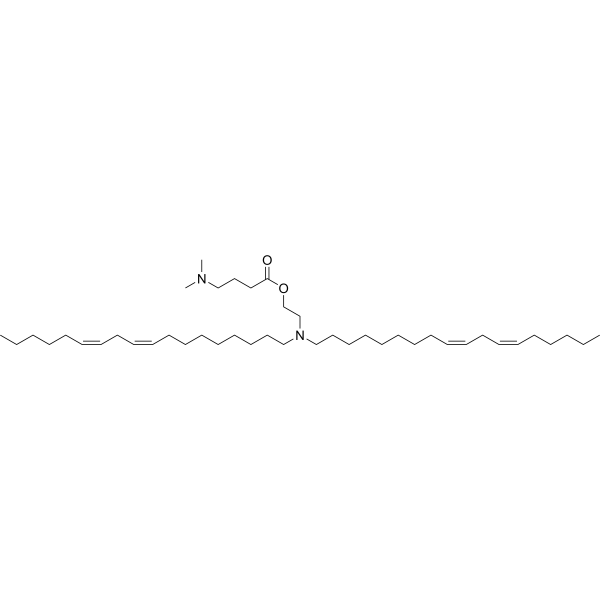
- HY-134782
-
|
|
Liposome
|
Others
|
|
OF-Deg-Lin is an ionizable amino lipid used for the generation of Lipid nanoparticles (LNPs).
|
-
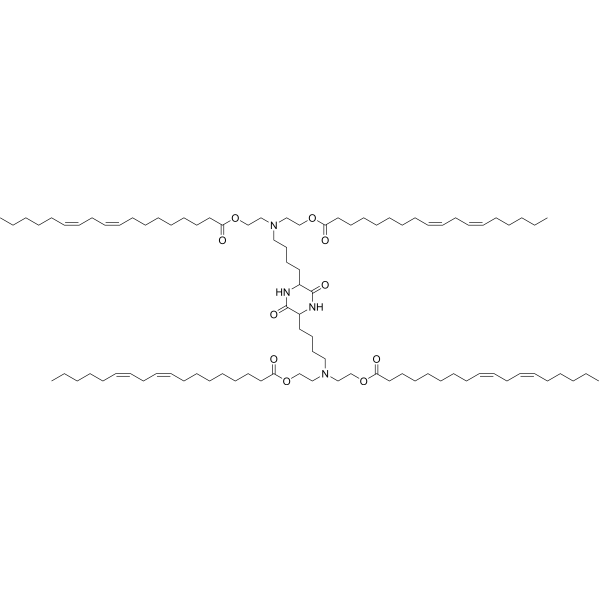
- HY-153377
-
-
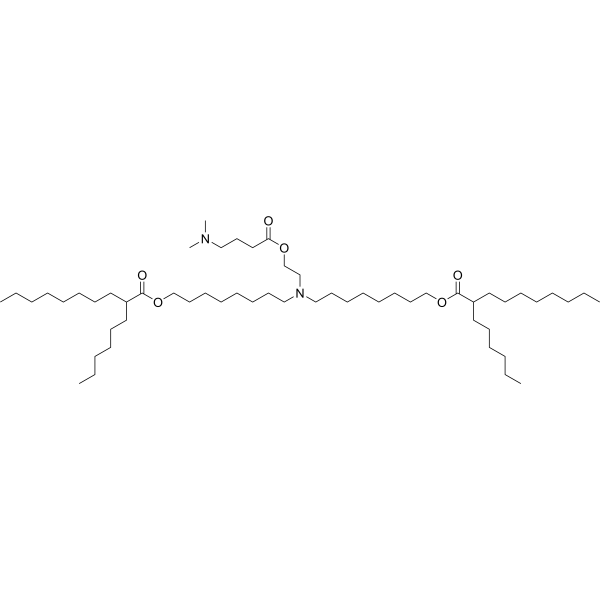
- HY-153373
-
|
|
Liposome
|
Others
|
|
4A3-Cit is an ionizable lipid used for the generation of lipid nanoparticles (LNPs).
|
-

- HY-142979
-
|
|
Liposome
|
Others
|
|
DSPE-PEG 2000 is a PEG-lipid that can be used to form micelles as nanoparticles for drug delivery .
|
-
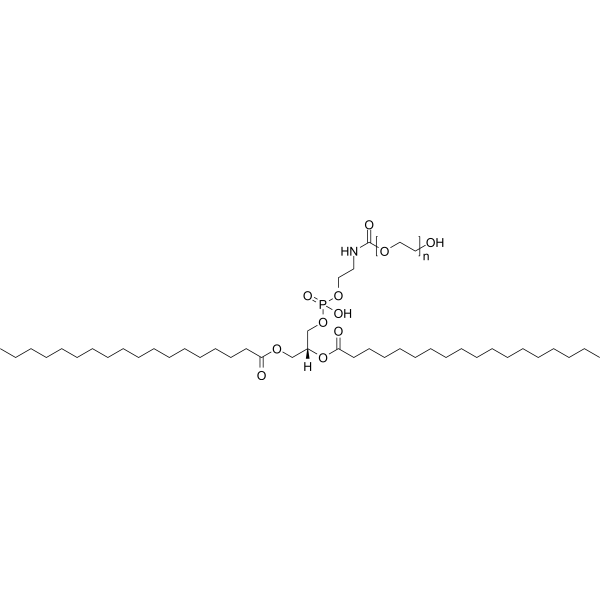
- HY-153138
-
-
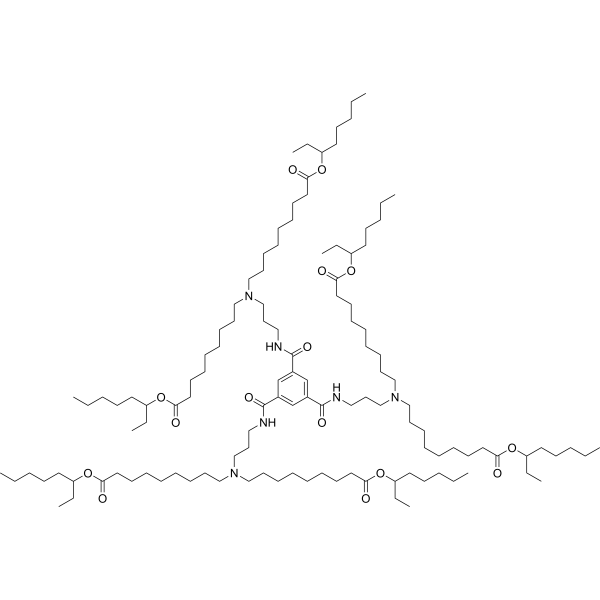
- HY-160705
-
|
|
Liposome
|
|
|
PNI 132, an ionizable lipid derived from the patent WO2020252589A, is useful in the formulation of lipid nanoparticles.
|
-
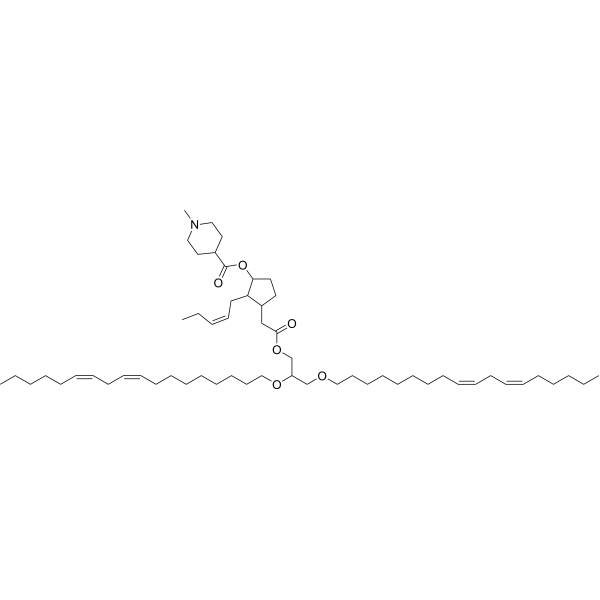
- HY-W440813
-
|
|
Liposome
|
Others
|
|
Heptadecan-9-yl 8-bromooctanoate can be useful for the building or modification of lipid nanoparticles.
|
-
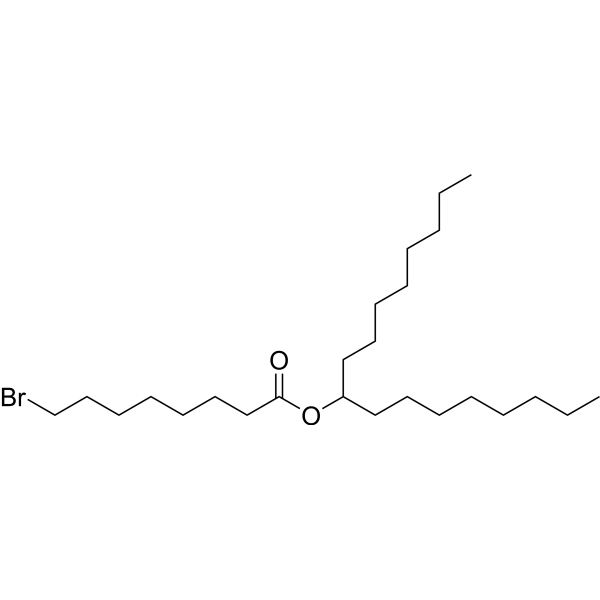
- HY-W590532
-
|
|
Liposome
|
Others
|
|
306-O12B is an ionizable cationic lipid used for the generation of lipid nanoparticles (LNPs).
|
-

- HY-W800783
-
|
CDESA
|
Liposome
|
Others
|
|
DSTAP chloride (CDESA) is a cationic lipid that used in the formation of lipid nanoparticles (LNPs). DORI chloride has high transfection efficiency .
|
-

- HY-160576
-
|
|
Liposome
|
Cancer
|
|
DNCA is a neutral lipid that can be used in the generation of lipid nanoparticles (LNPs). DNCA can be used in nucleic acid delivery .
|
-

- HY-139671
-
|
|
Others
|
Others
|
|
Ultrashort α,β-Peptide is found to be able to stabilize colloidal gold nanoparticles in physiological media over 3 months.
|
-
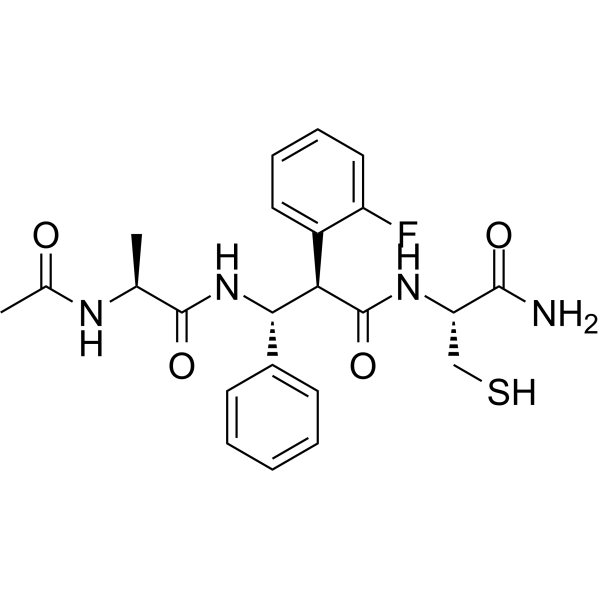
- HY-153372
-
|
|
Liposome
|
Others
|
|
93-O17S is a chalcogen-containing ionizable cationic lipid used for making lipid nanoparticles (LNPs).
|
-
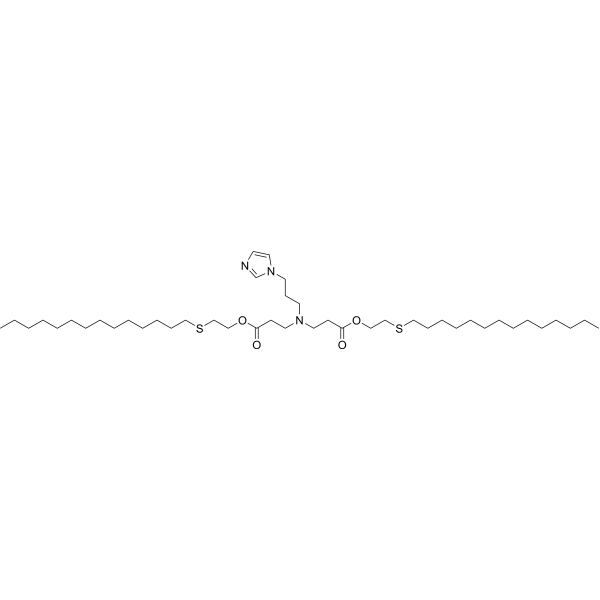
- HY-153186
-
|
|
Liposome
|
Others
|
|
LNP Lipid-3 is an ionizable lipid extracted from patent WO2021113777A, and can be used for the generation of Lipid nanoparticles (LNPs).
|
-

- HY-160578
-
|
N-Cholesteryl succinyl glucosamine
|
Liposome
|
Others
|
|
Glucosamine Cholesterol (N-Cholesteryl succinyl glucosamine) is a glucosamine-based lipid conjugate, and can be used in the formation of lipid nanoparticles (LNPs) .
|
-
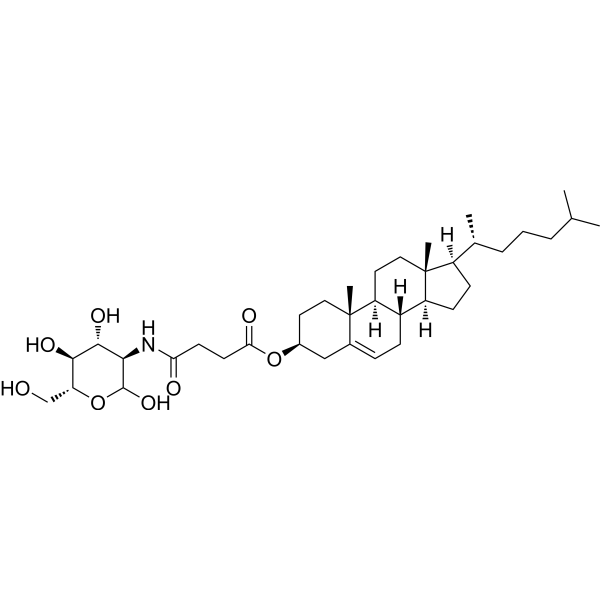
- HY-N6613R
-
|
Galacturonic acid polymer (Standard)
|
Others
|
Infection
Inflammation/Immunology
|
|
Polygalacturonic acid (Standard) is the analytical standard of Polygalacturonic acid. This product is intended for research and analytical applications. Polygalacturonic acid (Galacturonic acid polymer) is transparent colloid, is a major component of the cell wall. Polygalacturonic acid can be used to prepare silver nanoparticles (AgNPs), as an antioxidant and anti-inflammatory that protect cells from destructive effect of elevated ROS and accelerate wound healing. Polygalacturonic acid nanoparticles also displays anti-bacterial activity .
|
-
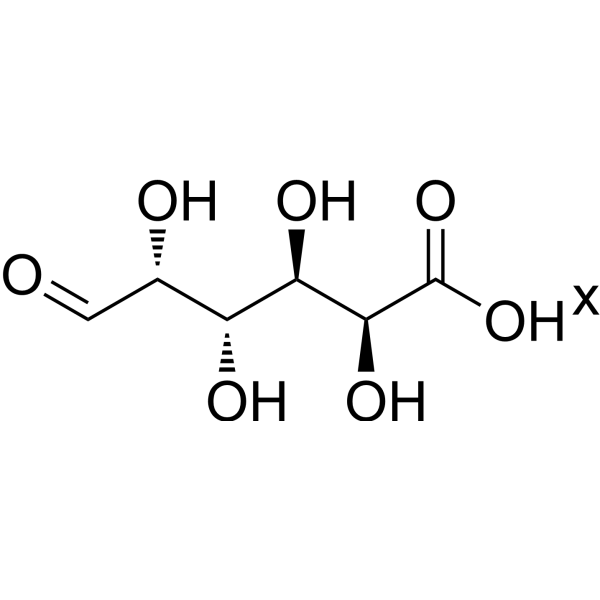
- HY-147172
-
|
|
Fluorescent Dye
|
Others
|
|
Ru(bpy)2(dcbpy)NHS (dihexafluorophosphate) combines with gold nanoparticle amplification can be used for the determination of lysozyme with electrochemiluminescence .
|
-
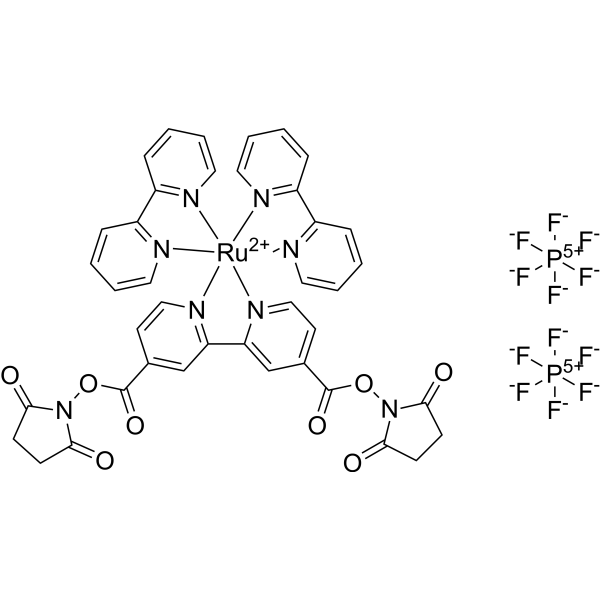
- HY-W590548
-
|
|
Liposome
|
Others
|
|
ATX-001 is an ionizable cationic lipid. ATX-001 can be used in the formation of lipid nanoparticles (LNPs) for the delivery mRNA .
|
-
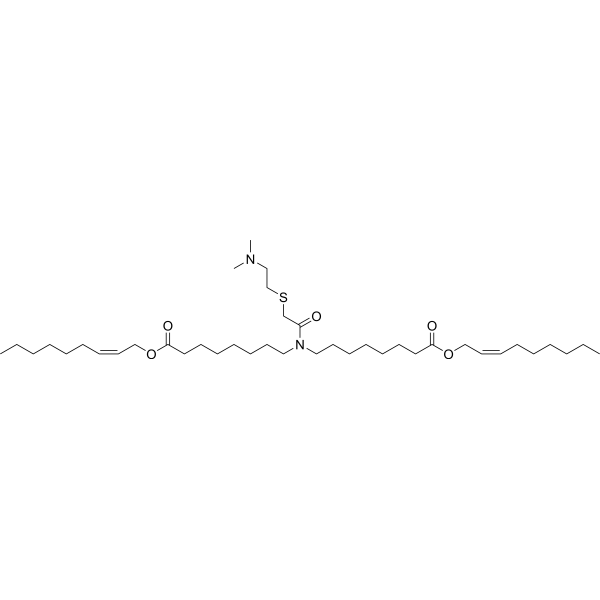
- HY-W598178
-
|
|
Liposome
|
Others
|
|
93-O17O is a chalcogen-containing ionizable cationic lipidoid that used in the formation of lipid nanoparticles (LNPs) .
|
-

- HY-153380
-
|
|
Liposome
|
Others
|
|
ALC-0315 analogue-2 is an analogue of ALC-0315. ALC-0315 is an ionisable aminolipid that is responsible for mRNA compaction and aids mRNA cellular delivery and its cytoplasmic release through suspected endosomal destabilization. ALC-0315 can be used to form lipid nanoparticle (LNP) delivery vehicles. Lipid-Nanoparticles have been used in the research of mRNA COVID-19 vaccine.
|
-
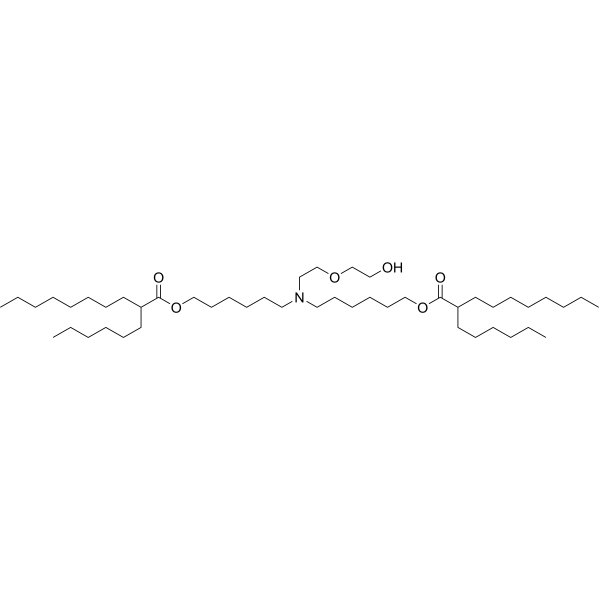
- HY-157524
-
|
|
Others
|
Others
|
|
1,2-O-Dioctadecyl-sn-glycerol (Compound 7b) is a lipid molecule that can be used to synthesize thermostable lipid nanoparticle .
|
-

- HY-153235
-
|
|
SARS-CoV
Liposome
|
Infection
|
|
COVID-19 Spike Protein mRNA-LNP is a lipid nanoparticle (LNP) containing COVID-19 Spike Protein, suitable for detection of RNA delivery, translation efficiency, cell viability, etc. COVID-19 Spike Protein is the novel coronavirus pneumonia spike protein located on the membrane surface. COVID-19 Spike Protein undertakes the functions of virus binding to host cell membrane receptors and membrane fusion, thereby mediating the entry of COVID-19 virus into cells. COVID-19 Spike Protein is an important site of action for host neutralizing antibodies and a key target for vaccine design .
|
-

- HY-W440811
-
|
|
Liposome
|
Others
|
|
6-Bromohexyl 2-hexyldecanoate is a lipid. 6-Bromohexyl 2-hexyldecanoate can be used to build lipid nanoparticles and nanomaterials .
|
-

- HY-148842
-
|
|
Liposome
|
Others
|
|
C14-4 is an ionizable lipid for lipid nanoparticles (LNPs) formulation. C14-4 was identified for its potent transfection and low cytotoxicity.
|
-

- HY-W590531
-
-
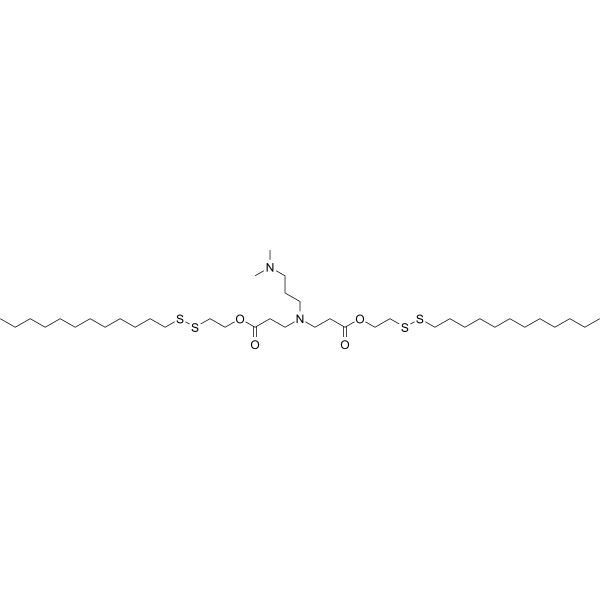
- HY-W590680
-
|
|
Liposome
|
Others
|
|
ssPalmM is a SS-cleavable proton-activated lipid-like materials. ssPalmM can be used to form lipid nanoparticles (LNPs) for nuclear targeting of plasmid DNA .
|
-

- HY-112756
-
|
|
Liposome
|
Others
|
|
PEG2000-DGG is a synthetic lipid. PEG2000-DGG can be used in lipid-based nanoparticle (LNP) delivery systems .
|
-
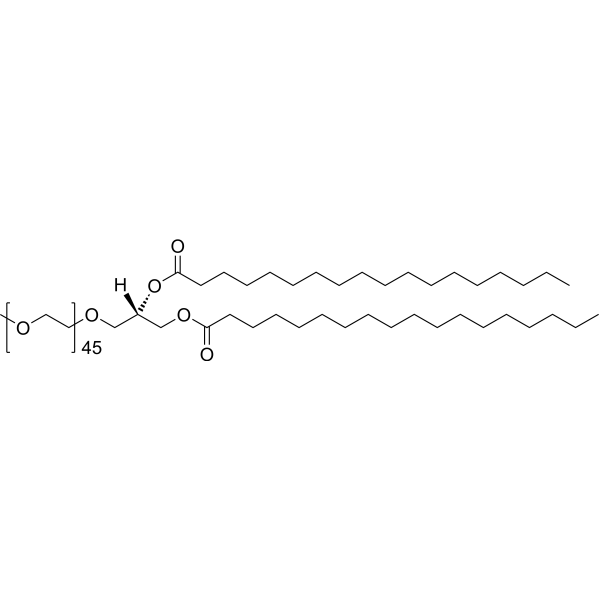
- HY-153852
-
|
|
Liposome
|
Others
|
|
1LNP Lipid-7 (Compound 7013) is a lipid. LNP Lipid-6 can be used to prepare lipid nanoparticles (LNP) and for drug delivery .
|
-
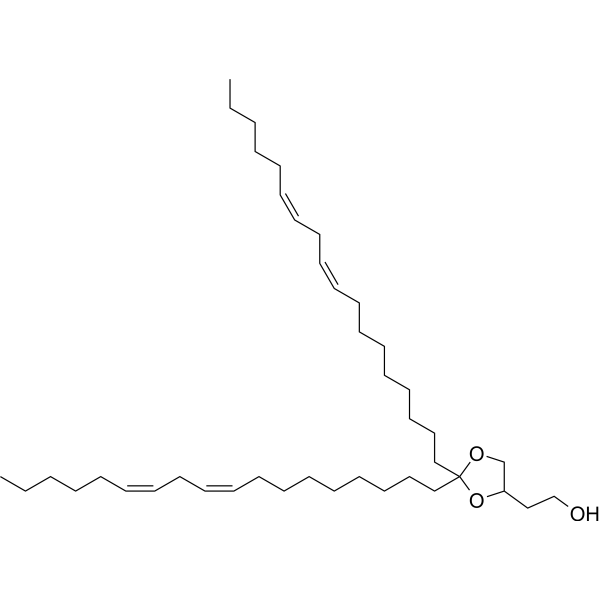
- HY-149156
-
|
|
Liposome
|
Cancer
|
|
Lipid C24 is a cationic ionizable lipid, and can be used in the formation of lipid nanoparticles (LNPs). Lipid C24 can be used for research of delivery of nucleic acids .
|
-
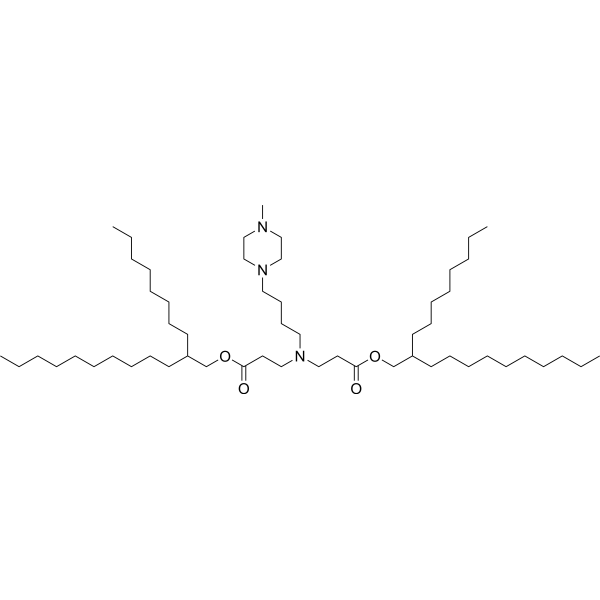
- HY-46759A
-
|
|
Liposome
|
Infection
|
|
Genevant CL1 monohydrochloride is an ionizable lipid (lipid 10, pKa=6.3), and it can be used for mRNA lipid nanoparticle (LNP) vaccine delivery .
|
-
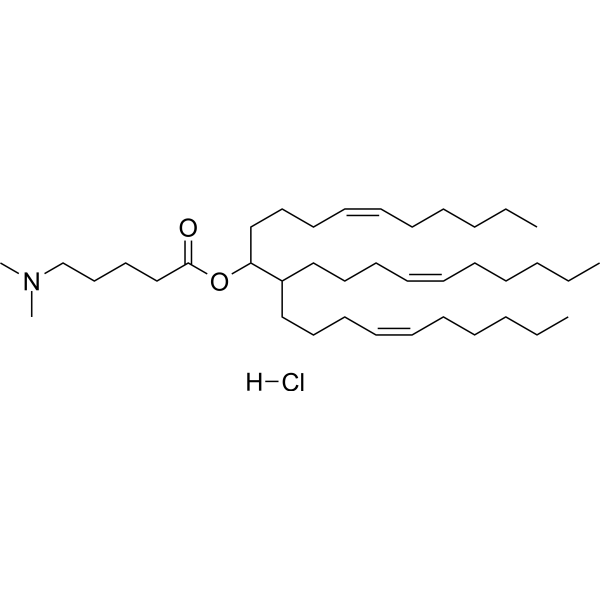
- HY-W441012
-
|
|
Liposome
|
Others
|
|
DSPE-PEG-NHS, MW 600 is a pegylated phospholipid derivatives which can be used to prepare liposome or lipid nanoparticles for targeted drug delivery system, such as DNA or mRNA vaccine.
|
-
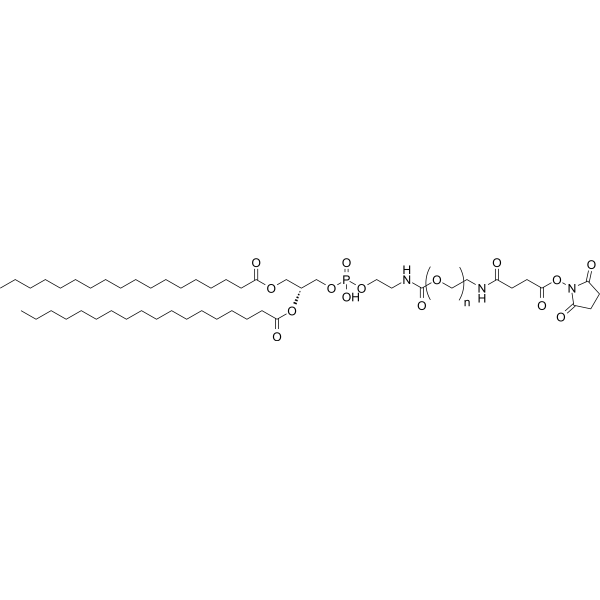
- HY-145794
-
|
|
Liposome
|
Others
|
|
ZA3-Ep10 is a zwitterionic lipid used in lipid nanoparticles formulation for in vivo RNA delivery and non-viral CRISPR/Cas gene editing.
|
-

- HY-148830
-
|
|
Liposome
|
Others
|
|
Piperazine-bis(ethyl octadeca-9,12-dienoate) is a cationic lipid extracted from patent WO2023036148A1, and can be used for the generation of Lipid nanoparticles (LNPs).
|
-
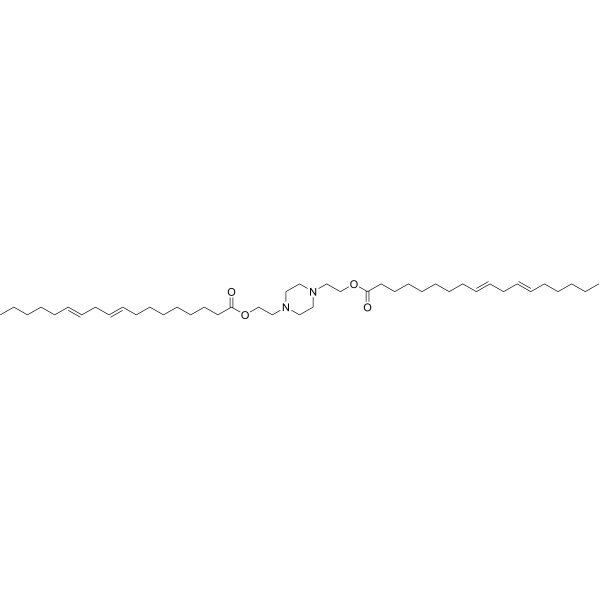
- HY-156630
-
|
|
Liposome
|
Others
|
|
Ionizable lipid-1 (compound II-10) is an ionizable lipid (pKa=6.16) that can be used to prepare lipid nanoparticles (LNP) with bilayer structure .
|
-
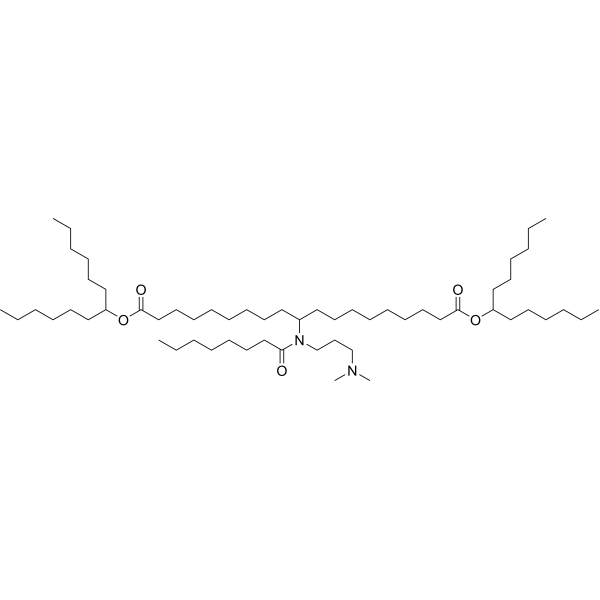
- HY-156630A
-
|
|
Liposome
|
Others
|
|
Ionizable lipid-1 (compound II-10) is an ionizable lipid (pKa=6.16) that can be used to prepare lipid nanoparticles (LNP) with bilayer structure .
|
-
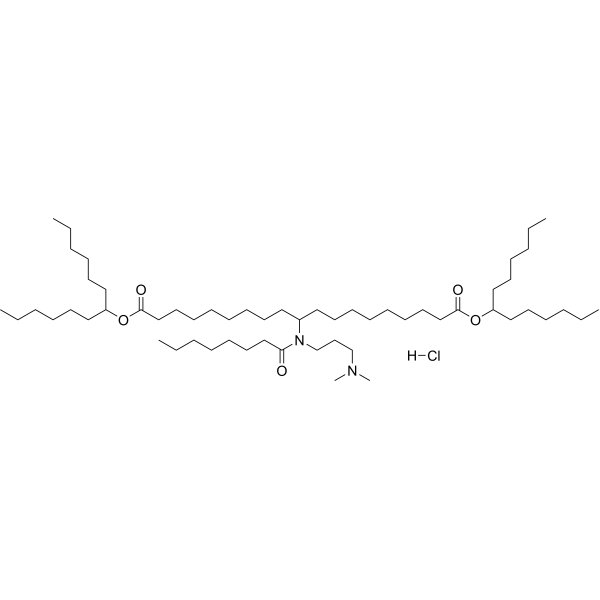
- HY-W441016
-
|
|
Biochemical Assay Reagents
|
Others
|
|
DSPE-PEG-NHS, MW 5000 is a pegylated phospholipid derivatives which can be used to prepare liposome or lipid nanoparticles for targeted drug delivery system, such as DNA or mRNA vaccine .
|
-
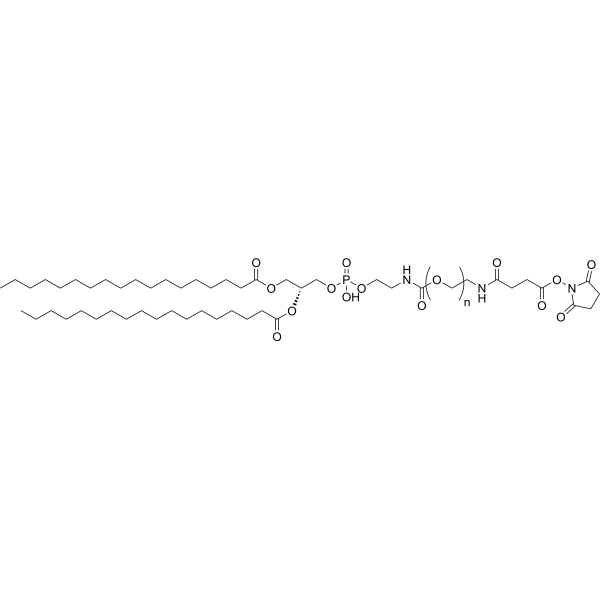
- HY-W441015A
-
|
|
Liposome
|
Others
|
|
DSPE-m-PEG-NHS (MW 3400) is a pegylated phospholipid derivatives which can be used to prepare liposome or lipid nanoparticles for targeted drug delivery system, such as DNA or mRNA vaccine.
|
-
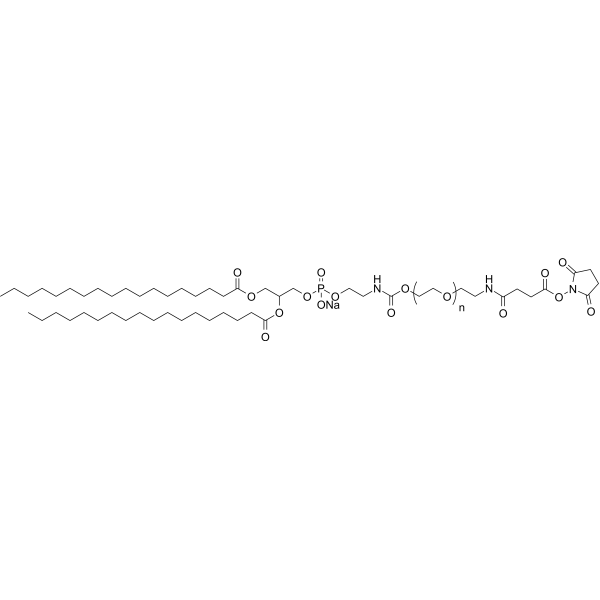
- HY-W127410
-
|
|
Biochemical Assay Reagents
|
Others
|
|
Hexanoic anhydride is used as a reactant for the synthesis of acremomannolipin A. For the green synthesis of acyclovir dipivoxil (acyclovir proagent), for the preparation of hexanoyl-modified chitosan nanoparticles, chitosan-based polymer surfactants by N-acylation of chitosan .
|
-

- HY-153371
-
|
|
Liposome
|
Others
|
|
50-C2-C9-4tail has been used in the generation of lipid nanoparticles (LNPs) for the delivery of siRNA and mRNA in vitro and in vivo.
|
-
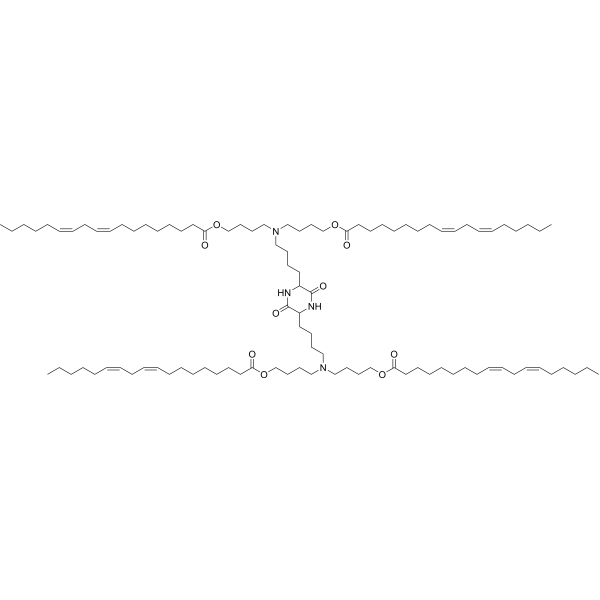
- HY-W441021
-
|
|
Liposome
|
Others
|
|
DSPE-Pyrene is a phospholipid molecule with polycyclic aromatic hydrocarbon, and can be used for drug encapsulation, such as drug loaded liposomes or nanoparticles. Pyrene is a fluorescent probe whose spectrum is sensitive to the polarity of its environment.
|
-
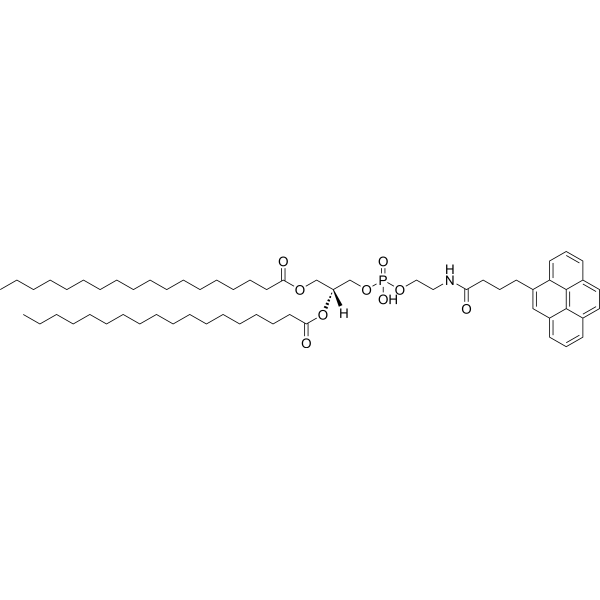
- HY-149167
-
|
|
Liposome
Biochemical Assay Reagents
|
Others
|
|
mRNA-Encapsulating Lipid Excipient 1 (Compound 2) is a Thiocarbamate-Based Ionizable Lipid. mRNA-Encapsulating Lipid Excipient 1 can be used as an excipient in mRNA-encapsulating lipid nanoparticle .
|
-

- HY-141892A
-
|
|
Liposome
|
Others
|
|
DSPE-PEG Carboxylic acid (sodium), MW 2000 is a PEG-lipid that can be used to form micelles as nanoparticles for drug delivery. DSPE-PEG Carboxylic acid (sodium), MW 2000 increases the blood circulation time of liposomes .
|
-

- HY-160580
-
|
|
Liposome
|
Others
|
|
G1-OC2-K3-E10 is an ionizable lipid, and can be used for delivery of mRNA in lipid nanoparticles (LNPs) .
|
-

- HY-128720
-
|
|
Endogenous Metabolite
|
Metabolic Disease
|
|
Diethyl oxalpropionate is an intermediate for poly((R,S)-3,3-dimethylmalic acid) (PDMMLA) derivative synthesis. PDMMLA derivative can be used in synthesis of nanoparticles and study of warfarin encapsulation and controlled release .
|
-
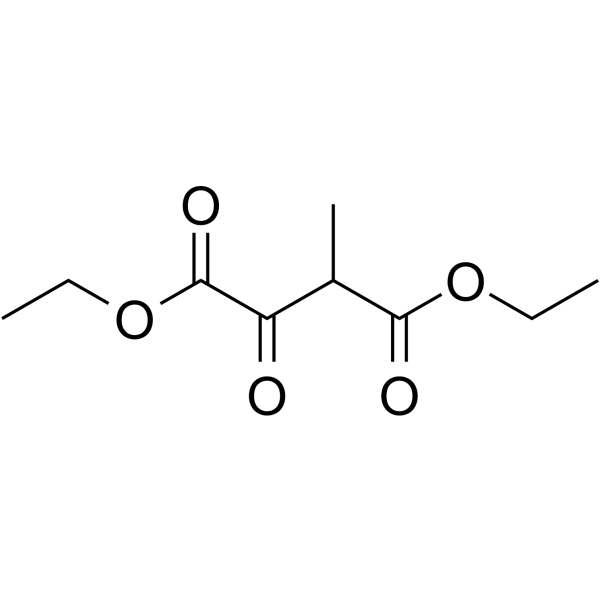
- HY-113736
-
|
|
Amino Acid Derivatives
|
Others
|
|
Glycyllysine is a polypeptide that can be used in the synthesis of antibodies and amino acid type gemini surfactants. Glycyllysine has potential applications in modifying plasmid/gemini/lipid (P/G/L) nanoparticles transport carriers .
|
-
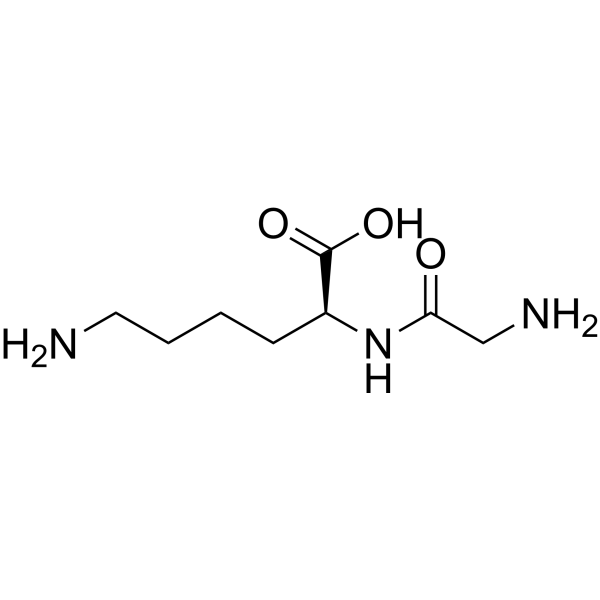
- HY-112773
-
|
|
Liposome
|
Others
|
|
1,1′,1′′,1′′′-[1,4-Piperazinediylbis(2,1-ethanediylnitrilo)]tetrakis[2-dodecanol] is a lipid/lipidoid used in preparation of lipid-based or lipidoid nanoparticles .
|
-
![1,1′,1′′,1′′′-[1,4-Piperazinediylbis(2,1-ethanediylnitrilo)]tetrakis[2-dodecanol]](//file.medchemexpress.com/product_pic/hy-112773.gif)
- HY-W590678
-
|
|
Liposome
|
Others
|
|
SSPalmO-Phe is an ionizable cationic self-degradable disulfide-cleavable (SS-cleavable) proton-activated lipid-like material. It has been used in combination with other lipids in the formation of lipid nanoparticles (LNPs) for drug delivery.
|
-
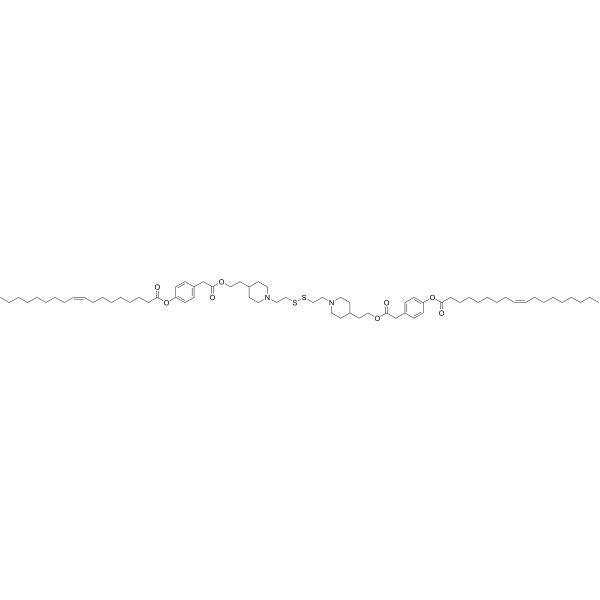
- HY-156936
-
|
|
Liposome
|
Others
|
|
RCB-02-4-8 is an ionizable cationic lipid that is used to form lipid nanoparticles (LNPs) to deliver mRNA. RCB-02-4-8 can improve the efficiency of lung transfection in mice .
|
-
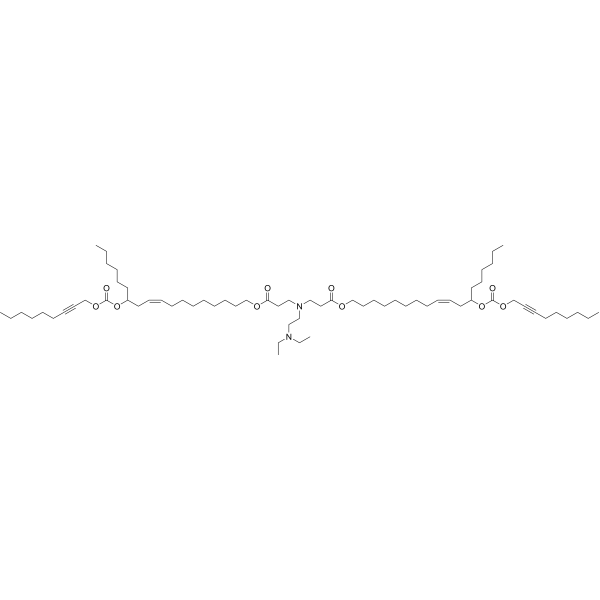
- HY-D1005A23
-
|
PEG-PPG-PEG, 4400 (Averag)
|
Biochemical Assay Reagents
|
Others
|
|
Poloxamer 401 L121 is block polymer of polyoxyethylene and polyoxypropylene. Poloxamer 401 L121 is utilized as lymphotrophic particles in nanoparticle engineering, as inhibitor of multidrug resistance and adjuvant activities or as surfactants and emulsifying agents in cosmetics .
|
-
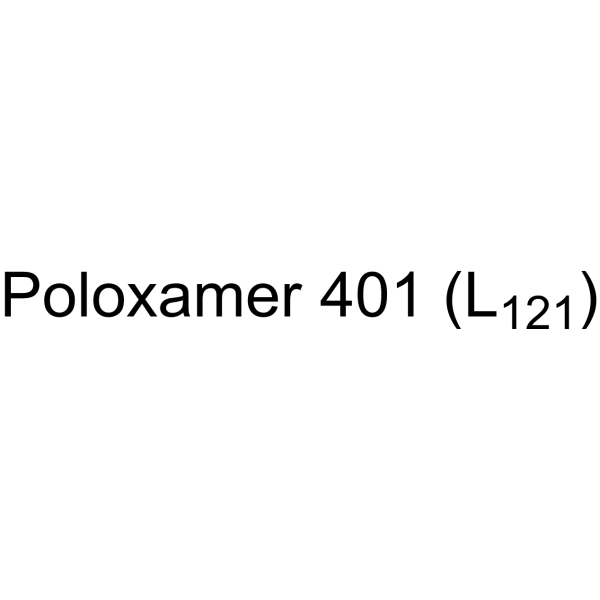
- HY-153737
-
|
|
Liposome
|
Others
|
|
113-N16B is an ionizable cationic lipid used for the generation of lipid nanoparticles (LNPs). 113-N16B delivers mRNA preferentially to pulmonary endothelial cells.
|
-
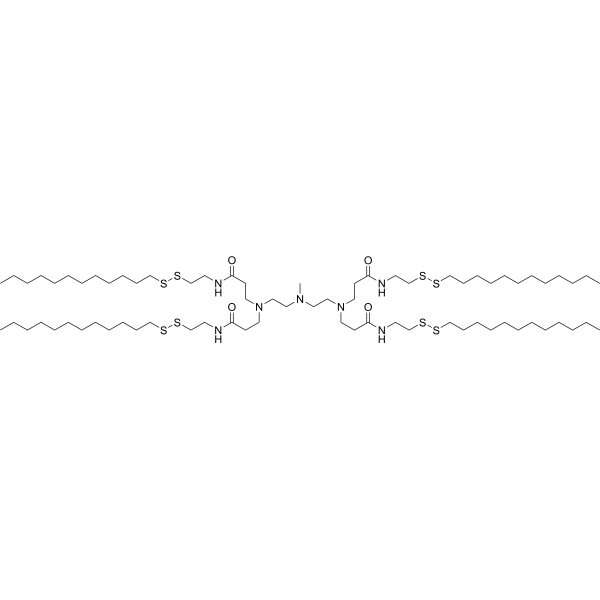
- HY-160577
-
|
|
Others
|
Others
|
|
DOG-IM4 can be used to synthesize nanoparticles to deliver antigen-encoding nucleic acids. It could be used to try to target autoimmune diseases, rare blood or metabolic diseases, allergies, cancer or infectious diseases .
|
-
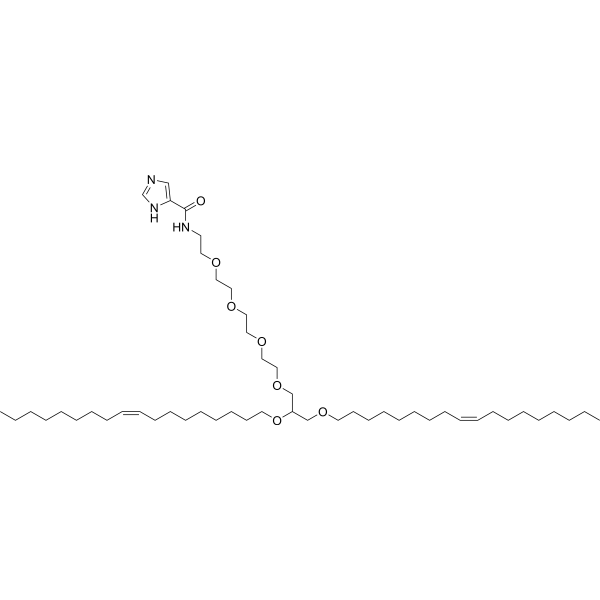
- HY-148855
-
|
|
Liposome
|
Others
|
|
OF-C4-Deg-Lin is an ionizable lipid with varied linker lengths. OF-C4-Deg-Lin can be used in the generation of lipid nanoparticles (LNPs) for the delivery of siRNA and mRNA .
|
-
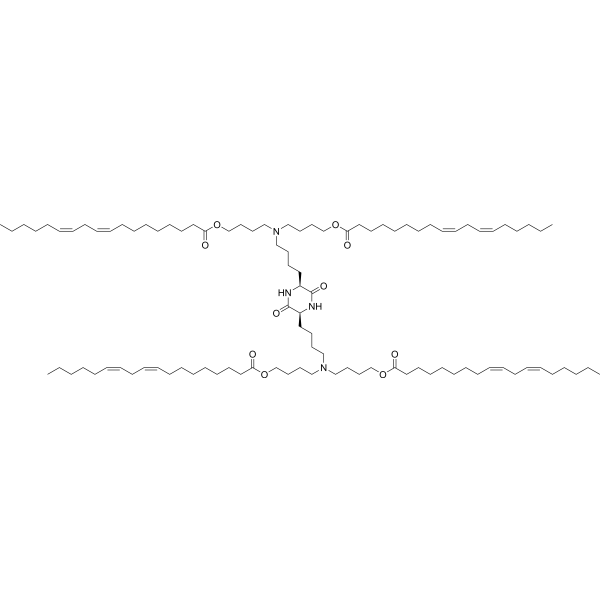
- HY-W590681
-
|
|
Liposome
|
Others
|
|
113-O12B is a disulfide bond-containing ionizable cationic lipidoid. 113-O12B can be used in that generation of lipid nanoparticles (LNPs) for the delivery of mRNA .
|
-
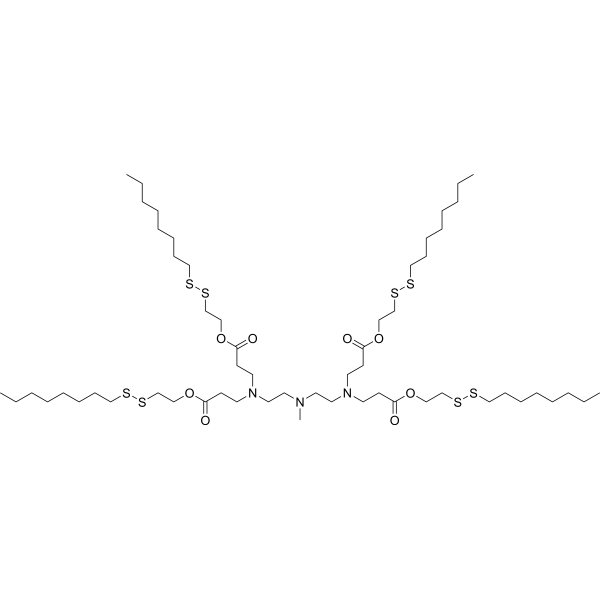
- HY-107799
-
|
|
Biochemical Assay Reagents
|
Others
|
|
Castor oil is a natural triglyceride and a solvent. Castor oil has a laxative effect and induces labor in pregnant females. Castor oil can be used as a solvent, co-solvent, stabilizing agent and polyol for the formation of polymer-nanoparticle composites .
|
-
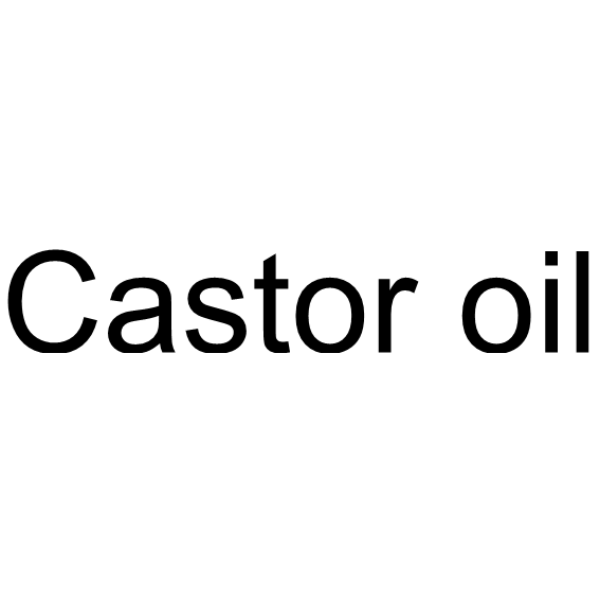
- HY-134781
-
CKK-E12
1 Publications Verification
|
Liposome
|
Others
|
|
CKK-E12 is a ionizable lipid in combination with other lipids make up the lipid nanoparticles which are used to deliver RNA-based research. CKK-E12 is highly selective toward liver parenchymal cell in vivo,
|
-
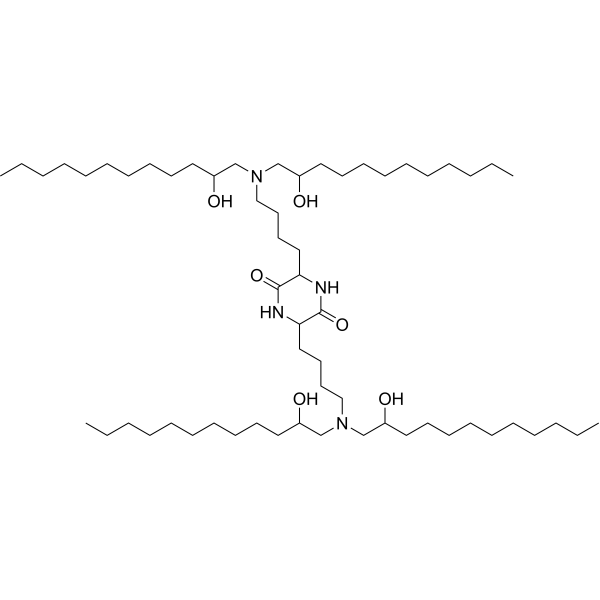
- HY-153936
-
|
|
Apoptosis
ROS Kinase
|
Others
|
|
Methyl 12-methyltridecanoate ((R)-betaxolol hydrochloride) is a biosurfactant extracted from Brevibacterium casei LS14.Methyl 12-methyltridecanoate provides a novel approach for functionalizing the silver nanoparticles higher biocompatibility in vivo environmental .
|
-
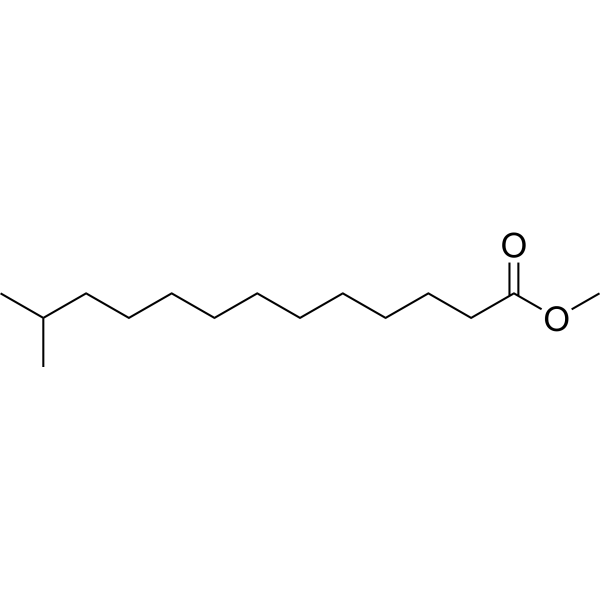
- HY-W590679
-
|
|
Liposome
|
Others
|
|
113-O16B is a disulfide bond-containing ionizable cationic lipidoid. 113-O16B has been used in the generation of lipid nanoparticles (LNPs) for the delivery of mRNA .
|
-
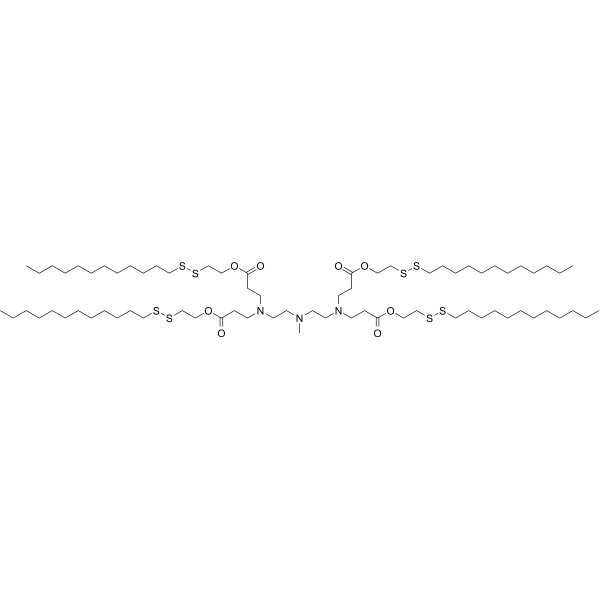
- HY-139305
-
|
|
Liposome
|
Cancer
|
|
CL4H6 is a pH-sensitive cationic lipid. CL4H6 is the main component of lipid nanoparticles (LNPs), which can be used to target and deliver siRNA, and induces a potent gene-silencing response .
|
-
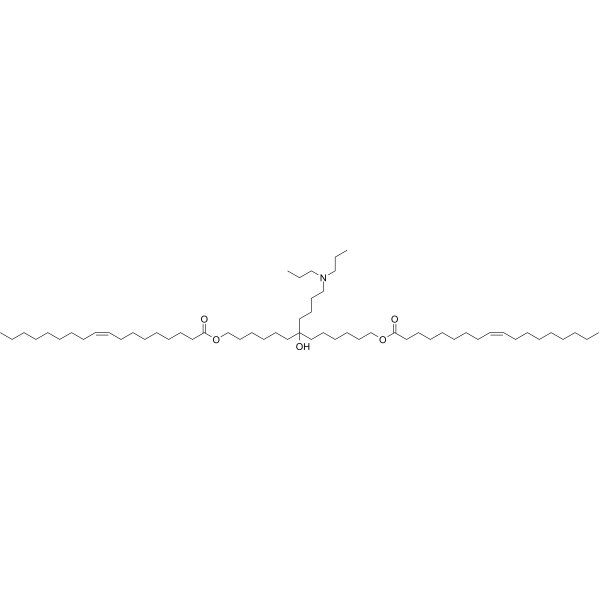
- HY-148049
-
|
|
Liposome
|
Others
|
|
TT3 is an ionizable lipid-like materials for mRNA and CRISPR/Cas9 delivery .
|
-
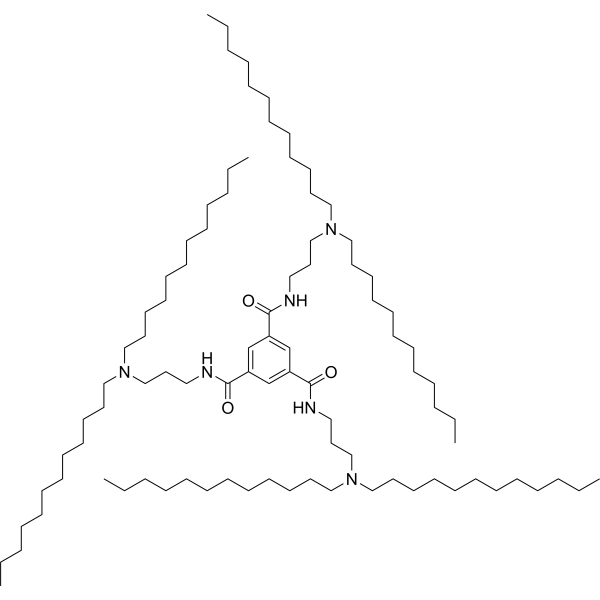
- HY-W591381
-
|
|
Others
|
Others
|
|
DSG-PEG is a type of polyethylene glycol grease. DSG-PEG can be used to prepare liposomes .
|
-
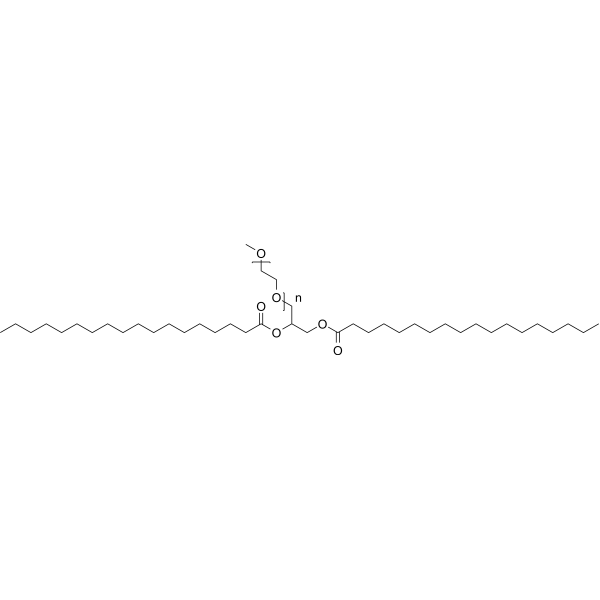
- HY-W590683
-
|
|
Liposome
CRISPR/Cas9
|
Others
|
|
9A1P9 is a multi-tail ionizable cationic phospholipid. 9A1P9 induces membrane destabilization. 9A1P9 can be used for CRISPR-Cas9 gene editing in mice .
|
-
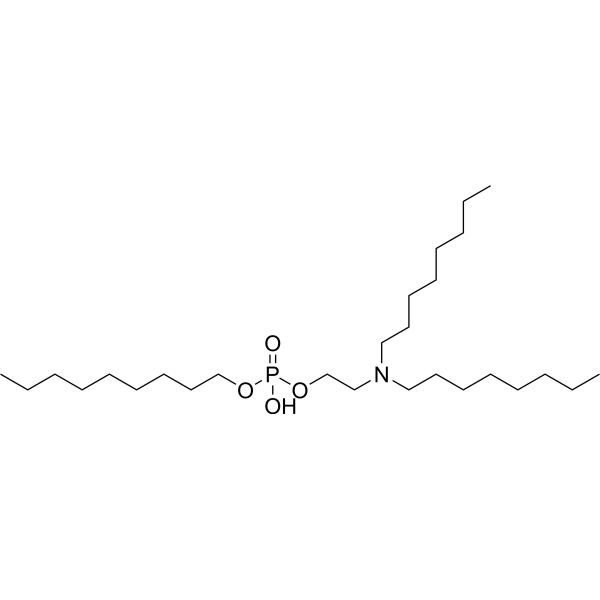
- HY-W440916
-
|
|
Liposome
|
|
|
DSPE-PEG-FITC, MW 3400 is a fluorescein attached PEG lipid. It can be used to prepare liposomes as drug carrier in targeted drug delivery. The polymer is modified with fluorescein (green) dye which can be used for staining cells, tissues, biomarkers, or nanoparticles.
|
-
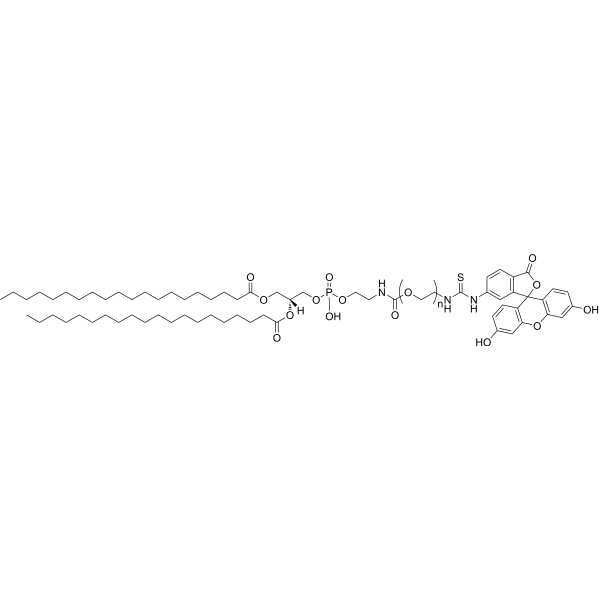
- HY-W440915
-
|
|
Liposome
|
|
|
DSPE-PEG-FITC, MW 2000 is a fluorescein attached PEG lipid. It can be used to prepare liposomes as drug carrier in targeted drug delivery. The polymer is modified with fluorescein (green) dye which can be used for staining cells, tissues, biomarkers, or nanoparticles.
|
-
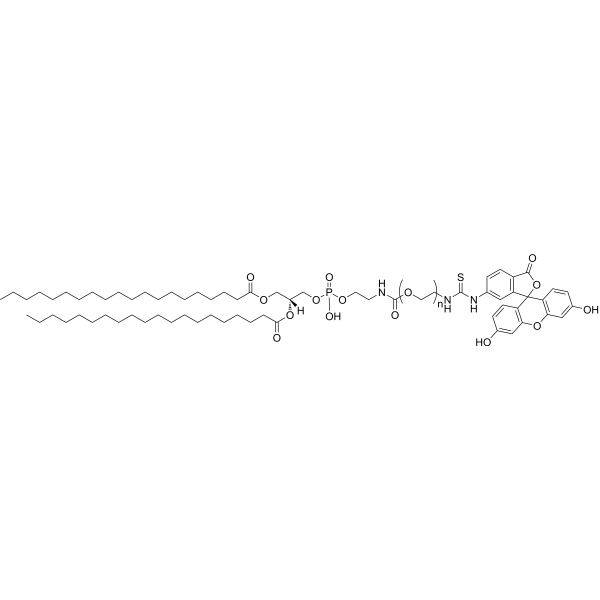
- HY-W440917
-
|
|
Liposome
|
|
|
DSPE-PEG-FITC, MW 5000 is a fluorescein attached PEG lipid. It can be used to prepare liposomes as drug carrier in targeted drug delivery. The polymer is modified with fluorescein (green) dye which can be used for staining cells, tissues, biomarkers, or nanoparticles.
|
-
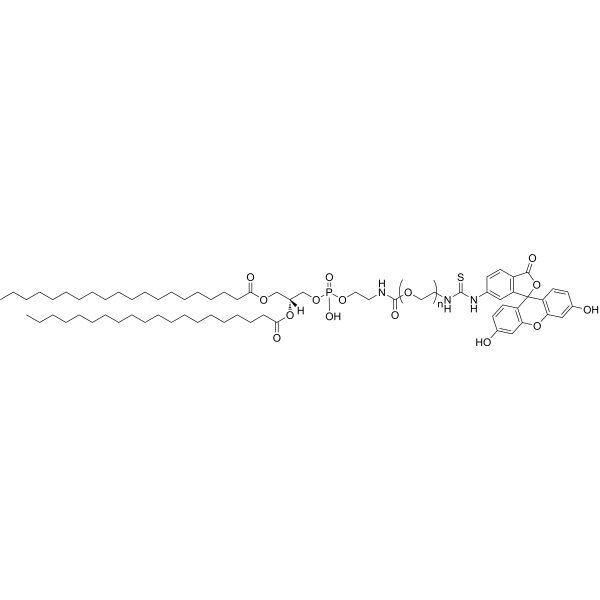
- HY-154971
-
|
|
Apoptosis
|
Cancer
|
|
Ara-SH is a Cytarabine mercaptopropionic acid-substituted derivative. Ara-SH is used as the trigger to fabricate a smart Cytarabine and Venetoclax-coloaded nanoparticle (AV-NP) through self-assembly. Ara-SH exhibits remarkable synergistic antileukemia effects in vitro and in vivo .
|
-
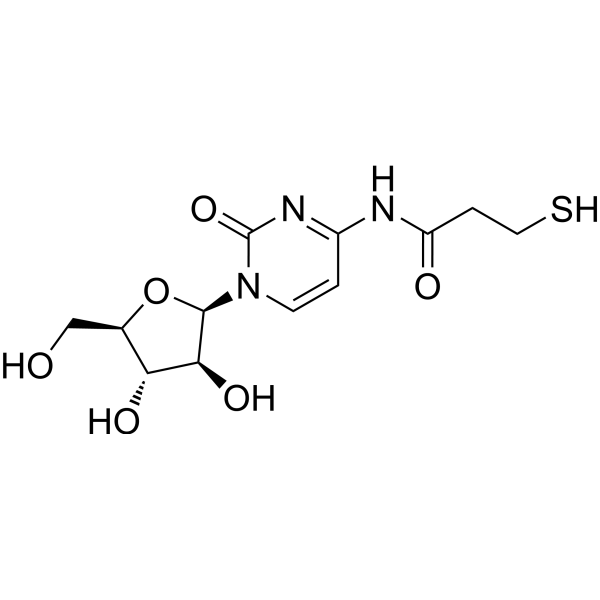
- HY-142981
-
|
DODA
|
Biochemical Assay Reagents
|
Others
|
|
Dioctadecylamine (DODA) is a secondary amine that has been shown to self-organize in plate-like structures in aqueous solution. Dioctadecylamine exhibits sufficiently hydrophobic properties of nanoparticles and good dispersibility in nonpolar solvent. Dioctadecylamine does not form a monolayer above pH 3.9 .
|
-

- HY-W440921
-
|
|
Liposome
|
|
|
DSPE-PEG-Rhodamine, MW 5000 is a phospholipid polyPEG with red fluorescent. The polymer can form lipid bilayer and be used to prepare nanoparticles or liposomes for targeted drug delivery. Rhodamine has maximum absorption at 570 nm and emission around 595 nm and can be easily traced using an imaging technique.
|
-
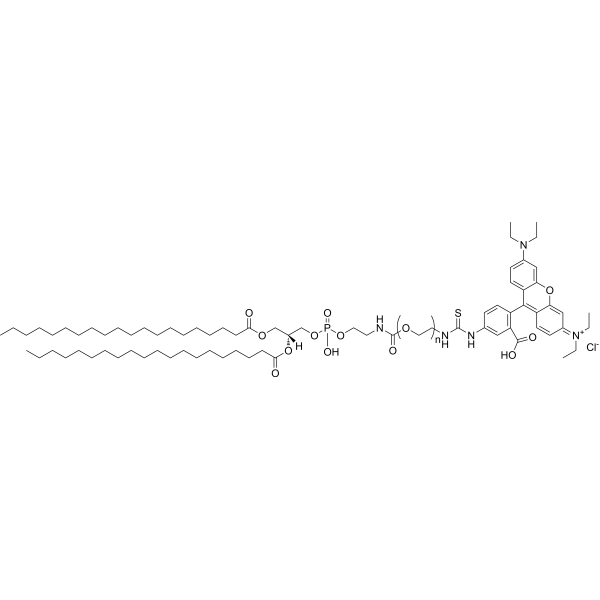
- HY-W440920
-
|
|
Liposome
|
|
|
DSPE-PEG-Rhodamine, MW 3400 is a phospholipid polyPEG with red fluorescent. The polymer can form lipid bilayer and be used to prepare nanoparticles or liposomes for targeted drug delivery. Rhodamine has maximum absorption at 570 nm and emission around 595 nm and can be easily traced using an imaging technique.
|
-

- HY-155788
-
|
|
Biochemical Assay Reagents
|
Others
|
|
DSPE-PEG-DBCO ammonium is the ammonium salt form of DSPE-PEG-DBCO. DSPE-PEG-DBCO ammonium is utilized in copper-free click chemistry through SPAAC conjugation with an azido-functionalized peptide ligand. DSPE-PEG-DBCO ammonium is applied in drug-delivery and nanoparticle research .
|
-

- HY-148701
-
|
|
Liposome
|
Cancer
|
|
mono-Pal-MTO is a palm oil-based lipid produced by combining the anticancer agent mitoxantrone (MTO) with palmitoleic acid. When nanoparticles of mono-Pal-MTO and di-Pal-MTO are combined in a molar ratio of 1:1, they show effective siRNA cell delivery and enhance anticancer activity .
|
-
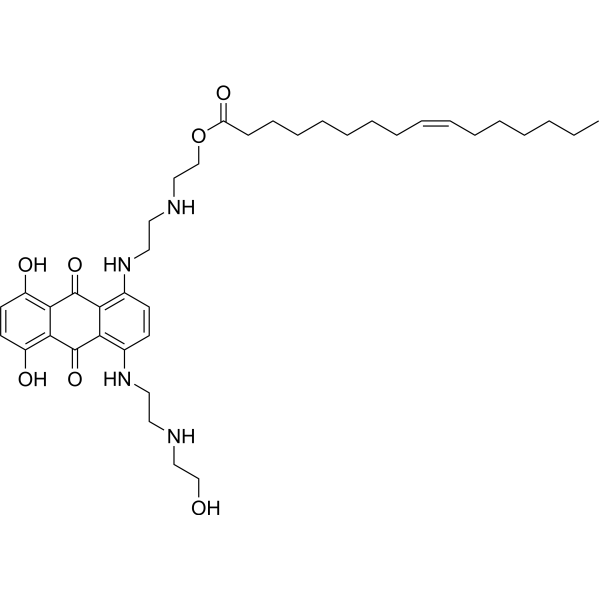
- HY-148702
-
|
|
Liposome
|
Cancer
|
|
di-Pal-MTO is a palm oil-based lipid produced by combining the anticancer agent mitoxantrone (MTO) with palmitoleic acid. When nanoparticles of mono-Pal-MTO and di-Pal-MTO are combined in a molar ratio of 1:1, they show effective siRNA cell delivery and enhance anticancer activity .
|
-
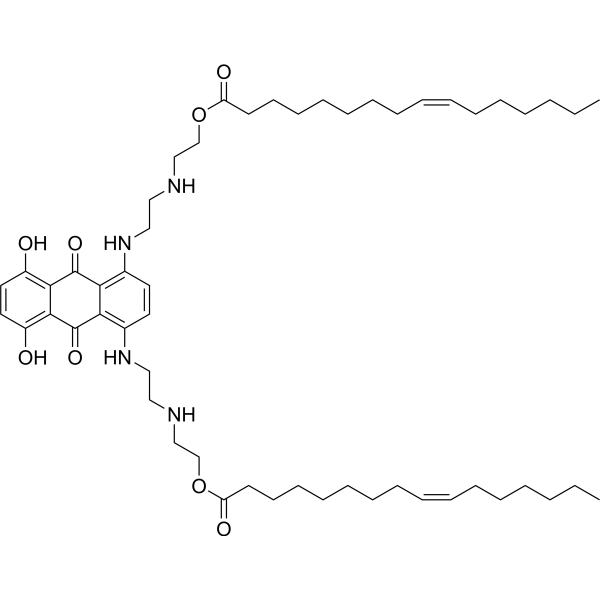
- HY-153136
-
|
|
Liposome
|
Others
|
|
LNP Lipid-1 (Method B) is a lipid compound. LNP Lipid-1 is involved in the synthesis of lipid nanoparticles compositions. LNP Lipid-1 has potential applications in the transport of biologically active substances such as small molecule agents, proteins, and nucleic acids .
|
-

- HY-P10052
-
|
|
VEGFR
|
Cancer
|
|
CBO-P11 specifically binds to receptor of VEGFR-2 and is used as targeting ligand for tumor angiogenesis. CBO-P11 is modified with a nearinfrared cyanine dye bearing an alkyne function, allowing both “click” coupling on azido-modified nanoparticles and fluorescence labelling .
|
-

- HY-W440909
-
|
|
Liposome
|
|
|
DSPE-PEG-Cy3, MW 3400 is a phospholipid PEG polymer with Cy3 dye used in labeling and fluorescence microscopy. The polymer can self-assemble in aqueous solution to form micelles/lipid bilayer and used to prepare liposomes or nanoparticles for nutrients delivery such as mRNA or DNA vaccine.
|
-
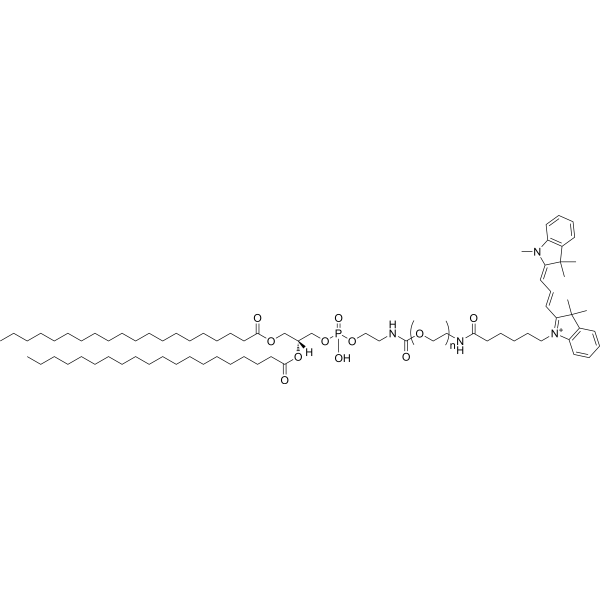
- HY-W440910
-
|
|
Liposome
|
|
|
DSPE-PEG-Cy3, MW 5000 is a phospholipid PEG polymer with Cy3 dye used in labeling and fluorescence microscopy. The polymer can self-assemble in aqueous solution to form micelles/lipid bilayer and used to prepare liposomes or nanoparticles for nutrients delivery such as mRNA or DNA vaccine.
|
-
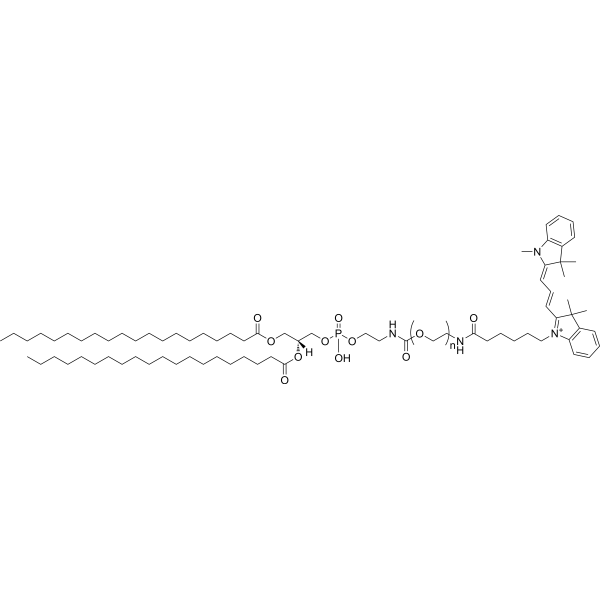
- HY-151506
-
|
|
Liposome
|
Cancer
|
|
Phospholipid PL1 is a phospholipid-derived nanoparticle, can deliver costimulatory receptor mRNA (CD137 or OX40) to T cells. Phospholipid PL1 could induce the activation of various immune cells, including T cells and dendritic cells (DCs) in order to boost antitumor immunity .
|
-
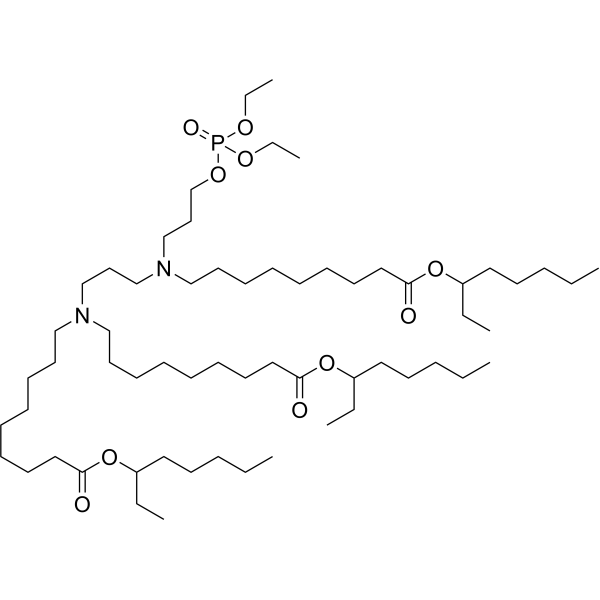
- HY-W440913
-
|
|
Liposome
|
|
|
DSPE-PEG-Cy5, MW 5000 is a PEG phospholipid with Cy5 dye used in protein/nucelic acid labeling and fluorescence microscopy. The polymer can self-assemble in aqueous solution to form micelles/lipid bilayer and used to prepare liposomes or nanoparticles for nutrients delivery such as mRNA or DNA vaccine.
|
-
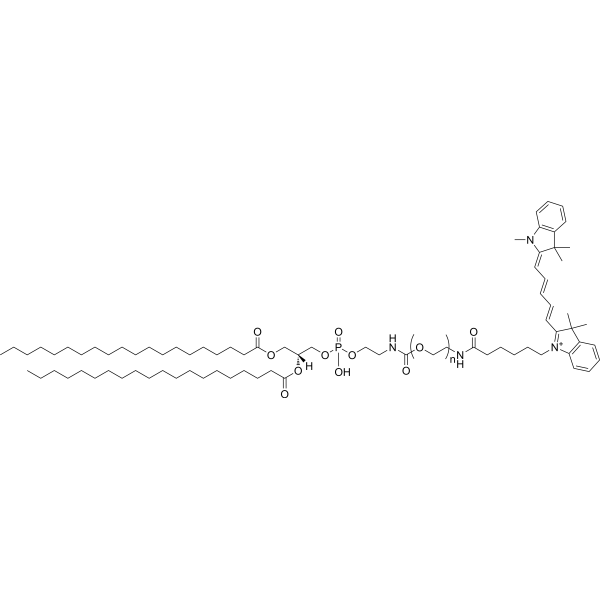
- HY-W440912
-
|
|
Liposome
|
|
|
DSPE-PEG-Cy5, MW 3400 is a PEG phospholipid with Cy5 dye used in protein/nucelic acid labeling and fluorescence microscopy. The polymer can self-assemble in aqueous solution to form micelles/lipid bilayer and used to prepare liposomes or nanoparticles for nutrients delivery such as mRNA or DNA vaccine.
|
-
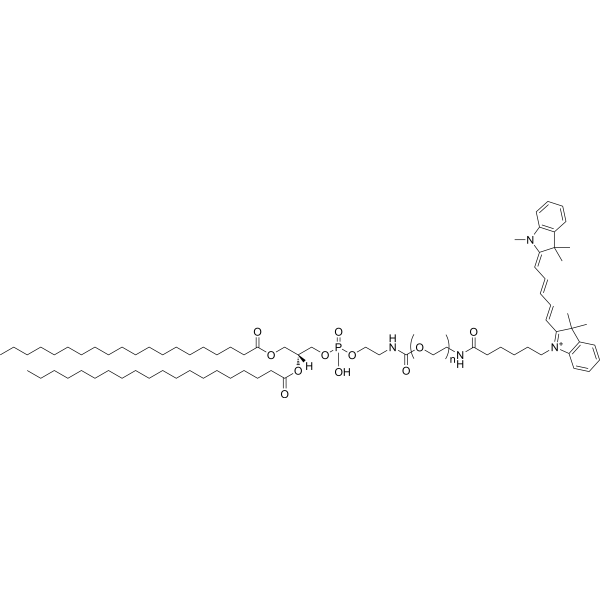
- HY-W440683
-
|
|
Liposome
|
Others
|
|
C13-112-tetra-tail is a cationic lipid-like compound containing a polar amino alcohol head group, four hydrophobic carbon-13 tails, and a PEG2 linker. C13-112-tetra-tail can be formulated into a lipid nanoparticle (LNP).
|
-

- HY-W440681
-
|
|
Liposome
|
Others
|
|
C13-112-tri-tail is a cationic lipid-like compound containing a polar amino alcohol head group, three hydrophobic carbon-13 tails, and a PEG2 linker. C13-112-tri-tail can be formulated into a lipid nanoparticle (LNP).
|
-

- HY-W440684
-
|
|
Liposome
|
Others
|
|
C13-113-tetra tail is a cationic lipid-like compound containing a polar amino alcohol head group, four hydrophobic carbon-13 tails, and a tertiary amine linker. C13-113-tetra tail can be formulated into a lipid nanoparticle (LNP).
|
-
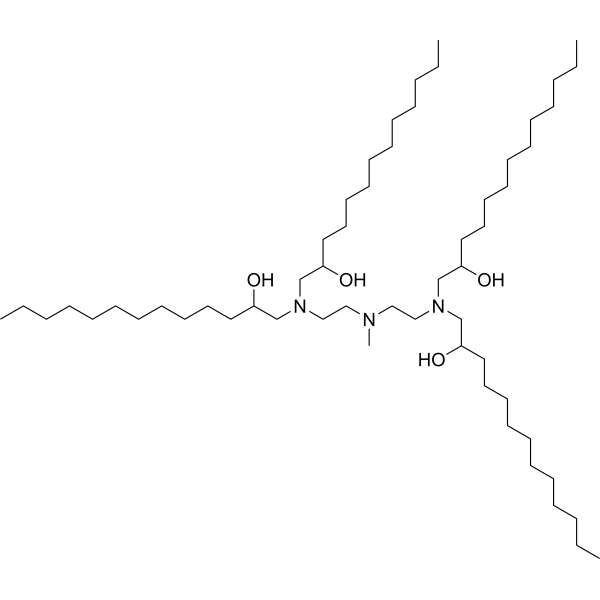
- HY-W440682
-
|
|
Liposome
|
Others
|
|
C13-113-tri tail is a cationic lipid-like compound containing a polar amino alcohol head group, three hydrophobic carbon-13 tails, and a tertiary amine linker. C13-113-tri tail can be formulated into a lipid nanoparticle (LNP).
|
-
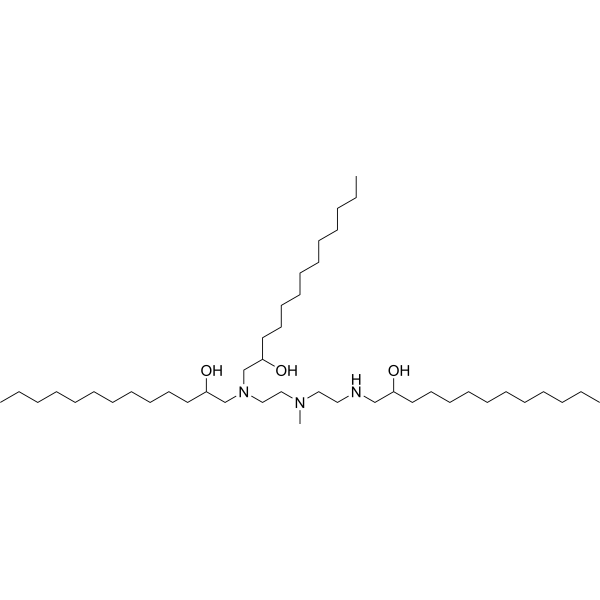
- HY-152229
-
|
|
Liposome
|
Cancer
|
|
G0-C14 is a cationic lipid-like compound alkyl-modified polyamidoamine (PAMAM) dendrimer. G0-C14 involves in the preparation of a series of macrophage-targeted nanoparticles (NPs). NPs can be used for agent and vaccine delivery .
|
-
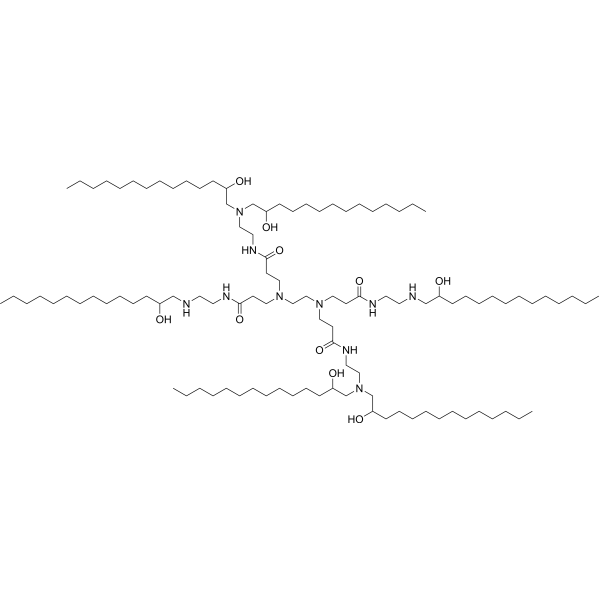
- HY-D1600
-
|
|
Fluorescent Dye
|
Others
|
|
Sulfo-Cyanine5.5 maleimide potassium is a fluorescent dye. Sulfo-Cyanine5.5 is a nearinfrared (NIR) fluorophore with excitation maximum 675 nm and emission maximum 694 nm. Sulfo-Cyanine5.5 maleimide potassium can be used for the labeling of sensitive proteins, nanoparticles, and highly hydrophylic biopolymers .
|
-
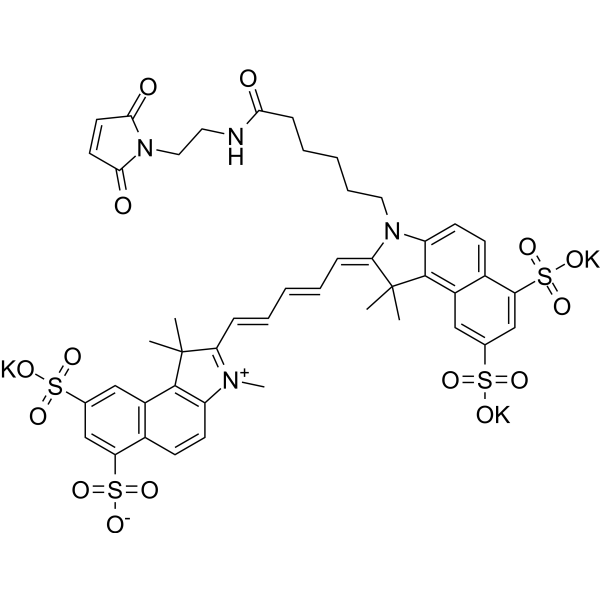
- HY-W440936
-
|
|
Liposome
|
|
|
Stearic acid-PEG-Rhodamine, MW 5000 is a fatty acid containing PEG polymer which can self assemble in an aqueous solution to form micelles. The polymer can be used to prepare nanoparticles for drug encapsulation. The red dye rhodamine can be easily traced by fluorescence microscopy. Rhodamine has maximum absorption at 570 nm and emission around 595 nm.
|
-

- HY-W440935
-
|
|
Liposome
|
|
|
Stearic acid-PEG-Rhodamine, MW 3400 is a fatty acid containing PEG polymer which can self assemble in an aqueous solution to form micelles. The polymer can be used to prepare nanoparticles for drug encapsulation. The red dye rhodamine can be easily traced by fluorescence microscopy. Rhodamine has maximum absorption at 570 nm and emission around 595 nm.
|
-
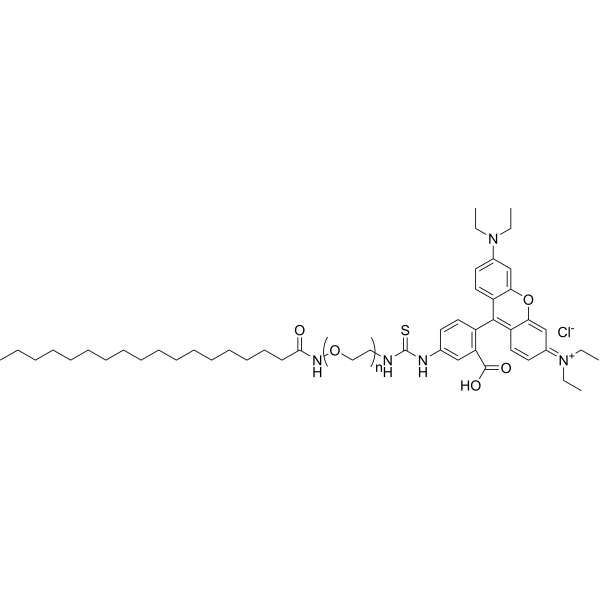
- HY-130407
-
|
|
PROTAC Linkers
|
Cancer
|
|
Lipoamido-PEG3-OH is a PEG-based PROTAC linker can be used in the synthesis of PROTACs. Lipoamido-PEG3-OH (compound TA-TEG-G2CN) can be used in the formation of a highly stable, dendronized gold nanoparticle (AuNP)-based drug delivery platform .
|
-

- HY-W440938
-
|
|
Liposome
|
|
|
Stearic acid-PEG-FITC, MW 2000 is an amphiphatic polyPEG which can self assemble to form micelles in water. The polymer can be used to encapsulate therapeutic agent. FITC is a green dye with peak absorption at 494 nm and maximum emission at 520 nm and can be used for staining biological samples or nanoparticles. FITC can be easily traced by fluorescence microscopy.
|
-

- HY-160554
-
|
|
Others
|
Infection
Inflammation/Immunology
|
|
C12-113 is a lipidoid delivery agent that can be used to transfect siRNA into cells. C12-113 can also be combined with other lipids to form lipid nanoparticles (LNPs) for the delivery of mRNA encoding the spike glycoprotein of severe acute respiratory syndrome coronavirus 2 (SARS-CoV-2) in mice .
|
-
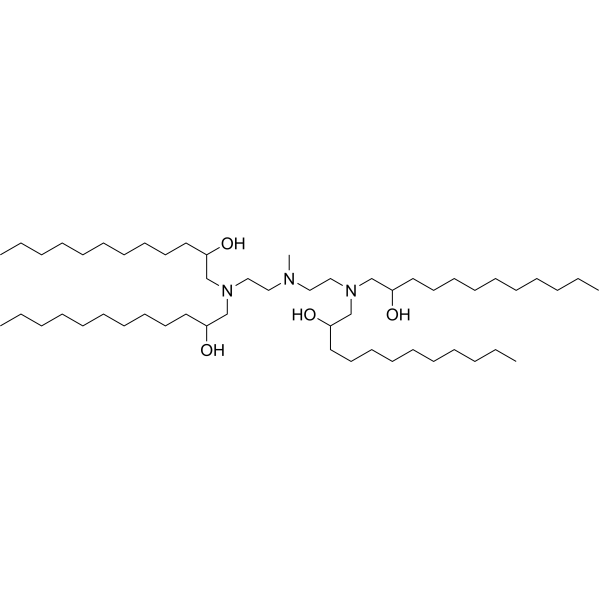
- HY-P1116A
-
|
|
Bacterial
|
Infection
Inflammation/Immunology
|
|
PBP10 is a cell permeable and selective gelsolin-derived peptide inhibitor of formyl peptide receptor 2 (FPR2) over FPR1 . PBP10 is a 10-AA peptide with rhodamine conjugated at its N terminus, exerts bactericidal activity against gram-positive and gram-negative bacteria and limits microbial-induced inflammatory effects .
|
-
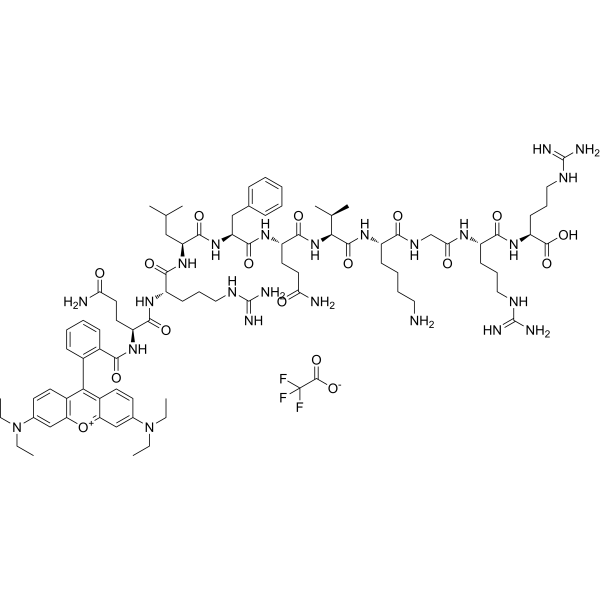
- HY-145411
-
|
|
Liposome
|
Endocrinology
|
|
PEG2000-C-DMG, a pegylated lipid, can be used for the preparation of Onpattro. Onpattro, a hepatically directed investigational RNAi therapeutic agent, harnesses this process to reduce the production of mutant and wild-type transthyretin by targeting the 3′ untranslated region of transthyretin mRNA .
|
-
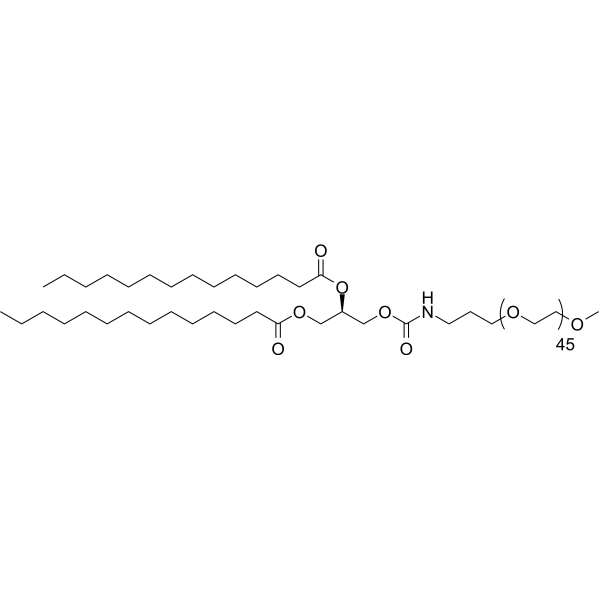
- HY-132141
-
|
5-Propargylamino-dUTP
|
DNA/RNA Synthesis
|
Others
|
|
5-PA-dUTP (5-Propargylamino-dUTP) is a C5-modified nucleotide and can be incorporated into DNA nanoparticles (DNPs) for photosensitizer delivery . 5-PA-dUTP is a click chemistry reagent, it contains an Alkyne group and can undergo copper-catalyzed azide-alkyne cycloaddition (CuAAc) with molecules containing Azide groups.
|
-

- HY-W440940
-
|
|
Liposome
|
|
|
Stearic acid-PEG-FITC, MW 5000 is a PEG lipid which forms micelles in water and can be used for drug delivery applications. The FITC fluorescent can be easily traced by miscroscopy. FITC is a green dye with peak absorption at 494 nm and maximum emission at 520 nm and can be used for staining biological samples or nanoparticles. FITC can be easily traced by fluorescence microscopy.
|
-

- HY-W440939
-
|
|
Liposome
|
|
|
Stearic acid-PEG-FITC, MW 3400 is a PEG lipid which forms micelles in water and can be used for drug delivery applications. The FITC fluorescent can be easily traced by miscroscopy. FITC is a green dye with peak absorption at 494 nm and maximum emission at 520 nm and can be used for staining biological samples or nanoparticles. FITC can be easily traced by fluorescence microscopy.
|
-
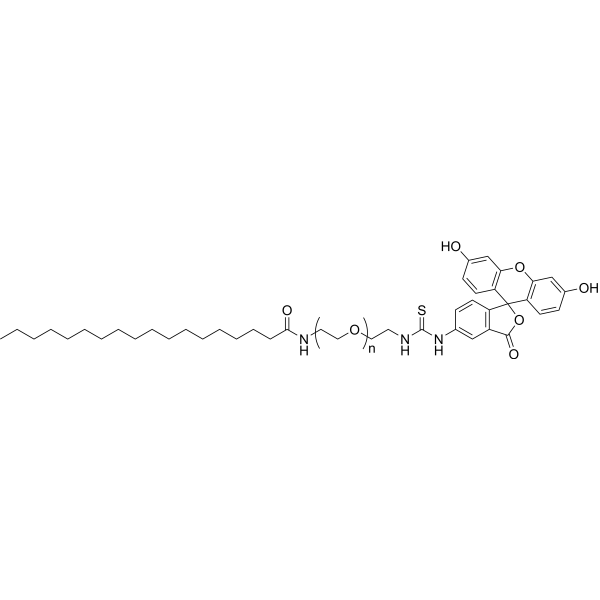
- HY-D0153
-
|
|
Fluorescent Dye
|
Cancer
|
|
Tetramethylrhodamine-5-isothiocyanate is a potent fluorescent dye. Tetramethylrhodamine-5-isothiocyanate can be used for label PG-M3 antibody for rapid diagnosis of acute promyelocytic leukemia (APL). Tetramethylrhodamine-5-isothiocyanate can be used as probe to quantify in vivo the biodistribution of PLGA (poly(lactic-co-glycolic) acid) and PLGA/chitosan nanoparticles .
|
-

- HY-137500
-
|
|
Liposome
|
Neurological Disease
|
|
NT1-014B is a potent NT1-lipidoid encapsulated AmB (amphotericin B). NT1-014B dopes the NT-lipidoids into BBB-impermeable lipid nanoparticles (LNPs) gave the LNPs the ability to cross the BBB. NT1-014B enhances brain delivery through intravenous injection .
|
-
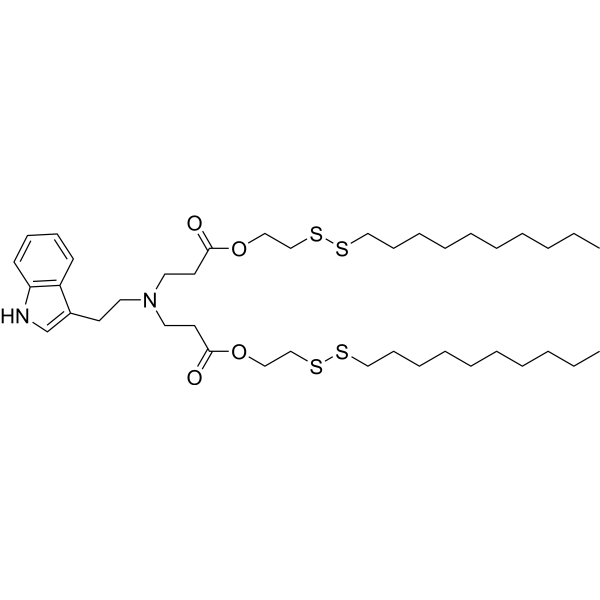
- HY-153231
-
|
|
Fluorescent Dye
Liposome
|
Others
|
|
eGFP mRNA-LNP is a lipid nanoparticle (LNP) containing eGFP mRNA, suitable for assays of RNA delivery, translation efficiency, cell viability, etc. eGFP circRNA carries Enhanced Green Fluorescent Protein (Enhanced Green Fluorescent Protein) eGFP, which will express green fluorescent protein after entering the cell. eGFP is commonly used as a reporter gene detectable by fluorescence microscopy or flow cytometry .
|
-
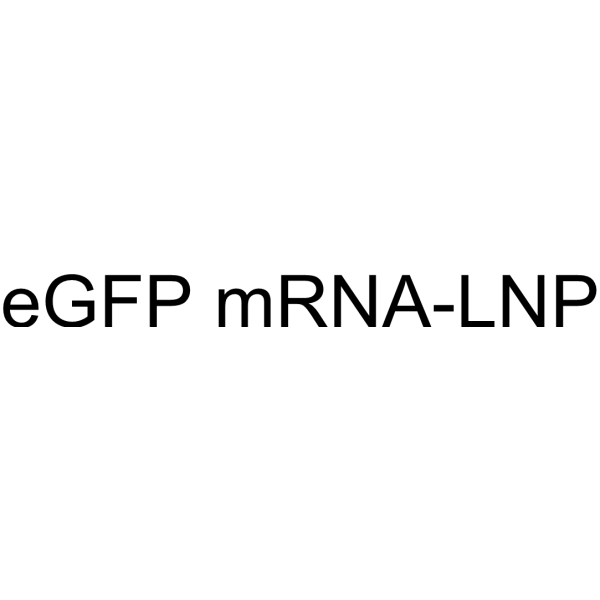
- HY-153232
-
|
|
Fluorescent Dye
Liposome
|
Others
|
|
eGFP circRNA-LNP is a lipid nanoparticle (LNP) containing eGFP circRNA, suitable for assays of RNA delivery, translation efficiency, cell viability, etc. eGFP circRNA carries Enhanced Green Fluorescent Protein (Enhanced Green Fluorescent Protein) eGFP, which will express green fluorescent protein after entering the cell. eGFP is commonly used as a reporter gene detectable by fluorescence microscopy or flow cytometry .
|
-
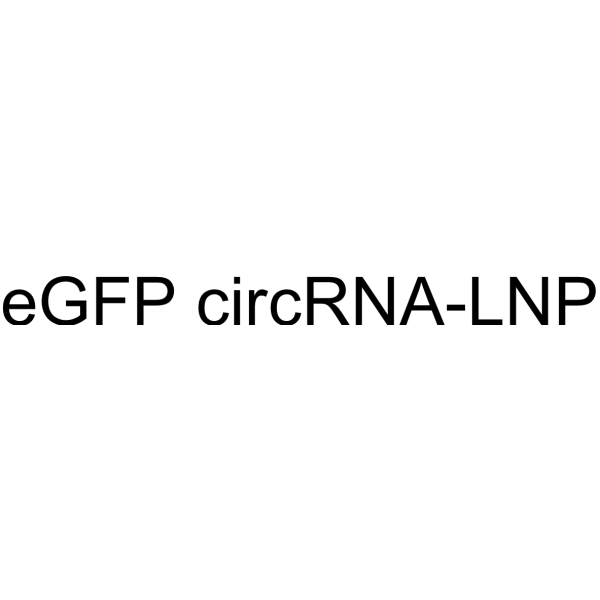
- HY-P99974
-
|
|
Microtubule/Tubulin
Apoptosis
Autophagy
|
Cancer
|
|
Nab-Paclitaxel is an albumin-bound nanoparticle formulation of Paclitaxel (HY-B0015). Nab-Paclitaxel is composed of albumin and the active pharmaceutical ingredient Paclitaxel (Paclitaxel: human albumin=1:9), in which human albumin is used as an excipient to disperse and stabilize particles and carry the main drug. Nab-Paclitaxel was associated with higher response rates and better tolerability, with favorable pharmacokinetic properties .
|
-
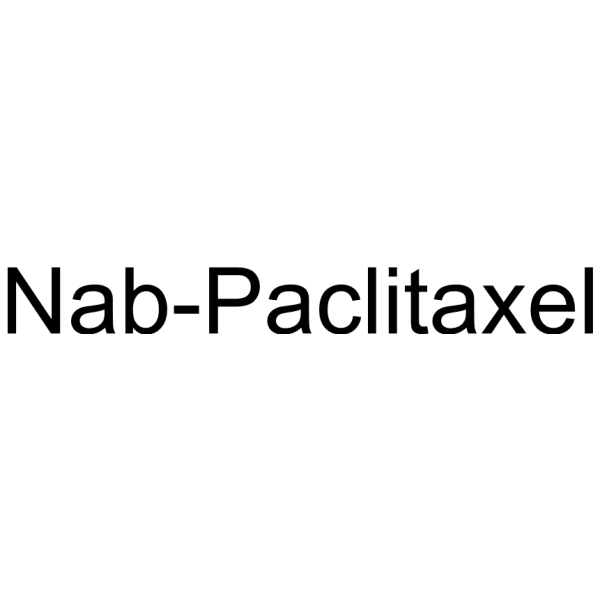
- HY-160269
-
|
|
Fluorescent Dye
|
Others
|
|
DSPE-PEG-Fluor 488,MW 2000 is a PEG-dye-lipid conjugate consisting of a DSPE phospholipid and a Fluor 488 dye. DSPE is a phospholipid that spontaneously forms micelles in a water medium, and Fluor 488 is a cyanine dye that is widely used in fluorescence microscopy. Fluor 488 has excitation and emission maxima at 499 nm and 520 nm. Polyethylene glycol lipids are commonly used for the stabilization of lipid nanoparticles .
|
-
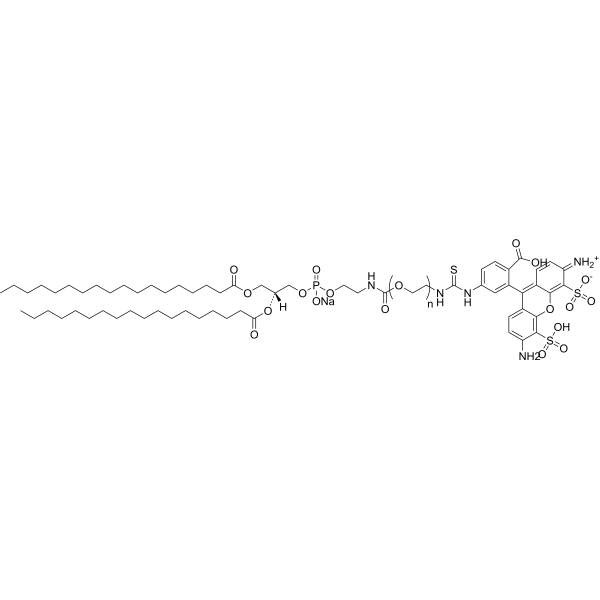
- HY-145405
-
C12-200
5 Publications Verification
|
Liposome
|
Others
|
|
C12-200 is an ionizable cationic lipid and auxiliary lipid. C12-200 is commonly used for mRNA delivery. Administration of human erythropoietin (EPO) mRNA or factor VII siRNA increased and decreased serum factor VII levels, respectively, in LNPs mice containing C12-200 .
|
-
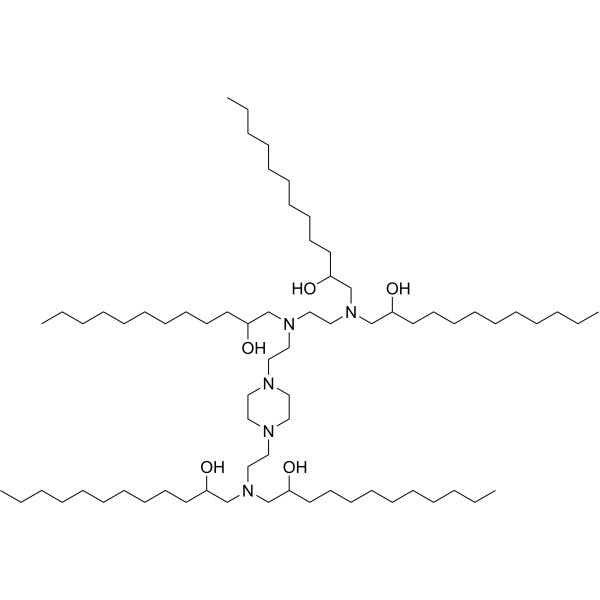
- HY-147112
-
-
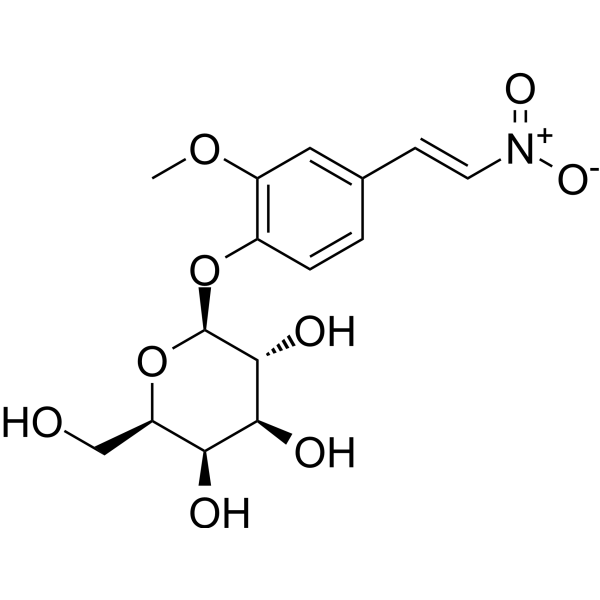
- HY-112758
-
|
|
Liposome
|
Others
|
|
DLin-KC2-DMA is an ionisable cationic lipid (pKa≈6) that is virtually non-toxic to antigen presenting cells (APCs). DLin-KC2-DMA produces significant siRNA-mediated gene silencing of GAPDH, when binds to lipid nanoparticles (LNP). DLin-KC2-DMA can be used in siRNA delivery studies .
|
-

- HY-112624B
-
|
|
Biochemical Assay Reagents
|
Others
|
|
Dextran (MW 70000) is a complex carbohydrate polymer consisting of glucose molecules linked by glycosidic bonds. Dextran has excellent solubility in water, making it useful as a viscosity modifier or stabilizer in foods, paints and adhesives. In the biomedical field, dextran is often used as a plasma expander because of its ability to increase blood volume when administered intravenously. It can also be modified to create dextran-based drug delivery systems, such as targeted nanoparticles.
|
-
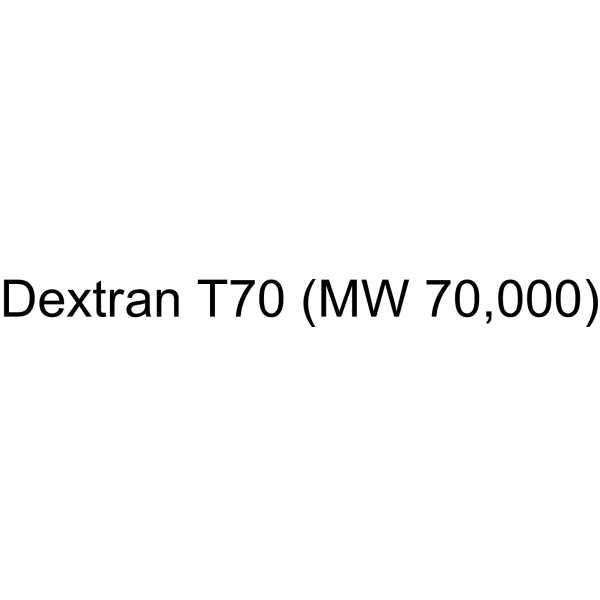
- HY-112624C
-
|
|
Biochemical Assay Reagents
Endogenous Metabolite
|
Others
|
|
Dextran (MW 40000) is a complex carbohydrate polymer consisting of glucose molecules linked by glycosidic bonds. Dextran has excellent solubility in water, making it useful as a viscosity modifier or stabilizer in foods, paints and adhesives. In the biomedical field, dextran is often used as a plasma expander because of its ability to increase blood volume when administered intravenously. It can also be modified to create dextran-based drug delivery systems, such as targeted nanoparticles.
|
-
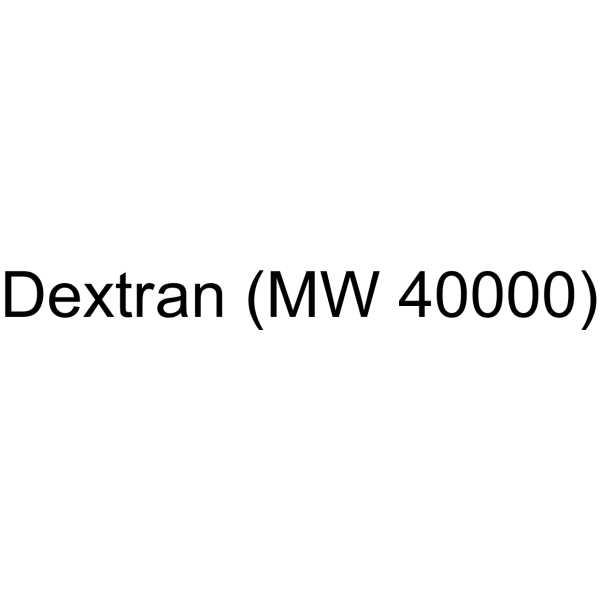
- HY-W440832
-
|
|
Liposome
|
Infection
|
|
DSPE-PEG-Azide, MW 2000 is an azide containing lipid that can be used to form micelles as nanoparticles for drug delivery . DSPE-PEG-Azide, MW 2000 is a click chemistry reagent, it contains an Azide group and can undergo copper-catalyzed azide-alkyne cycloaddition reaction (CuAAc) with molecules containing Alkyne groups. Strain-promoted alkyne-azide cycloaddition (SPAAC) can also occur with molecules containing DBCO or BCN groups.
|
-

- HY-D0948
-
|
|
Fluorescent Dye
|
Infection
|
|
Celestine Blue is a electroactive indicator in DNA biosensors. Celestine Blue is strongly adsorbed on the spinel phases and CNT (carbon nanotubes), facilitates dispersion, acts as a capping agent and allows for the fabrication of spinel decorated CNT. Celestine Blue is an efficient charge transfer mediator, which allows for significant improvement of capacitive behavior. TiO2 nanoparticles doped with Celestine Blue can be used as a label in a sandwich immunoassay for the hepatitis C virus (HCV) core antigen .
|
-

- HY-N2894
-
|
|
Parasite
|
Infection
|
|
Piperolactam A is a natural product that can be isolated from root of Piper betle. Piperolactam A exhibits promising leishmanicidal action against wild type and drug resistant strains of Leishmania donovani .
|
-
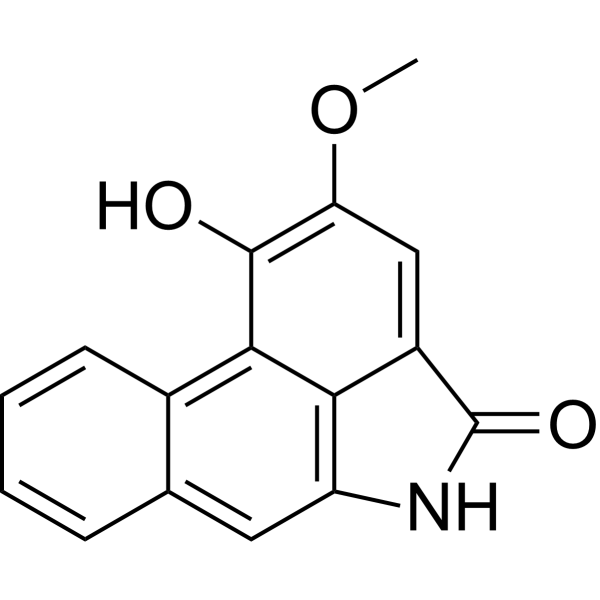
- HY-137499
-
|
|
Liposome
Endogenous Metabolite
|
Neurological Disease
|
|
NT1-O12B, an endogenous chemical and a neurotransmitter-derived lipidoid (NT-lipidoid), is an effective carrier for enhanced brain delivery of several blood-brain barrier (BBB)-impermeable cargos. Doping NT1-O12B into BBB-impermeable lipid nanoparticles (LNPs) gives the LNPs the ability to cross the BBB. NT-lipidoids formulation not only facilitate cargo crossing of the BBB, but also delivery of the cargo into neuronal cells for functional gene silencing or gene recombination .
|
-
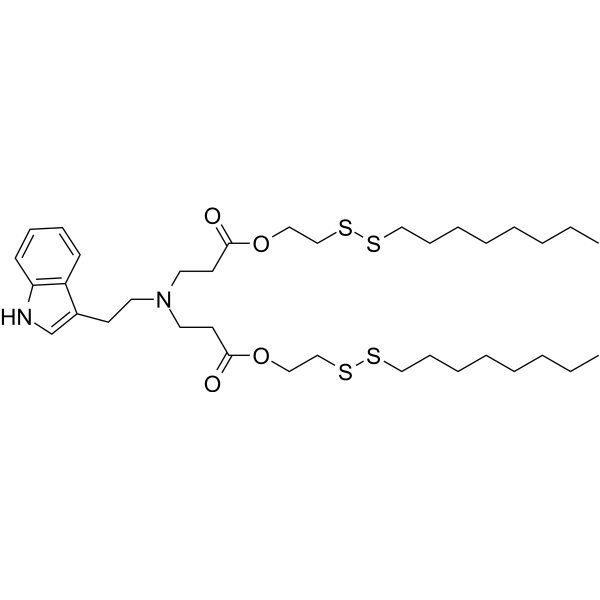
- HY-148775
-
|
|
Biochemical Assay Reagents
|
Others
|
|
PLGA-PEG-MAL (60kDA-3.4kDA, LA:GA ratio 75:25) is a kind of poly(lactide-co-glycolide)-block-poly(ethylene glycol) (PLGA-PEG-Mal) nanoparticles. PLGA-PEG-MAL (60kDA-3.4kDA, LA:GA ratio 75:25) has a molecular weight of 60kDA to 3.4kDA and contains a 75:25 ratio of lactic acid (LA) to glycolic acid (GA) molecules .
|
-

- HY-131119
-
|
Dioctadecyldimethylammonium bromide; DODAB
|
Liposome
|
Others
|
|
Dimethyldioctadecylammonium bromide is a synthetic cationic lipid commonly used in gene delivery and vaccine development. Also known as DODAB or DDAB, it consists of a positively charged ammonium head group and two long hydrophobic tails. These properties make it useful for forming liposomes and other lipid-based nanoparticles that can efficiently deliver genetic material into cells. In addition to its applications in biotechnology, DDAB is also used in surfactants, emulsifiers and fabric softeners. However, due to its potential toxicity and irritation, extreme care should be taken when handling DDAB.
|
-
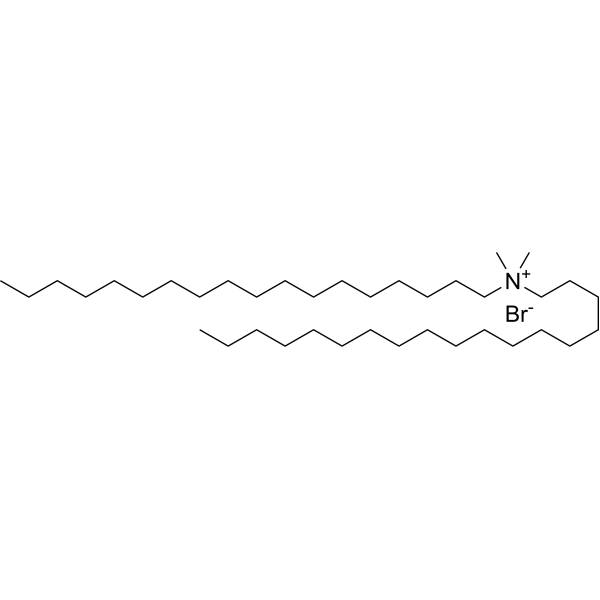
- HY-W010572
-
|
alpha-Thioglycerol
|
Biochemical Assay Reagents
|
Others
|
|
1-Thioglycerol, commonly used as a reducing agent in various biochemical and biophysical applications, especially in protein chemistry and molecular biology, it can protect proteins from oxidation and denaturation, and can reduce disulfide bonds to thiols base, which can then be modified or analyzed. In addition, 1-Thioglycerol has been investigated for potential medical applications, including as an inhibitor of cystic fibrosis, which may help improve the function of lung cells, and has also been studied for Used in the preparation of metal nanoparticles and as a stabilizer for certain pharmaceutical preparations.
|
-

- HY-148775B
-
|
|
Biochemical Assay Reagents
|
Others
|
|
PLGA-PEG-MAL (20kDA-5.0kDA, LA:GA ratio 40:60) is a kind of poly(lactide-co-glycolide)-block-poly(ethylene glycol) (PLGA-PEG-Mal) nanoparticles. PLGA-PEG-MAL (20kDA-5.0kDA, LA:GA ratio 40:60) has a molecular weight of 60kDA to 3.4kDA and contains a 75:25 ratio of lactic acid (LA) to glycolic acid (GA) molecules .
|
-
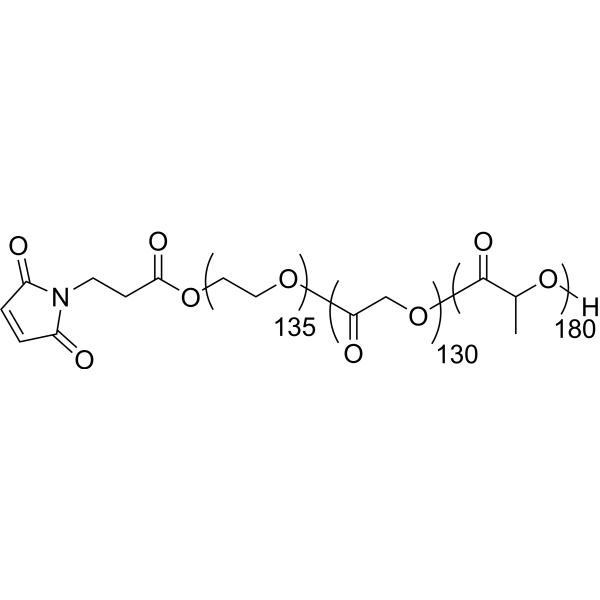
- HY-W040193S
-
|
1,2-Distearoyl-sn-glycero-3-PC-d70; DSPC-d70
|
Isotope-Labeled Compounds
Liposome
|
Others
|
|
1,2-Distearoyl-sn-glycero-3-phosphorylcholine-d70 is the deuterium labeled 1,2-Distearoyl-sn-glycero-3-phosphorylcholine. 1,2-Distearoyl-sn-glycero-3-phosphorylcholine (1,2-Distearoyl-sn-glycero-3-PC; DSPC) is a cylindrical-shaped lipid. 1,2-Distearoyl-sn-glycero-3-phosphorylcholine is used to synthesize liposomes, and is the lipid component in the lipid nanoparticle (LNP) system[1][2].
|
-

- HY-N2362S2
-
|
DL-2-Aminopropionic acid-d3
|
Endogenous Metabolite
|
Metabolic Disease
|
|
DL-Alanine-d3 is the deuterium labeled DL-Alanine. DL-alanine, an amino acid, is the racemic compound of L- and D-alanine. DL-alanine is employed both as a reducing and a capping agent, used with silver nitrate aqueous solutions for the production of nanoparticles. DL-alanine can be used for the research of transition metals chelation, such as Cu(II), Zn(II), Cd(11). DL-alanine, a sweetener, is classed together with glycine, and sodium saccharin. DL-alanine plays a key role in the glucose-alanine cycle between tissues and liver[1][2][3][4][5][6].
|
-

- HY-W040193S3
-
|
1,2-Distearoyl-sn-glycero-3-PC-d83; DSPC-d83
|
Isotope-Labeled Compounds
Liposome
|
Others
|
|
1,2-Distearoyl-sn-glycero-3-phosphorylcholine-d83 is deuterium labeled 1,2-Distearoyl-sn-glycero-3-phosphorylcholine. 1,2-Distearoyl-sn-glycero-3-phosphorylcholine (1,2-Distearoyl-sn-glycero-3-PC; DSPC) is a cylindrical-shaped lipid. 1,2-Distearoyl-sn-glycero-3-phosphorylcholine is used to synthesize liposomes, and is the lipid component in the lipid nanoparticle (LNP) system[1][2].
|
-

- HY-W250187
-
|
|
Biochemical Assay Reagents
|
Others
|
|
DDMAB, or didodecyldimethylammonium bromide, is a cationic surfactant commonly used in a variety of industrial and research applications. It belongs to the family of quaternary ammonium compounds and has a positively charged head and a hydrophobic tail, which allows it to be used as a detergent, emulsifier and antimicrobial. Known for its ability to disrupt cell membranes, DDMAB is commonly used in microbiology to selectively isolate and identify bacteria. It is also used in nanotechnology to synthesize metal nanoparticles and other materials. In addition, DDMAB has the ability to interact with and penetrate cell membranes, which has potential applications in drug delivery, gene therapy, and other medical fields.
|
-

- HY-N2362S
-
|
DL-2-Aminopropionic acid-13C-1
|
Endogenous Metabolite
|
Metabolic Disease
|
|
DL-Alanine- 13C-1 is the 13C-labeled DL-Alanine. DL-alanine, an amino acid, is the racemic compound of L- and D-alanine. DL-alanine is employed both as a reducing and a capping agent, used with silver nitrate aqueous solutions for the production of nanoparticles. DL-alanine can be used for the research of transition metals chelation, such as Cu(II), Zn(II), Cd(11). DL-alanine, a sweetener, is classed together with glycine, and sodium saccharin. DL-alanine plays a key role in the glucose-alanine cycle between tissues and liver[1][2][3][4][5][6].
|
-
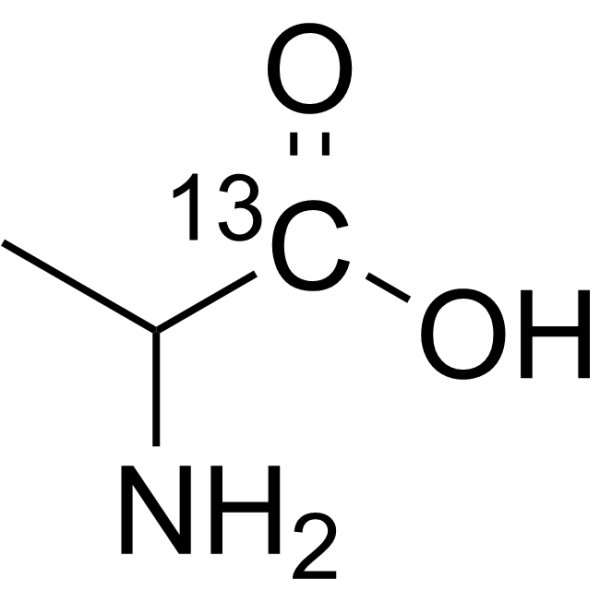
- HY-N2362S1
-
|
DL-2-Aminopropionic acid-13C-3
|
Isotope-Labeled Compounds
Endogenous Metabolite
|
Metabolic Disease
|
|
DL-Alanine- 13C-3 is the 13C-labeled DL-Alanine. DL-alanine, an amino acid, is the racemic compound of L- and D-alanine. DL-alanine is employed both as a reducing and a capping agent, used with silver nitrate aqueous solutions for the production of nanoparticles. DL-alanine can be used for the research of transition metals chelation, such as Cu(II), Zn(II), Cd(11). DL-alanine, a sweetener, is classed together with glycine, and sodium saccharin. DL-alanine plays a key role in the glucose-alanine cycle between tissues and liver[1][2][3][4][5][6].
|
-

- HY-W250308
-
|
Epsilon-polylysine; ε-Polylysine; ε-PL
|
Bacterial
|
Others
|
|
Epsilon-polylysine is an antimicrobial peptide that can be produced by bacteria such as Streptomyces. Epsilon-polylysine inhibits the growth of microorganisms such as bacteria, yeasts and molds and is therefore often used as a green food additive and preservative in various food and beverage products. Epsilon-polylysine has a variety of properties, including thermal stability, resistance to acidic conditions, and broad-spectrum antimicrobial activity. Epsilon-polylysine can be loaded on other materials to form nanoparticles or form nanofiber membranes for targeted delivery to exert sustained antibacterial efficacy. Epsilon-polylysine is also used as a liposome stabilizer .
|
-
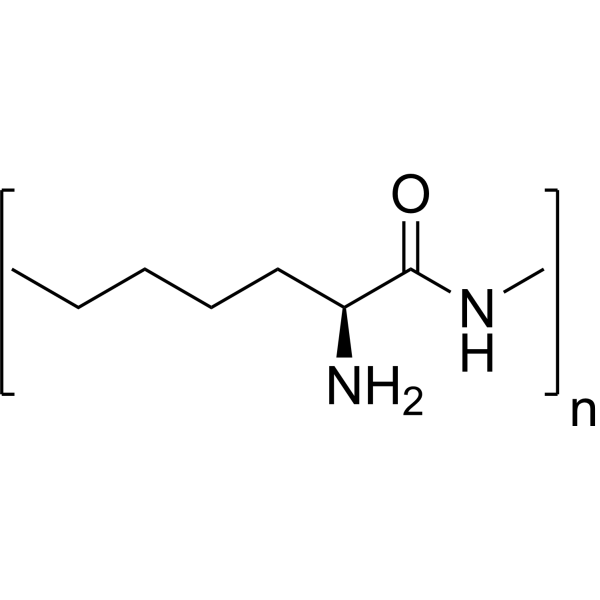
- HY-N2362S5
-
|
DL-2-Aminopropionic acid-15N
|
Endogenous Metabolite
|
Metabolic Disease
|
|
DL-Alanine- 15N is the 15N labeled DL-Alanine[1]. DL-alanine, an amino acid, is the racemic compound of L- and D-alanine. DL-alanine is employed both as a reducing and a capping agent, used with silver nitrate aqueous solutions for the production of nanoparticles. DL-alanine can be used for the research of transition metals chelation, such as Cu(II), Zn(II), Cd(11). DL-alanine, a sweetener, is classed together with glycine, and sodium saccharin. DL-alanine plays a key role in the glucose-alanine cycle between tissues and liver[2][3][4][5][6][7].
|
-
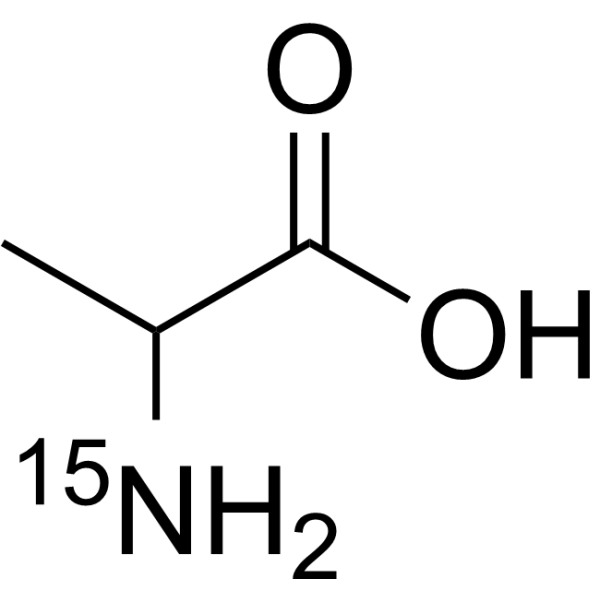
- HY-W013989
-
|
|
Epoxide Hydrolase
|
Cardiovascular Disease
|
|
1,3-Dicyclohexylurea (DCU) is an orally active and potent sEH (soluble epoxide hydrolase) inhibitor. Oral Delivery of 1,3-Dicyclohexylurea nanosuspension enhances exposure and lowers blood pressure in hypertensive Rats .
|
-
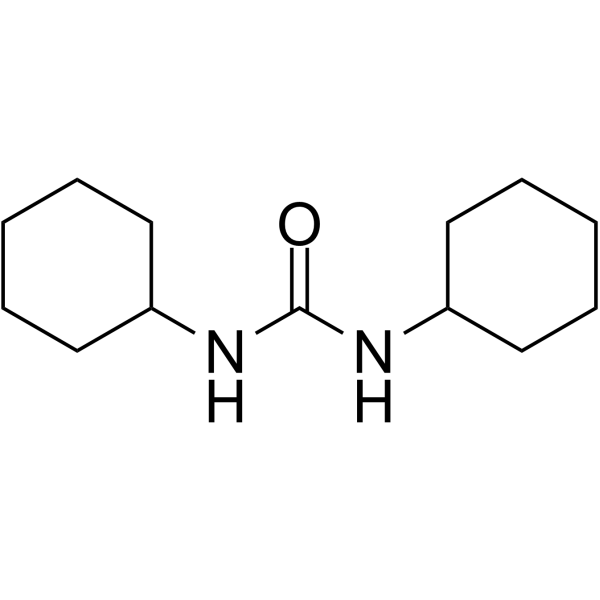
- HY-148776
-
|
|
Biochemical Assay Reagents
|
Others
|
|
PLGA-PEG-MAL (20kDA-5.0kDA, LA:GA ratio 50:50) is a kind of poly(lactide-co-glycolide)-block-poly(ethylene glycol) (PLGA-PEG-Mal) nanoparticles. PLGA-PEG-MAL (20kDA-5.0kDA, LA:GA ratio 50:50) has a molecular weight of 20kDA to 5.0kDA and contains a 50:50 ratio of lactic acid (LA) to glycolic acid (GA) molecules. The molecular ratio of LA to GA determines the rate of matrix degradation and protein re-release .
|
-
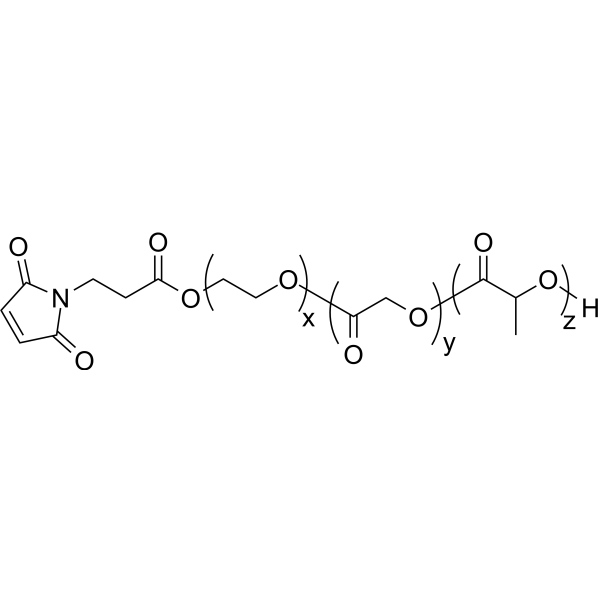
- HY-153234
-
|
|
CD19
Liposome
|
Inflammation/Immunology
Cancer
|
|
CD19 car circRNA-LNP is a lipid nanoparticle (LNP) containing CD19 car circRNA, suitable for detection of RNA delivery, translation efficiency, cell viability, etc. CD19 car circRNA can be used in chimeric antigen receptor T cell immunotherapy (CAR-CD19). The CD19 car is a chimeric antigen receptor. Among them, CD19 is a CD molecule expressed by B cells (i.e. leukocyte differentiation antigen), an important membrane antigen involved in B cell proliferation, differentiation, activation and antibody production, and can also promote BCR signal transduction .
|
-

- HY-153233
-
|
|
CD19
Liposome
|
Inflammation/Immunology
Cancer
|
|
CD19 car mRNA-LNP is a lipid nanoparticle (LNP) containing CD19 car mRNA, suitable for detection of RNA delivery, translation efficiency, cell viability, etc. CD19 car mRNA can be used in chimeric antigen receptor T cell immunotherapy (CAR-CD19). The CD19 car is a chimeric antigen receptor. Among them, CD19 is a CD molecule expressed by B cells (i.e. leukocyte differentiation antigen), an important membrane antigen involved in B cell proliferation, differentiation, activation and antibody production, and can also promote BCR signal transduction .
|
-

| Cat. No. |
Product Name |
Type |
-
- HY-D1540
-
|
Cy 5.5 amine; Lumiprobe Cy 5.5 amine
|
Fluorescent Dyes/Probes
|
|
Cyanine5.5 amine (Cy 5.5 amine), a Cy5.5 Analogue, is a near-infrared (NIR) fluorescent dye (Ex=648 nm, Em=710 nm). Cyanine5.5 amine can be used in the preparation of Cy5.5-labeled nanoparticles, which can be tracked and imaged with low fluorescence background using confocal microscopy .
|
-
- HY-D0948
-
|
|
Dyes
|
|
Celestine Blue is a electroactive indicator in DNA biosensors. Celestine Blue is strongly adsorbed on the spinel phases and CNT (carbon nanotubes), facilitates dispersion, acts as a capping agent and allows for the fabrication of spinel decorated CNT. Celestine Blue is an efficient charge transfer mediator, which allows for significant improvement of capacitive behavior. TiO2 nanoparticles doped with Celestine Blue can be used as a label in a sandwich immunoassay for the hepatitis C virus (HCV) core antigen .
|
-
- HY-D0917
-
|
|
DNA Stain
|
|
TO-PRO 1 is a DNA binding fluorochrome, that atached to the surface of the Feraheme (FH) nanoparticle (NP), to obtain a fluorochrome-functionalized NP. TO-PRO 1 binds DNA through intercalation, and acts as a vital fluorochrome for necrotic cells .
|
-
- HY-D1600
-
|
|
Dyes
|
|
Sulfo-Cyanine5.5 maleimide potassium is a fluorescent dye. Sulfo-Cyanine5.5 is a nearinfrared (NIR) fluorophore with excitation maximum 675 nm and emission maximum 694 nm. Sulfo-Cyanine5.5 maleimide potassium can be used for the labeling of sensitive proteins, nanoparticles, and highly hydrophylic biopolymers .
|
-
- HY-D0153
-
|
|
Fluorescent Dyes/Probes
|
|
Tetramethylrhodamine-5-isothiocyanate is a potent fluorescent dye. Tetramethylrhodamine-5-isothiocyanate can be used for label PG-M3 antibody for rapid diagnosis of acute promyelocytic leukemia (APL). Tetramethylrhodamine-5-isothiocyanate can be used as probe to quantify in vivo the biodistribution of PLGA (poly(lactic-co-glycolic) acid) and PLGA/chitosan nanoparticles .
|
| Cat. No. |
Product Name |
Type |
-
- HY-148648
-
|
|
Drug Delivery
|
|
Lipid 29 is an ionizable amino lipid. Lipid 29 can be used to form lipid nanoparticles .
|
-
- HY-W441014
-
|
|
Drug Delivery
|
|
DSPE-PEG-NHS, MW 2000 is a pegylated phospholipid derivatives which can be used to prepare liposome or lipid nanoparticles for targeted drug delivery system, such as DNA or mRNA vaccine.
|
-
- HY-141629
-
|
Sphingomyelin 16:0
|
Drug Delivery
|
|
N-Palmitoyl-D-sphingomyelin (Sphingomyelin 16:0) (Compound SM-03) can be used for the synthesis of lipid nanoparticles .
|
-
- HY-153187
-
|
|
Drug Delivery
|
|
LNP Lipid-4 (Compound 8-8) is a lipid compound. LNP Lipid-4 is involved in the synthesis of lipid nanoparticles compositions. LNP Lipid-4 has potential applications in the transportation of biologically active substances .
|
-
- HY-150241
-
|
|
Drug Delivery
|
|
DOPE-NHS is a linker. DOPE-NHS can be used for peptides to be conjugated to exosomes and possibly other membrane-based nanoparticles. DOPE-NHS can be used for drug delivery .
|
-
- HY-134541
-
SM-102
Maximum Cited Publications
7 Publications Verification
|
Drug Delivery
|
|
SM-102 is an amino cationic lipid useful in the formation of lipid nanoparticles (LNPs). SM-102 has higher transfection efficiency. SM-102 plays an important role in the effectiveness of lipid nanoparticles (LNPs) in delivering mRNA therapeutics and vaccines .
|
-
- HY-W040193
-
DSPC
2 Publications Verification
1,2-Distearoyl-sn-glycero-3-PC; 1,2-Distearoyl-sn-glycero-3-phosphorylcholine
|
Drug Delivery
|
|
DSPC (1,2-Distearoyl-sn-glycero-3-phosphorylcholine) is a cylindrical-shaped lipid. DSPC is used to synthesize liposomes, and is the lipid component in the lipid nanoparticle (LNP) system .
|
-
- HY-46759
-
|
|
Drug Delivery
|
|
Genevant CL1 is an ionizable lipid (lipid 10, pKa=6.3), and it can be used for mRNA lipid nanoparticle (LNP) vaccine delivery [1][2].
|
-
- HY-133952
-
|
|
Drug Delivery
|
|
7-Oxotridecanedioic acid is a biodegradable cationic lipid intermediate compound for lipid nanoparticles formation. 7-Oxotridecanedioic acid can be incorporated into a lipid particle for delivering active agents .
|
-
- HY-143700
-
|
|
Drug Delivery
|
|
18:0 DAP can be used to formulate lipid nanoparticles (LNPs), which mRNA is encapsulated in their core .
|
-
- HY-W440779
-
|
|
Drug Delivery
|
|
BP Lipid 135 is a cationieally ionizable lipid. BP Lipid 135 can be used to prepare lipid nanoparticles (LNP) (WO2022218503A1) .
|
-
- HY-W094581
-
|
|
Biochemical Assay Reagents
|
|
Gold (III) chloride trihydrate is a reducing agent. Gold (III) chromium trihydrate can be used for chemical synthesis of gold nanoparticles (NP) and spirochromene derivatives .
|
-
- HY-151507
-
|
|
Drug Delivery
|
|
306Oi10 is a branched-chain ionizable lipidoid that can be used for constructing lipid nanoparticles (LNPs) for the delivery of messenger RNA .
|
-
- HY-138170
-
ALC-0315
Maximum Cited Publications
7 Publications Verification
|
Drug Delivery
|
|
ALC-0315 is an ionisable aminolipid that is responsible for mRNA compaction and aids mRNA cellular delivery and its cytoplasmic release through suspected endosomal destabilization. ALC-0315 can be used to form lipid nanoparticle (LNP) delivery vehicles. Lipid-Nanoparticles have been used in the research of mRNA COVID-19 vaccine .
|
-
- HY-153375
-
|
|
Drug Delivery
|
|
LNP Lipid-5 (Compound Lipid 2) is an ionizable lipid (amino lipid). LNP Lipid-5 can be used to prepare lipid nanoparticles (LNP) .
|
-
- HY-153376
-
|
|
Drug Delivery
|
|
LNP Lipid-6 (Compound Lipid 5) is an ionizable lipid (amino lipid). LNP Lipid-6 can be used to prepare lipid nanoparticles (LNP) .
|
-
- HY-148363
-
|
|
Drug Delivery
|
|
Heptadecan-9-yl 8-((6-(decyloxy)-6-oxohexyl)(2-hydroxyethyl)amino)octanoate can be used in lipid nanoparticles (LNP) delivery systems for mRNA vaccine delivery .
|
-
- HY-155902B
-
|
Maleimide-PEG-Hydroxy (MW 1000)
|
Drug Delivery
|
|
Mal-PEG-OH (MW 1000) was used as a macroinitiator to obtain amphiphilic diblock copolymers by ring-opening polymerization of LA. Nanoparticles prepared using amphiphilic block copolymers can form active drug delivery systems. Nanoparticles encapsulate Triptolide (HY-32735), which can avoid the disadvantage of Triptolide’s poor water solubility and reduce its toxicity.
|
-
- HY-W440835
-
|
|
Drug Delivery
|
|
DSPE-PEG-DBCO, MW 2000 is a phospholipid-PEG polymer that can be used to form micelles as lipid nanoparticles for drug delivery . DSPE-PEG-DBCO, MW 2000 is a click chemistry reagent, it contains a DBCO group that can undergo strain-promoted alkyne-azide cycloaddition (SPAAC) with molecules containing Azide groups.
|
-
- HY-155902
-
|
Maleimide-PEG-Hydroxy (MW 5000)
|
Drug Delivery
|
|
Mal-PEG-OH (MW 5000) can be used as a macroinitiator to obtain amphiphilic diblock copolymers by ring-opening polymerization of LA. Nanoparticles prepared using amphiphilic block copolymers can form active drug delivery systems. Nanoparticles encapsulate Triptolide (HY-32735), which can avoid the disadvantage of Triptolide’s poor water solubility and reduce its toxicity.
|
-
- HY-155902A
-
|
Maleimide-PEG-Hydroxy (MW 2000)
|
Drug Delivery
|
|
Mal-PEG-OH (MW 2000) can be used as a macroinitiator to obtain amphiphilic diblock copolymers by ring-opening polymerization of LA. Nanoparticles prepared using amphiphilic block copolymers can form active drug delivery systems. Nanoparticles encapsulate Triptolide (HY-32735), which can avoid the disadvantage of Triptolide’s poor water solubility and reduce its toxicity.
|
-
- HY-W441002
-
|
|
Drug Delivery
|
|
DSPE-succinic acid is a phophalipid capped with a carboxylic acid moiety. The carboxylic acid moiety is reactive with amine to from a stable amide linkage. DSPE-succinic acid can be used to prepare nanoparticles or liposomes for agent nanocarrier to deliver therapeutics .
|
-
- HY-112752
-
|
|
Drug Delivery
|
|
Gal-C4-Chol is a glycosylated cholesterol derivative. Gal-C4-Chol can be used as a ligand for asialoglycoprotein receptors (ASGPR) to prepare Galactosylated (Gal) liposomes. Gal-C4-Chol can be used to prepare simple lipid-based nanoparticles .
|
-
- HY-125924
-
|
DSPE-PEG-NH2, MW 2000 ammonium
|
Drug Delivery
|
|
DSPE-PEG-Amine, MW 2000 (ammonium), an amine derivative of phospholipid poly ethylene glycol, is used in the synthesis of solid lipid and thermosensitive liposomal nanoparticles for the delivery of anticancer agents .
|
-
- HY-136304
-
|
|
Drug Delivery
|
|
NHS-PEG1-SS-PEG1-NHS is a reversible linker for biomacromolecule link with active small molecule. NHS-PEG1-SS-PEG1-NHS can be used in proteins liposomes or nanoparticles .
|
-
- HY-112760
-
|
DSPE-mPEG2000 sodium; 1,2-Distearoyl-sn-glycero-3-phosphoethanolamine-N-[methoxy(polyethylene glycol)-2000] sodium
|
Drug Delivery
|
|
18:0 mPEG2000 PE sodium can be used for the preparation of stabilized nucleic acid-lipid particllipid particles (SNALPs). SNALPs represent some of the earliest and best functional siRNA-ABC nanoparticles described .
|
-
- HY-112764
-
|
|
Drug Delivery
|
|
DMG-PEG 2000 is used for the preparation of liposome for siRNA delivery with improved transfection efficiency in vitro. DMG-PEG 2000 is also used for the lipid nanoparticle for an oral plasmid DNA delivery approach in vivo through a facile surface modification to improve the mucus permeability and delivery efficiency of the nanoparticles .
|
-
- HY-139306
-
|
|
Drug Delivery
|
|
BAMEAO16B is a lipid nanoparticle. BAMEAO16B integrated with disulfide bonds, can efficiently deliver Cas9 mRNA and sgRNA into cells while releasing RNA in response to the reductive intracellular environment for genome editing. BAMEAO16B can be used for the research of gene editing .
|
-
- HY-157252
-
|
|
Drug Delivery
|
|
CL4F8-6 is an ionizable cationic lipid with a pKa of 6.14. CL4F8-6 can be used in lipid nanoparticles (LNPs)-based mRNA therapeutics. CL4F8-6 LNPs carrying Cas9 mRNA and sgRNA could induce CRISPR-mediated gene knockdown in mice .
|
-
- HY-151508
-
|
|
Drug Delivery
|
|
Diamino lipid DAL4 is diamino lipid for the preparation of lipid nanoparticles (LNPs) encapsulated with mRNAs encoding cytokines including IL-12, IL-27 and GM-CSF. Diamino lipid DAL4 delivers mRNA to tumor cells to exert anti-tumor activity .
|
-
- HY-W414069
-
|
|
Drug Delivery
|
|
Thiocholesterol is a member of the class of cholesteric liquid crystals (CLCs) that can be used to synthesis cationic lipid. Thiocholesterol is a stronger stabilizer of silver nanoparticles (SNPs). Thiocholesterol can be used for plasma membrane research and drug delivery .
|
-
- HY-113217
-
|
|
Drug Delivery
|
|
Cholesteryl oleate is an esterified form of Cholesterol. Cholesteryl oleate can be used in the generation of solid lipid nanoparticle (SLN, a nanoparticle-based method for gene therapy) .
|
-
- HY-144012A
-
|
DPPE-PEG350; 1,2-Dipalmitoyl-sn-glycero-3-phosphoethanolamine-N-[methoxy(polyethylene glycol)-350] ammonium
|
Drug Delivery
|
|
16:0 PEG350 PE is a PEG lipid functional end group used in the synthesis of liposomes (LPs) for the design of conjugated polymer nanoparticles. Through biotin modification and carboxyl terminus, lipid nanoparticles (LNPs) further coupling with other biomolecules can be achieved. Functionalized nanoparticles can be used for targeted labeling of specific cellular proteins. With streptavidin as a linker, biotinylated PEG lipid-conjugated polymer nanoparticles are able to bind to biotinylated antibodies on cell surface receptors, yielding the utility of fluorescence-based imaging and sensing.
|
-
- HY-144012B
-
|
DPPE-PEG550; 1,2-Dipalmitoyl-sn-glycero-3-phosphoethanolamine-N-[methoxy(polyethylene glycol)-550] ammonium
|
Drug Delivery
|
|
16:0 PEG550 PE is a PEG lipid functional end group used in the synthesis of liposomes (LPs) for the design of conjugated polymer nanoparticles. Through biotin modification and carboxyl terminus, lipid nanoparticles (LNPs) further coupling with other biomolecules can be achieved. Functionalized nanoparticles can be used for targeted labeling of specific cellular proteins. With streptavidin as a linker, biotinylated PEG lipid-conjugated polymer nanoparticles are able to bind to biotinylated antibodies on cell surface receptors, yielding the utility of fluorescence-based imaging and sensing.
|
-
- HY-144012C
-
|
DPPE-PEG750; 1,2-Dipalmitoyl-sn-glycero-3-phosphoethanolamine-N-[methoxy(polyethylene glycol)-750] ammonium
|
Drug Delivery
|
|
16:0 PEG750 PE is a PEG lipid functional end group used in the synthesis of liposomes (LPs) for the design of conjugated polymer nanoparticles. Through biotin modification and carboxyl terminus, lipid nanoparticles (LNPs) further coupling with other biomolecules can be achieved. Functionalized nanoparticles can be used for targeted labeling of specific cellular proteins. With streptavidin as a linker, biotinylated PEG lipid-conjugated polymer nanoparticles are able to bind to biotinylated antibodies on cell surface receptors, yielding the utility of fluorescence-based imaging and sensing.
|
-
- HY-144013A
-
|
DSPE-mPEG350 ammonium; 1,2-Distearoyl-sn-glycero-3-phosphoethanolamine-N-[methoxy(polyethylene glycol)-350] ammonium
|
Drug Delivery
|
|
18:0 mPEG350 PE (ammonium) is a PEG lipid functional end group used in the synthesis of liposomes (LPs) for the design of conjugated polymer nanoparticles. Through biotin modification and carboxyl terminus, lipid nanoparticles (LNPs) further coupling with other biomolecules can be achieved. Functionalized nanoparticles can be used for targeted labeling of specific cellular proteins. With streptavidin as a linker, biotinylated PEG lipid-conjugated polymer nanoparticles are able to bind to biotinylated antibodies on cell surface receptors, yielding the utility of fluorescence-based imaging and sensing.
|
-
- HY-144013B
-
|
DSPE-mPEG550 ammonium; 1,2-Distearoyl-sn-glycero-3-phosphoethanolamine-N-[methoxy(polyethylene glycol)-550] ammonium
|
Drug Delivery
|
|
18:0 mPEG550 PE (ammonium) is a PEG lipid functional end group used in the synthesis of liposomes (LPs) for the design of conjugated polymeric nanoparticles. Through biotin modification and carboxyl terminus, lipid nanoparticles (LNPs) further coupling with other biomolecules can be achieved. Functionalized nanoparticles can be used for targeted labeling of specific cellular proteins. With streptavidin as a linker, biotinylated PEG lipid-conjugated polymer nanoparticles are able to bind to biotinylated antibodies on cell surface receptors, yielding the utility of fluorescence-based imaging and sensing.
|
-
- HY-144013C
-
|
DSPE-mPEG750 ammonium; 1,2-Distearoyl-sn-glycero-3-phosphoethanolamine-N-[methoxy(polyethylene glycol)-750] ammonium
|
Drug Delivery
|
|
18:0 mPEG750 PE (ammonium) is a PEG lipid functional end group used in the synthesis of liposomes (LPs) for the design of conjugated polymeric nanoparticles. Through biotin modification and carboxyl terminus, lipid nanoparticles (LNPs) further coupling with other biomolecules can be achieved. Functionalized nanoparticles can be used for targeted labeling of specific cellular proteins. With streptavidin as a linker, biotinylated PEG lipid-conjugated polymer nanoparticles are able to bind to biotinylated antibodies on cell surface receptors, yielding the utility of fluorescence-based imaging and sensing.
|
-
- HY-144012D
-
|
DPPE-PEG1000; 1,2-Dipalmitoyl-sn-glycero-3-phosphoethanolamine-N-[methoxy(polyethylene glycol)-1000] ammonium
|
Drug Delivery
|
|
16:0 PEG1000 PE is a PEG lipid functional end group used in the synthesis of liposomes (LPs) for the design of conjugated polymer nanoparticles. Through biotin modification and carboxyl terminus, lipid nanoparticles (LNPs) further coupling with other biomolecules can be achieved. Functionalized nanoparticles can be used for targeted labeling of specific cellular proteins. With streptavidin as a linker, biotinylated PEG lipid-conjugated polymer nanoparticles are able to bind to biotinylated antibodies on cell surface receptors, yielding the utility of fluorescence-based imaging and sensing.
|
-
- HY-144012E
-
|
DPPE-PEG3000; 1,2-Dipalmitoyl-sn-glycero-3-phosphoethanolamine-N-[methoxy(polyethylene glycol)-3000] ammonium
|
Drug Delivery
|
|
16:0 PEG3000 PE is a PEG lipid functional end group used in the synthesis of liposomes (LPs) for the design of conjugated polymer nanoparticles. Through biotin modification and carboxyl terminus, lipid nanoparticles (LNPs) further coupling with other biomolecules can be achieved. Functionalized nanoparticles can be used for targeted labeling of specific cellular proteins. With streptavidin as a linker, biotinylated PEG lipid-conjugated polymer nanoparticles are able to bind to biotinylated antibodies on cell surface receptors, yielding the utility of fluorescence-based imaging and sensing.
|
-
- HY-144012H
-
|
DPPE-PEG5000; 1,2-Dipalmitoyl-sn-glycero-3-phosphoethanolamine-N-[methoxy(polyethylene glycol)-5000] ammonium
|
Drug Delivery
|
|
16:0 PEG5000 PE is a PEG lipid functional end group used in the synthesis of liposomes (LPs) for the design of conjugated polymer nanoparticles. Through biotin modification and carboxyl terminus, lipid nanoparticles (LNPs) further coupling with other biomolecules can be achieved. Functionalized nanoparticles can be used for targeted labeling of specific cellular proteins. With streptavidin as a linker, biotinylated PEG lipid-conjugated polymer nanoparticles are able to bind to biotinylated antibodies on cell surface receptors, yielding the utility of fluorescence-based imaging and sensing.
|
-
- HY-144013D
-
|
DSPE-mPEG1000 ammonium; 1,2-Distearoyl-sn-glycero-3-phosphoethanolamine-N-[methoxy(polyethylene glycol)-1000] ammonium
|
Drug Delivery
|
|
18:0 mPEG1000 PE (ammonium) is a PEG lipid functional end group used in the synthesis of liposomes (LPs) for the design of conjugated polymeric nanoparticles. Through biotin modification and carboxyl terminus, lipid nanoparticles (LNPs) further coupling with other biomolecules can be achieved. Functionalized nanoparticles can be used for targeted labeling of specific cellular proteins. With streptavidin as a linker, biotinylated PEG lipid-conjugated polymer nanoparticles are able to bind to biotinylated antibodies on cell surface receptors, yielding the utility of fluorescence-based imaging and sensing.
|
-
- HY-144013E
-
|
DSPE-mPEG3000 ammonium; 1,2-Distearoyl-sn-glycero-3-phosphoethanolamine-N-[methoxy(polyethylene glycol)-3000] ammonium
|
Drug Delivery
|
|
18:0 mPEG3000 PE (ammonium) is a PEG lipid functional end group used in the synthesis of liposomes (LPs) for the design of conjugated polymeric nanoparticles. Through biotin modification and carboxyl terminus, lipid nanoparticles (LNPs) further coupling with other biomolecules can be achieved. Functionalized nanoparticles can be used for targeted labeling of specific cellular proteins. With streptavidin as a linker, biotinylated PEG lipid-conjugated polymer nanoparticles are able to bind to biotinylated antibodies on cell surface receptors, yielding the utility of fluorescence-based imaging and sensing.
|
-
- HY-144013H
-
|
DSPE-mPEG5000 ammonium; 1,2-Distearoyl-sn-glycero-3-phosphoethanolamine-N-[methoxy(polyethylene glycol)-5000] ammonium
|
Drug Delivery
|
|
18:0 mPEG5000 PE (ammonium) is a PEG lipid functional end group used in the synthesis of liposomes (LPs) for the design of conjugated polymeric nanoparticles. Through biotin modification and carboxyl terminus, lipid nanoparticles (LNPs) further coupling with other biomolecules can be achieved. Functionalized nanoparticles can be used for targeted labeling of specific cellular proteins. With streptavidin as a linker, biotinylated PEG lipid-conjugated polymer nanoparticles are able to bind to biotinylated antibodies on cell surface receptors, yielding the utility of fluorescence-based imaging and sensing.
|
-
- HY-155924
-
|
DMPE-PEG350; 1,2-Dimyristoyl-sn-glycero-3-phosphoethanolamine-N-[methoxy(polyethylene glycol)-350] ammonium
|
Drug Delivery
|
|
14:0 PEG350 PE is a PEG lipid functional end group used in the synthesis of liposomes (LPs) for the design of conjugated polymer nanoparticles. Through biotin modification and carboxyl terminus, lipid nanoparticles (LNPs) further coupling with other biomolecules can be achieved. Functionalized nanoparticles can be used for targeted labeling of specific cellular proteins. With streptavidin as a linker, biotinylated PEG lipid-conjugated polymer nanoparticles are able to bind to biotinylated antibodies on cell surface receptors, yielding the utility of fluorescence-based imaging and sensing.
|
-
- HY-155925
-
|
DMPE-PEG550; 1,2-Dimyristoyl-sn-glycero-3-phosphoethanolamine-N-[methoxy(polyethylene glycol)-550] ammonium
|
Drug Delivery
|
|
14:0 PEG550 PE is a PEG lipid functional end group used in the synthesis of liposomes (LPs) for the design of conjugated polymeric nanoparticles. Through biotin modification and carboxyl terminus, lipid nanoparticles (LNPs) further coupling with other biomolecules can be achieved. Functionalized nanoparticles can be used for targeted labeling of specific cellular proteins. With streptavidin as a linker, biotinylated PEG lipid-conjugated polymer nanoparticles are able to bind to biotinylated antibodies on cell surface receptors, yielding the utility of fluorescence-based imaging and sensing.
|
-
- HY-155926
-
|
DMPE-PEG750; 1,2-Dimyristoyl-sn-glycero-3-phosphoethanolamine-N-[methoxy(polyethylene glycol)-750] ammonium
|
Drug Delivery
|
|
14:0 PEG750 PE is a PEG lipid functional end group used in the synthesis of liposomes (LPs) for the design of conjugated polymeric nanoparticles. Through biotin modification and carboxyl terminus, lipid nanoparticles (LNPs) further coupling with other biomolecules can be achieved. Functionalized nanoparticles can be used for targeted labeling of specific cellular proteins. With streptavidin as a linker, biotinylated PEG lipid-conjugated polymer nanoparticles are able to bind to biotinylated antibodies on cell surface receptors, yielding the utility of fluorescence-based imaging and sensing.
|
-
- HY-155927
-
|
DMPE-PEG1000; 1,2-Dimyristoyl-sn-glycero-3-phosphoethanolamine-N-[methoxy(polyethylene glycol)-1000] ammonium
|
Drug Delivery
|
|
14:0 PEG1000 PE is a PEG lipid functional end group used in the synthesis of liposomes (LPs) for the design of conjugated polymer nanoparticles. Through biotin modification and carboxyl terminus, lipid nanoparticles (LNPs) further coupling with other biomolecules can be achieved. Functionalized nanoparticles can be used for targeted labeling of specific cellular proteins. With streptavidin as a linker, biotinylated PEG lipid-conjugated polymer nanoparticles are able to bind to biotinylated antibodies on cell surface receptors, yielding the utility of fluorescence-based imaging and sensing.
|
-
- HY-155928
-
|
DMPE-PEG3000; 1,2-Dimyristoyl-sn-glycero-3-phosphoethanolamine-N-[methoxy(polyethylene glycol)-3000] ammonium
|
Drug Delivery
|
|
14:0 PEG3000 PE is a PEG lipid functional end group used in the synthesis of liposomes (LPs) for the design of conjugated polymer nanoparticles. Through biotin modification and carboxyl terminus, lipid nanoparticles (LNPs) further coupling with other biomolecules can be achieved. Functionalized nanoparticles can be used for targeted labeling of specific cellular proteins. With streptavidin as a linker, biotinylated PEG lipid-conjugated polymer nanoparticles are able to bind to biotinylated antibodies on cell surface receptors, yielding the utility of fluorescence-based imaging and sensing.
|
-
- HY-155929
-
|
DMPE-PEG5000; 1,2-Dimyristoyl-sn-glycero-3-phosphoethanolamine-N-[methoxy(polyethylene glycol)-5000] ammonium
|
Drug Delivery
|
|
14:0 PEG5000 PE is a PEG lipid functional end group used in the synthesis of liposomes (LPs) for the design of conjugated polymer nanoparticles. Through biotin modification and carboxyl terminus, lipid nanoparticles (LNPs) further coupling with other biomolecules can be achieved. Functionalized nanoparticles can be used for targeted labeling of specific cellular proteins. With streptavidin as a linker, biotinylated PEG lipid-conjugated polymer nanoparticles are able to bind to biotinylated antibodies on cell surface receptors, yielding the utility of fluorescence-based imaging and sensing.
|
- HY-155930
-
|
DOPE-PEG350; 1,2-Dioleoyl-sn-glycero-3-phosphoethanolamine-N-[methoxy(polyethylene glycol)-350] ammonium
|
Drug Delivery
|
|
18:1 PEG350 PE is a PEG lipid functional end group used in the synthesis of liposomes (LPs) for the design of conjugated polymer nanoparticles. Through biotin modification and carboxyl terminus, lipid nanoparticles (LNPs) further coupling with other biomolecules can be achieved. Functionalized nanoparticles can be used for targeted labeling of specific cellular proteins. With streptavidin as a linker, biotinylated PEG lipid-conjugated polymer nanoparticles are able to bind to biotinylated antibodies on cell surface receptors, yielding the utility of fluorescence-based imaging and sensing.
|
- HY-155931
-
|
DOPE-PEG550; 1,2-Dioleoyl-sn-glycero-3-phosphoethanolamine-N-[methoxy(polyethylene glycol)-550] ammonium
|
Drug Delivery
|
|
18:1 PEG550 PE is a PEG lipid functional end group used in the synthesis of liposomes (LPs) for the design of conjugated polymer nanoparticles. Through biotin modification and carboxyl terminus, lipid nanoparticles (LNPs) further coupling with other biomolecules can be achieved. Functionalized nanoparticles can be used for targeted labeling of specific cellular proteins. With streptavidin as a linker, biotinylated PEG lipid-conjugated polymer nanoparticles are able to bind to biotinylated antibodies on cell surface receptors, yielding the utility of fluorescence-based imaging and sensing.
|
- HY-155932
-
|
DOPE-PEG1000; 1,2-Dioleoyl-sn-glycero-3-phosphoethanolamine-N-[methoxy(polyethylene glycol)-1000] ammonium
|
Drug Delivery
|
|
18:1 PEG1000 PE is a PEG lipid functional end group used in the synthesis of liposomes (LPs) for the design of conjugated polymer nanoparticles. Through biotin modification and carboxyl terminus, lipid nanoparticles (LNPs) further coupling with other biomolecules can be achieved. Functionalized nanoparticles can be used for targeted labeling of specific cellular proteins. With streptavidin as a linker, biotinylated PEG lipid-conjugated polymer nanoparticles are able to bind to biotinylated antibodies on cell surface receptors, yielding the utility of fluorescence-based imaging and sensing.
|
- HY-155933
-
|
DOPE-PEG3000; 1,2-Dioleoyl-sn-glycero-3-phosphoethanolamine-N-[methoxy(polyethylene glycol)-3000] ammonium
|
Drug Delivery
|
|
18:1 PEG3000 PE is a PEG lipid functional end group used in the synthesis of liposomes (LPs) for the design of conjugated polymer nanoparticles. Through biotin modification and carboxyl terminus, lipid nanoparticles (LNPs) further coupling with other biomolecules can be achieved. Functionalized nanoparticles can be used for targeted labeling of specific cellular proteins. With streptavidin as a linker, biotinylated PEG lipid-conjugated polymer nanoparticles are able to bind to biotinylated antibodies on cell surface receptors, yielding the utility of fluorescence-based imaging and sensing.
|
- HY-155934
-
|
DOPE-PEG5000; 1,2-Dioleoyl-sn-glycero-3-phosphoethanolamine-N-[methoxy(polyethylene glycol)-5000] ammonium
|
Drug Delivery
|
|
18:1 PEG5000 PE is a PEG lipid functional end group used in the synthesis of liposomes (LPs) for the design of conjugated polymer nanoparticles. Through biotin modification and carboxyl terminus, lipid nanoparticles (LNPs) further coupling with other biomolecules can be achieved. Functionalized nanoparticles can be used for targeted labeling of specific cellular proteins. With streptavidin as a linker, biotinylated PEG lipid-conjugated polymer nanoparticles are able to bind to biotinylated antibodies on cell surface receptors, yielding the utility of fluorescence-based imaging and sensing.
|
- HY-W440810
-
|
|
Drug Delivery
|
|
Undecyl 6-bromohexanoate can be useful for the preparation of lipid nanoparticles.
|
- HY-147332
-
|
|
Drug Delivery
|
|
TCL053 is an ionizable lipid carrier and used to introduce active components, in particular nucleic acids, into cells with excellent efriciency. TCL053, together with DPPC (Dipalmitoylphosphatidylcholine), PEG-DMG (Polyethylene glycoldimyristoyl glycerol), and cholesterol, forms lipid nanoparticle (LNP) which is able to deliver Cas9 mRNA and sgRNA into skeletal muscle .
|
- HY-150116
-
|
|
Drug Delivery
|
|
Lipid 1 is an ionizable amino lipid used for the generation of Lipid nanoparticles (LNPs).
|
- HY-150115
-
|
|
Drug Delivery
|
|
Lipid 10 is an ionizable amino lipid used for the generation of Lipid nanoparticles (LNPs).
|
- HY-153378
-
|
|
Drug Delivery
|
|
Lipid 15 is an ionizable amino lipid used for the generation of Lipid nanoparticles (LNPs).
|
- HY-150117
-
|
|
Drug Delivery
|
|
Lipid 6 is an ionizable amino lipid used for the generation of Lipid nanoparticles (LNPs).
|
- HY-150118
-
|
|
Drug Delivery
|
|
Lipid 8 is an ionizable amino lipid used for the generation of Lipid nanoparticles (LNPs).
|
- HY-134782
-
|
|
Drug Delivery
|
|
OF-Deg-Lin is an ionizable amino lipid used for the generation of Lipid nanoparticles (LNPs).
|
- HY-153377
-
|
|
Drug Delivery
|
|
Lipid 14 is a potent ionizable lipid and can be used to synthesize lipid nanoparticles (LNPs) .
|
- HY-153373
-
|
|
Drug Delivery
|
|
4A3-Cit is an ionizable lipid used for the generation of lipid nanoparticles (LNPs).
|
- HY-142979
-
|
|
Drug Delivery
|
|
DSPE-PEG 2000 is a PEG-lipid that can be used to form micelles as nanoparticles for drug delivery .
|
- HY-W440813
-
|
|
Drug Delivery
|
|
Heptadecan-9-yl 8-bromooctanoate can be useful for the building or modification of lipid nanoparticles.
|
- HY-W590532
-
|
|
Drug Delivery
|
|
306-O12B is an ionizable cationic lipid used for the generation of lipid nanoparticles (LNPs).
|
- HY-153372
-
|
|
Drug Delivery
|
|
93-O17S is a chalcogen-containing ionizable cationic lipid used for making lipid nanoparticles (LNPs).
|
- HY-153186
-
|
|
Drug Delivery
|
|
LNP Lipid-3 is an ionizable lipid extracted from patent WO2021113777A, and can be used for the generation of Lipid nanoparticles (LNPs).
|
- HY-153380
-
|
|
Drug Delivery
|
|
ALC-0315 analogue-2 is an analogue of ALC-0315. ALC-0315 is an ionisable aminolipid that is responsible for mRNA compaction and aids mRNA cellular delivery and its cytoplasmic release through suspected endosomal destabilization. ALC-0315 can be used to form lipid nanoparticle (LNP) delivery vehicles. Lipid-Nanoparticles have been used in the research of mRNA COVID-19 vaccine.
|
- HY-W250183B
-
|
Polyethylene glycol octadecyl ether (n~20)
|
Surfactants
|
|
Polyoxyethylene (20) stearyl ether (Polyethylene glycol octadecyl ether) is a polyethylene glycolated lipid surfactant that can be used in the formation and stabilization studies of nanoparticles .
|
- HY-153235
-
|
|
Drug Delivery
|
|
COVID-19 Spike Protein mRNA-LNP is a lipid nanoparticle (LNP) containing COVID-19 Spike Protein, suitable for detection of RNA delivery, translation efficiency, cell viability, etc. COVID-19 Spike Protein is the novel coronavirus pneumonia spike protein located on the membrane surface. COVID-19 Spike Protein undertakes the functions of virus binding to host cell membrane receptors and membrane fusion, thereby mediating the entry of COVID-19 virus into cells. COVID-19 Spike Protein is an important site of action for host neutralizing antibodies and a key target for vaccine design .
|
- HY-W440811
-
|
|
Drug Delivery
|
|
6-Bromohexyl 2-hexyldecanoate is a lipid. 6-Bromohexyl 2-hexyldecanoate can be used to build lipid nanoparticles and nanomaterials .
|
- HY-148842
-
|
|
Drug Delivery
|
|
C14-4 is an ionizable lipid for lipid nanoparticles (LNPs) formulation. C14-4 was identified for its potent transfection and low cytotoxicity.
|
- HY-112756
-
|
|
Drug Delivery
|
|
PEG2000-DGG is a synthetic lipid. PEG2000-DGG can be used in lipid-based nanoparticle (LNP) delivery systems .
|
- HY-153852
-
|
|
Drug Delivery
|
|
1LNP Lipid-7 (Compound 7013) is a lipid. LNP Lipid-6 can be used to prepare lipid nanoparticles (LNP) and for drug delivery .
|
- HY-149156
-
|
|
Drug Delivery
|
|
Lipid C24 is a cationic ionizable lipid, and can be used in the formation of lipid nanoparticles (LNPs). Lipid C24 can be used for research of delivery of nucleic acids .
|
- HY-46759A
-
|
|
Drug Delivery
|
|
Genevant CL1 monohydrochloride is an ionizable lipid (lipid 10, pKa=6.3), and it can be used for mRNA lipid nanoparticle (LNP) vaccine delivery .
|
- HY-W441012
-
|
|
Drug Delivery
|
|
DSPE-PEG-NHS, MW 600 is a pegylated phospholipid derivatives which can be used to prepare liposome or lipid nanoparticles for targeted drug delivery system, such as DNA or mRNA vaccine.
|
- HY-145794
-
|
|
Drug Delivery
|
|
ZA3-Ep10 is a zwitterionic lipid used in lipid nanoparticles formulation for in vivo RNA delivery and non-viral CRISPR/Cas gene editing.
|
- HY-148830
-
|
|
Drug Delivery
|
|
Piperazine-bis(ethyl octadeca-9,12-dienoate) is a cationic lipid extracted from patent WO2023036148A1, and can be used for the generation of Lipid nanoparticles (LNPs).
|
- HY-156630
-
|
|
Drug Delivery
|
|
Ionizable lipid-1 (compound II-10) is an ionizable lipid (pKa=6.16) that can be used to prepare lipid nanoparticles (LNP) with bilayer structure .
|
- HY-156630A
-
|
|
Drug Delivery
|
|
Ionizable lipid-1 (compound II-10) is an ionizable lipid (pKa=6.16) that can be used to prepare lipid nanoparticles (LNP) with bilayer structure .
|
- HY-W441015A
-
|
|
Drug Delivery
|
|
DSPE-m-PEG-NHS (MW 3400) is a pegylated phospholipid derivatives which can be used to prepare liposome or lipid nanoparticles for targeted drug delivery system, such as DNA or mRNA vaccine.
|
- HY-W127410
-
|
|
Biochemical Assay Reagents
|
|
Hexanoic anhydride is used as a reactant for the synthesis of acremomannolipin A. For the green synthesis of acyclovir dipivoxil (acyclovir proagent), for the preparation of hexanoyl-modified chitosan nanoparticles, chitosan-based polymer surfactants by N-acylation of chitosan .
|
- HY-153371
-
|
|
Drug Delivery
|
|
50-C2-C9-4tail has been used in the generation of lipid nanoparticles (LNPs) for the delivery of siRNA and mRNA in vitro and in vivo.
|
- HY-W441021
-
|
|
Drug Delivery
|
|
DSPE-Pyrene is a phospholipid molecule with polycyclic aromatic hydrocarbon, and can be used for drug encapsulation, such as drug loaded liposomes or nanoparticles. Pyrene is a fluorescent probe whose spectrum is sensitive to the polarity of its environment.
|
- HY-149167
-
|
|
Drug Delivery
|
|
mRNA-Encapsulating Lipid Excipient 1 (Compound 2) is a Thiocarbamate-Based Ionizable Lipid. mRNA-Encapsulating Lipid Excipient 1 can be used as an excipient in mRNA-encapsulating lipid nanoparticle .
|
- HY-141892A
-
|
|
Drug Delivery
|
|
DSPE-PEG Carboxylic acid (sodium), MW 2000 is a PEG-lipid that can be used to form micelles as nanoparticles for drug delivery. DSPE-PEG Carboxylic acid (sodium), MW 2000 increases the blood circulation time of liposomes .
|
- HY-112773
-
|
|
Drug Delivery
|
|
1,1′,1′′,1′′′-[1,4-Piperazinediylbis(2,1-ethanediylnitrilo)]tetrakis[2-dodecanol] is a lipid/lipidoid used in preparation of lipid-based or lipidoid nanoparticles .
|
- HY-W590678
-
|
|
Drug Delivery
|
|
SSPalmO-Phe is an ionizable cationic self-degradable disulfide-cleavable (SS-cleavable) proton-activated lipid-like material. It has been used in combination with other lipids in the formation of lipid nanoparticles (LNPs) for drug delivery.
|
- HY-D1005A23
-
|
PEG-PPG-PEG, 4400 (Averag)
|
Co-solvents
|
|
Poloxamer 401 L121 is block polymer of polyoxyethylene and polyoxypropylene. Poloxamer 401 L121 is utilized as lymphotrophic particles in nanoparticle engineering, as inhibitor of multidrug resistance and adjuvant activities or as surfactants and emulsifying agents in cosmetics .
|
- HY-153737
-
|
|
Drug Delivery
|
|
113-N16B is an ionizable cationic lipid used for the generation of lipid nanoparticles (LNPs). 113-N16B delivers mRNA preferentially to pulmonary endothelial cells.
|
- HY-148855
-
|
|
Drug Delivery
|
|
OF-C4-Deg-Lin is an ionizable lipid with varied linker lengths. OF-C4-Deg-Lin can be used in the generation of lipid nanoparticles (LNPs) for the delivery of siRNA and mRNA .
|
- HY-107799
-
|
|
Co-solvents
|
|
Castor oil is a natural triglyceride and a solvent. Castor oil has a laxative effect and induces labor in pregnant females. Castor oil can be used as a solvent, co-solvent, stabilizing agent and polyol for the formation of polymer-nanoparticle composites .
|
- HY-134781
-
CKK-E12
1 Publications Verification
|
Drug Delivery
|
|
CKK-E12 is a ionizable lipid in combination with other lipids make up the lipid nanoparticles which are used to deliver RNA-based research. CKK-E12 is highly selective toward liver parenchymal cell in vivo,
|
- HY-148049
-
|
|
Drug Delivery
|
|
TT3 is an ionizable lipid-like materials for mRNA and CRISPR/Cas9 delivery .
|
- HY-W440916
-
|
|
Drug Delivery
|
|
DSPE-PEG-FITC, MW 3400 is a fluorescein attached PEG lipid. It can be used to prepare liposomes as drug carrier in targeted drug delivery. The polymer is modified with fluorescein (green) dye which can be used for staining cells, tissues, biomarkers, or nanoparticles.
|
- HY-W440915
-
|
|
Drug Delivery
|
|
DSPE-PEG-FITC, MW 2000 is a fluorescein attached PEG lipid. It can be used to prepare liposomes as drug carrier in targeted drug delivery. The polymer is modified with fluorescein (green) dye which can be used for staining cells, tissues, biomarkers, or nanoparticles.
|
- HY-W440917
-
|
|
Drug Delivery
|
|
DSPE-PEG-FITC, MW 5000 is a fluorescein attached PEG lipid. It can be used to prepare liposomes as drug carrier in targeted drug delivery. The polymer is modified with fluorescein (green) dye which can be used for staining cells, tissues, biomarkers, or nanoparticles.
|
- HY-142981
-
|
DODA
|
Drug Delivery
|
|
Dioctadecylamine (DODA) is a secondary amine that has been shown to self-organize in plate-like structures in aqueous solution. Dioctadecylamine exhibits sufficiently hydrophobic properties of nanoparticles and good dispersibility in nonpolar solvent. Dioctadecylamine does not form a monolayer above pH 3.9 .
|
- HY-W440921
-
|
|
Drug Delivery
|
|
DSPE-PEG-Rhodamine, MW 5000 is a phospholipid polyPEG with red fluorescent. The polymer can form lipid bilayer and be used to prepare nanoparticles or liposomes for targeted drug delivery. Rhodamine has maximum absorption at 570 nm and emission around 595 nm and can be easily traced using an imaging technique.
|
- HY-W440920
-
|
|
Drug Delivery
|
|
DSPE-PEG-Rhodamine, MW 3400 is a phospholipid polyPEG with red fluorescent. The polymer can form lipid bilayer and be used to prepare nanoparticles or liposomes for targeted drug delivery. Rhodamine has maximum absorption at 570 nm and emission around 595 nm and can be easily traced using an imaging technique.
|
- HY-148701
-
|
|
Drug Delivery
|
|
mono-Pal-MTO is a palm oil-based lipid produced by combining the anticancer agent mitoxantrone (MTO) with palmitoleic acid. When nanoparticles of mono-Pal-MTO and di-Pal-MTO are combined in a molar ratio of 1:1, they show effective siRNA cell delivery and enhance anticancer activity .
|
- HY-148702
-
|
|
Drug Delivery
|
|
di-Pal-MTO is a palm oil-based lipid produced by combining the anticancer agent mitoxantrone (MTO) with palmitoleic acid. When nanoparticles of mono-Pal-MTO and di-Pal-MTO are combined in a molar ratio of 1:1, they show effective siRNA cell delivery and enhance anticancer activity .
|
- HY-153136
-
|
|
Drug Delivery
|
|
LNP Lipid-1 (Method B) is a lipid compound. LNP Lipid-1 is involved in the synthesis of lipid nanoparticles compositions. LNP Lipid-1 has potential applications in the transport of biologically active substances such as small molecule agents, proteins, and nucleic acids .
|
- HY-W440909
-
|
|
Drug Delivery
|
|
DSPE-PEG-Cy3, MW 3400 is a phospholipid PEG polymer with Cy3 dye used in labeling and fluorescence microscopy. The polymer can self-assemble in aqueous solution to form micelles/lipid bilayer and used to prepare liposomes or nanoparticles for nutrients delivery such as mRNA or DNA vaccine.
|
- HY-W440910
-
|
|
Drug Delivery
|
|
DSPE-PEG-Cy3, MW 5000 is a phospholipid PEG polymer with Cy3 dye used in labeling and fluorescence microscopy. The polymer can self-assemble in aqueous solution to form micelles/lipid bilayer and used to prepare liposomes or nanoparticles for nutrients delivery such as mRNA or DNA vaccine.
|
- HY-151506
-
|
|
Drug Delivery
|
|
Phospholipid PL1 is a phospholipid-derived nanoparticle, can deliver costimulatory receptor mRNA (CD137 or OX40) to T cells. Phospholipid PL1 could induce the activation of various immune cells, including T cells and dendritic cells (DCs) in order to boost antitumor immunity .
|
- HY-W440913
-
|
|
Drug Delivery
|
|
DSPE-PEG-Cy5, MW 5000 is a PEG phospholipid with Cy5 dye used in protein/nucelic acid labeling and fluorescence microscopy. The polymer can self-assemble in aqueous solution to form micelles/lipid bilayer and used to prepare liposomes or nanoparticles for nutrients delivery such as mRNA or DNA vaccine.
|
- HY-W440912
-
|
|
Drug Delivery
|
|
DSPE-PEG-Cy5, MW 3400 is a PEG phospholipid with Cy5 dye used in protein/nucelic acid labeling and fluorescence microscopy. The polymer can self-assemble in aqueous solution to form micelles/lipid bilayer and used to prepare liposomes or nanoparticles for nutrients delivery such as mRNA or DNA vaccine.
|
- HY-W440683
-
|
|
Drug Delivery
|
|
C13-112-tetra-tail is a cationic lipid-like compound containing a polar amino alcohol head group, four hydrophobic carbon-13 tails, and a PEG2 linker. C13-112-tetra-tail can be formulated into a lipid nanoparticle (LNP).
|
- HY-W440681
-
|
|
Drug Delivery
|
|
C13-112-tri-tail is a cationic lipid-like compound containing a polar amino alcohol head group, three hydrophobic carbon-13 tails, and a PEG2 linker. C13-112-tri-tail can be formulated into a lipid nanoparticle (LNP).
|
- HY-W440684
-
|
|
Drug Delivery
|
|
C13-113-tetra tail is a cationic lipid-like compound containing a polar amino alcohol head group, four hydrophobic carbon-13 tails, and a tertiary amine linker. C13-113-tetra tail can be formulated into a lipid nanoparticle (LNP).
|
- HY-W440682
-
|
|
Drug Delivery
|
|
C13-113-tri tail is a cationic lipid-like compound containing a polar amino alcohol head group, three hydrophobic carbon-13 tails, and a tertiary amine linker. C13-113-tri tail can be formulated into a lipid nanoparticle (LNP).
|
- HY-152229
-
|
|
Drug Delivery
|
|
G0-C14 is a cationic lipid-like compound alkyl-modified polyamidoamine (PAMAM) dendrimer. G0-C14 involves in the preparation of a series of macrophage-targeted nanoparticles (NPs). NPs can be used for agent and vaccine delivery .
|
- HY-W011060
-
|
4,7,13,16,21,24-Hexaoxa-1,10-diazabicyclo[8.8.8]hexacosane
|
Biochemical Assay Reagents
|
|
Cryptand 2.2.2 is a metal ion chelator that can be used as a reducing agent and stabilizer to prepare nanoparticles. At room temperature, Cryptand 2.2.2 can serve as a host molecule, using the chelation effect to selectively bind desired ions (such as Zn 2+, Co 2+, Ni 2+, Cu 2+) .
|
- HY-W440936
-
|
|
Drug Delivery
|
|
Stearic acid-PEG-Rhodamine, MW 5000 is a fatty acid containing PEG polymer which can self assemble in an aqueous solution to form micelles. The polymer can be used to prepare nanoparticles for drug encapsulation. The red dye rhodamine can be easily traced by fluorescence microscopy. Rhodamine has maximum absorption at 570 nm and emission around 595 nm.
|
- HY-W440935
-
|
|
Drug Delivery
|
|
Stearic acid-PEG-Rhodamine, MW 3400 is a fatty acid containing PEG polymer which can self assemble in an aqueous solution to form micelles. The polymer can be used to prepare nanoparticles for drug encapsulation. The red dye rhodamine can be easily traced by fluorescence microscopy. Rhodamine has maximum absorption at 570 nm and emission around 595 nm.
|
- HY-W440938
-
|
|
Drug Delivery
|
|
Stearic acid-PEG-FITC, MW 2000 is an amphiphatic polyPEG which can self assemble to form micelles in water. The polymer can be used to encapsulate therapeutic agent. FITC is a green dye with peak absorption at 494 nm and maximum emission at 520 nm and can be used for staining biological samples or nanoparticles. FITC can be easily traced by fluorescence microscopy.
|
- HY-145411
-
|
|
Drug Delivery
|
|
PEG2000-C-DMG, a pegylated lipid, can be used for the preparation of Onpattro. Onpattro, a hepatically directed investigational RNAi therapeutic agent, harnesses this process to reduce the production of mutant and wild-type transthyretin by targeting the 3′ untranslated region of transthyretin mRNA .
|
- HY-132141
-
|
5-Propargylamino-dUTP
|
Gene Sequencing and Synthesis
|
|
5-PA-dUTP (5-Propargylamino-dUTP) is a C5-modified nucleotide and can be incorporated into DNA nanoparticles (DNPs) for photosensitizer delivery . 5-PA-dUTP is a click chemistry reagent, it contains an Alkyne group and can undergo copper-catalyzed azide-alkyne cycloaddition (CuAAc) with molecules containing Azide groups.
|
- HY-W440940
-
|
|
Drug Delivery
|
|
Stearic acid-PEG-FITC, MW 5000 is a PEG lipid which forms micelles in water and can be used for drug delivery applications. The FITC fluorescent can be easily traced by miscroscopy. FITC is a green dye with peak absorption at 494 nm and maximum emission at 520 nm and can be used for staining biological samples or nanoparticles. FITC can be easily traced by fluorescence microscopy.
|
- HY-W440939
-
|
|
Drug Delivery
|
|
Stearic acid-PEG-FITC, MW 3400 is a PEG lipid which forms micelles in water and can be used for drug delivery applications. The FITC fluorescent can be easily traced by miscroscopy. FITC is a green dye with peak absorption at 494 nm and maximum emission at 520 nm and can be used for staining biological samples or nanoparticles. FITC can be easily traced by fluorescence microscopy.
|
- HY-137500
-
|
|
Drug Delivery
|
|
NT1-014B is a potent NT1-lipidoid encapsulated AmB (amphotericin B). NT1-014B dopes the NT-lipidoids into BBB-impermeable lipid nanoparticles (LNPs) gave the LNPs the ability to cross the BBB. NT1-014B enhances brain delivery through intravenous injection .
|
- HY-153231
-
|
|
Drug Delivery
|
|
eGFP mRNA-LNP is a lipid nanoparticle (LNP) containing eGFP mRNA, suitable for assays of RNA delivery, translation efficiency, cell viability, etc. eGFP circRNA carries Enhanced Green Fluorescent Protein (Enhanced Green Fluorescent Protein) eGFP, which will express green fluorescent protein after entering the cell. eGFP is commonly used as a reporter gene detectable by fluorescence microscopy or flow cytometry .
|
- HY-153232
-
|
|
Drug Delivery
|
|
eGFP circRNA-LNP is a lipid nanoparticle (LNP) containing eGFP circRNA, suitable for assays of RNA delivery, translation efficiency, cell viability, etc. eGFP circRNA carries Enhanced Green Fluorescent Protein (Enhanced Green Fluorescent Protein) eGFP, which will express green fluorescent protein after entering the cell. eGFP is commonly used as a reporter gene detectable by fluorescence microscopy or flow cytometry .
|
- HY-145405
-
C12-200
5 Publications Verification
|
Drug Delivery
|
|
C12-200 is an ionizable cationic lipid and auxiliary lipid. C12-200 is commonly used for mRNA delivery. Administration of human erythropoietin (EPO) mRNA or factor VII siRNA increased and decreased serum factor VII levels, respectively, in LNPs mice containing C12-200 .
|
- HY-147112
-
|
|
Enzyme Substrates
|
|
MNP-GAL is MNPs coated with galactose. MNP-Gal can be used as substrate for the assay of NAG and beta-d-galactosidase .
|
- HY-112758
-
|
|
Drug Delivery
|
|
DLin-KC2-DMA is an ionisable cationic lipid (pKa≈6) that is virtually non-toxic to antigen presenting cells (APCs). DLin-KC2-DMA produces significant siRNA-mediated gene silencing of GAPDH, when binds to lipid nanoparticles (LNP). DLin-KC2-DMA can be used in siRNA delivery studies .
|
- HY-112624B
-
|
|
Drug Delivery
|
|
Dextran (MW 70000) is a complex carbohydrate polymer consisting of glucose molecules linked by glycosidic bonds. Dextran has excellent solubility in water, making it useful as a viscosity modifier or stabilizer in foods, paints and adhesives. In the biomedical field, dextran is often used as a plasma expander because of its ability to increase blood volume when administered intravenously. It can also be modified to create dextran-based drug delivery systems, such as targeted nanoparticles.
|
- HY-W440832
-
|
|
Drug Delivery
|
|
DSPE-PEG-Azide, MW 2000 is an azide containing lipid that can be used to form micelles as nanoparticles for drug delivery . DSPE-PEG-Azide, MW 2000 is a click chemistry reagent, it contains an Azide group and can undergo copper-catalyzed azide-alkyne cycloaddition reaction (CuAAc) with molecules containing Alkyne groups. Strain-promoted alkyne-azide cycloaddition (SPAAC) can also occur with molecules containing DBCO or BCN groups.
|
- HY-153229
-
|
|
Drug Delivery
|
|
Firefly luciferase mRNA-LNP is a lipid nanoparticle (LNP) containing Firefly luciferase mRNA, suitable for assays of RNA delivery, translation efficiency, cell viability, etc. Luciferase is commonly used as a bioluminescent reporter gene for gene regulation and function studies. Firefly Luciferase mRNA will express firefly luciferase protein after entering the cells, which is often used for promoter activity detection or dual fluorescent molecular complementation experiments. Common luciferase are firefly luciferase and sea kidney luciferase .
|
- HY-153230
-
|
|
Drug Delivery
|
|
Firefly luciferase circRNA-LNP is a lipid nanoparticle (LNP) containing Firefly luciferase circRNA, suitable for assays of RNA delivery, translation efficiency, cell viability, etc. Luciferase is commonly used as a bioluminescent reporter gene for gene regulation and function studies. Firefly Luciferase circRNA will express firefly luciferase protein after entering the cells, which is often used for promoter activity detection or dual fluorescent molecular complementation experiments. Common luciferase are firefly luciferase and sea kidney luciferase .
|
- HY-137499
-
|
|
Drug Delivery
|
|
NT1-O12B, an endogenous chemical and a neurotransmitter-derived lipidoid (NT-lipidoid), is an effective carrier for enhanced brain delivery of several blood-brain barrier (BBB)-impermeable cargos. Doping NT1-O12B into BBB-impermeable lipid nanoparticles (LNPs) gives the LNPs the ability to cross the BBB. NT-lipidoids formulation not only facilitate cargo crossing of the BBB, but also delivery of the cargo into neuronal cells for functional gene silencing or gene recombination .
|
- HY-131119
-
|
Dioctadecyldimethylammonium bromide; DODAB
|
Drug Delivery
|
|
Dimethyldioctadecylammonium bromide is a synthetic cationic lipid commonly used in gene delivery and vaccine development. Also known as DODAB or DDAB, it consists of a positively charged ammonium head group and two long hydrophobic tails. These properties make it useful for forming liposomes and other lipid-based nanoparticles that can efficiently deliver genetic material into cells. In addition to its applications in biotechnology, DDAB is also used in surfactants, emulsifiers and fabric softeners. However, due to its potential toxicity and irritation, extreme care should be taken when handling DDAB.
|
- HY-W010572
-
|
alpha-Thioglycerol
|
Biochemical Assay Reagents
|
|
1-Thioglycerol, commonly used as a reducing agent in various biochemical and biophysical applications, especially in protein chemistry and molecular biology, it can protect proteins from oxidation and denaturation, and can reduce disulfide bonds to thiols base, which can then be modified or analyzed. In addition, 1-Thioglycerol has been investigated for potential medical applications, including as an inhibitor of cystic fibrosis, which may help improve the function of lung cells, and has also been studied for Used in the preparation of metal nanoparticles and as a stabilizer for certain pharmaceutical preparations.
|
- HY-W250187
-
|
|
Biochemical Assay Reagents
|
|
DDMAB, or didodecyldimethylammonium bromide, is a cationic surfactant commonly used in a variety of industrial and research applications. It belongs to the family of quaternary ammonium compounds and has a positively charged head and a hydrophobic tail, which allows it to be used as a detergent, emulsifier and antimicrobial. Known for its ability to disrupt cell membranes, DDMAB is commonly used in microbiology to selectively isolate and identify bacteria. It is also used in nanotechnology to synthesize metal nanoparticles and other materials. In addition, DDMAB has the ability to interact with and penetrate cell membranes, which has potential applications in drug delivery, gene therapy, and other medical fields.
|
- HY-W250308
-
|
Epsilon-polylysine; ε-Polylysine; ε-PL
|
Biochemical Assay Reagents
|
|
Epsilon-polylysine is an antimicrobial peptide that can be produced by bacteria such as Streptomyces. Epsilon-polylysine inhibits the growth of microorganisms such as bacteria, yeasts and molds and is therefore often used as a green food additive and preservative in various food and beverage products. Epsilon-polylysine has a variety of properties, including thermal stability, resistance to acidic conditions, and broad-spectrum antimicrobial activity. Epsilon-polylysine can be loaded on other materials to form nanoparticles or form nanofiber membranes for targeted delivery to exert sustained antibacterial efficacy. Epsilon-polylysine is also used as a liposome stabilizer .
|
- HY-153234
-
|
|
Drug Delivery
|
|
CD19 car circRNA-LNP is a lipid nanoparticle (LNP) containing CD19 car circRNA, suitable for detection of RNA delivery, translation efficiency, cell viability, etc. CD19 car circRNA can be used in chimeric antigen receptor T cell immunotherapy (CAR-CD19). The CD19 car is a chimeric antigen receptor. Among them, CD19 is a CD molecule expressed by B cells (i.e. leukocyte differentiation antigen), an important membrane antigen involved in B cell proliferation, differentiation, activation and antibody production, and can also promote BCR signal transduction .
|
- HY-153233
-
|
|
Drug Delivery
|
|
CD19 car mRNA-LNP is a lipid nanoparticle (LNP) containing CD19 car mRNA, suitable for detection of RNA delivery, translation efficiency, cell viability, etc. CD19 car mRNA can be used in chimeric antigen receptor T cell immunotherapy (CAR-CD19). The CD19 car is a chimeric antigen receptor. Among them, CD19 is a CD molecule expressed by B cells (i.e. leukocyte differentiation antigen), an important membrane antigen involved in B cell proliferation, differentiation, activation and antibody production, and can also promote BCR signal transduction .
|
| Cat. No. |
Product Name |
Target |
Research Area |
-
- HY-126721
-
|
|
Peptides
|
Others
|
|
Tetralysine is a cationic moietie that may be used in the construction of gene delivery vectors and DNA nanoparticles .
|
-
- HY-P5533
-
|
|
Peptides
|
Cancer
|
|
CRT, an iron peptide mimic, can bind to apo-transferrin (apo-Tf). CRT can be used to modify nanoparticles, and enhances drug delivery efficiency .
|
-
- HY-P1781A
-
|
|
Peptides
|
Cancer
|
|
Peptide C105Y TFA, a synthetic and cell-penetrating peptide based on the amino acid sequence corresponding to residues 359-374 of α1-antitrypsin, enhances gene expression from DNA nanoparticles .
|
-
- HY-P4115
-
|
|
FABP
|
Cancer
|
|
CooP is a linear glioblastoma-targeting nonapeptide. CooP binds to the mammary-derived growth inhibitor/fatty acid binding protein 3 (FABP3) in the glioblastoma cells and its associated vasculature. CooP is used for the targeted delivery of chemotherapy and different nanoparticles .
|
-
- HY-113736
-
|
|
Amino Acid Derivatives
|
Others
|
|
Glycyllysine is a polypeptide that can be used in the synthesis of antibodies and amino acid type gemini surfactants. Glycyllysine has potential applications in modifying plasmid/gemini/lipid (P/G/L) nanoparticles transport carriers .
|
-
- HY-P1781
-
|
|
Peptides
|
Cancer
|
|
Peptide C105Y, a synthetic and cell-penetrating peptide based on the amino acid sequence corresponding to residues 359-374 of α1-antitrypsin, enhances gene expression from DNA nanoparticles .
|
-
- HY-P10052
-
|
|
VEGFR
|
Cancer
|
|
CBO-P11 specifically binds to receptor of VEGFR-2 and is used as targeting ligand for tumor angiogenesis. CBO-P11 is modified with a nearinfrared cyanine dye bearing an alkyne function, allowing both “click” coupling on azido-modified nanoparticles and fluorescence labelling .
|
-
- HY-P2299
-
|
|
Peptides
|
Cancer
|
|
Protein E7(43-62) is an E7-derived peptide with anti-tumor effects (short peptide spanning the 43th to 62th amino acid residues in the E7 protein) .
|
-
- HY-P1116A
-
|
|
Bacterial
|
Infection
Inflammation/Immunology
|
|
PBP10 is a cell permeable and selective gelsolin-derived peptide inhibitor of formyl peptide receptor 2 (FPR2) over FPR1 . PBP10 is a 10-AA peptide with rhodamine conjugated at its N terminus, exerts bactericidal activity against gram-positive and gram-negative bacteria and limits microbial-induced inflammatory effects .
|
-
- HY-P2299A
-
|
|
Peptides
|
Cancer
|
|
Protein E7(43-62) TFA is an E7-derived peptide with anti-tumor effects (short peptide spanning the 43th to 62th amino acid residues in the E7 protein) .
|
| Cat. No. |
Product Name |
Target |
Research Area |
-
- HY-P99974
-
|
|
Microtubule/Tubulin
Apoptosis
Autophagy
|
Cancer
|
|
Nab-Paclitaxel is an albumin-bound nanoparticle formulation of Paclitaxel (HY-B0015). Nab-Paclitaxel is composed of albumin and the active pharmaceutical ingredient Paclitaxel (Paclitaxel: human albumin=1:9), in which human albumin is used as an excipient to disperse and stabilize particles and carry the main drug. Nab-Paclitaxel was associated with higher response rates and better tolerability, with favorable pharmacokinetic properties .
|
| Cat. No. |
Product Name |
Category |
Target |
Chemical Structure |
| Cat. No. |
Product Name |
Chemical Structure |
-
- HY-W040193S
-
|
|
|
1,2-Distearoyl-sn-glycero-3-phosphorylcholine-d70 is the deuterium labeled 1,2-Distearoyl-sn-glycero-3-phosphorylcholine. 1,2-Distearoyl-sn-glycero-3-phosphorylcholine (1,2-Distearoyl-sn-glycero-3-PC; DSPC) is a cylindrical-shaped lipid. 1,2-Distearoyl-sn-glycero-3-phosphorylcholine is used to synthesize liposomes, and is the lipid component in the lipid nanoparticle (LNP) system[1][2].
|
-

-
- HY-N2362S2
-
|
|
|
DL-Alanine-d3 is the deuterium labeled DL-Alanine. DL-alanine, an amino acid, is the racemic compound of L- and D-alanine. DL-alanine is employed both as a reducing and a capping agent, used with silver nitrate aqueous solutions for the production of nanoparticles. DL-alanine can be used for the research of transition metals chelation, such as Cu(II), Zn(II), Cd(11). DL-alanine, a sweetener, is classed together with glycine, and sodium saccharin. DL-alanine plays a key role in the glucose-alanine cycle between tissues and liver[1][2][3][4][5][6].
|
-

-
- HY-113217S1
-
|
|
|
Cholesteryl oleate-d7-1 is deuterium labeled Cholesteryl oleate. Cholesteryl oleate is an esterified form of Cholesterol. Cholesteryl oleate can be used in the generation of solid lipid nanoparticle (SLN, a nanoparticle-based method for gene therapy)
|
-

-
- HY-113217S
-
|
|
|
Cholesteryl oleate-d7 is deuterium labeled Cholesteryl oleate. Cholesteryl oleate is an esterified form of Cholesterol. Cholesteryl oleate can be used in the generation of solid lipid nanoparticle (SLN, a nanoparticle-based method for gene therapy)[1
|
-

-
- HY-W040193S3
-
|
|
|
1,2-Distearoyl-sn-glycero-3-phosphorylcholine-d83 is deuterium labeled 1,2-Distearoyl-sn-glycero-3-phosphorylcholine. 1,2-Distearoyl-sn-glycero-3-phosphorylcholine (1,2-Distearoyl-sn-glycero-3-PC; DSPC) is a cylindrical-shaped lipid. 1,2-Distearoyl-sn-glycero-3-phosphorylcholine is used to synthesize liposomes, and is the lipid component in the lipid nanoparticle (LNP) system[1][2].
|
-

-
- HY-N2362S
-
|
|
|
DL-Alanine- 13C-1 is the 13C-labeled DL-Alanine. DL-alanine, an amino acid, is the racemic compound of L- and D-alanine. DL-alanine is employed both as a reducing and a capping agent, used with silver nitrate aqueous solutions for the production of nanoparticles. DL-alanine can be used for the research of transition metals chelation, such as Cu(II), Zn(II), Cd(11). DL-alanine, a sweetener, is classed together with glycine, and sodium saccharin. DL-alanine plays a key role in the glucose-alanine cycle between tissues and liver[1][2][3][4][5][6].
|
-

-
- HY-N2362S1
-
|
|
|
DL-Alanine- 13C-3 is the 13C-labeled DL-Alanine. DL-alanine, an amino acid, is the racemic compound of L- and D-alanine. DL-alanine is employed both as a reducing and a capping agent, used with silver nitrate aqueous solutions for the production of nanoparticles. DL-alanine can be used for the research of transition metals chelation, such as Cu(II), Zn(II), Cd(11). DL-alanine, a sweetener, is classed together with glycine, and sodium saccharin. DL-alanine plays a key role in the glucose-alanine cycle between tissues and liver[1][2][3][4][5][6].
|
-

-
- HY-N2362S5
-
|
|
|
DL-Alanine- 15N is the 15N labeled DL-Alanine[1]. DL-alanine, an amino acid, is the racemic compound of L- and D-alanine. DL-alanine is employed both as a reducing and a capping agent, used with silver nitrate aqueous solutions for the production of nanoparticles. DL-alanine can be used for the research of transition metals chelation, such as Cu(II), Zn(II), Cd(11). DL-alanine, a sweetener, is classed together with glycine, and sodium saccharin. DL-alanine plays a key role in the glucose-alanine cycle between tissues and liver[2][3][4][5][6][7].
|
-

| Cat. No. |
Product Name |
|
Classification |
-
- HY-W440832
-
|
|
|
Azide
|
|
DSPE-PEG-Azide, MW 2000 is an azide containing lipid that can be used to form micelles as nanoparticles for drug delivery . DSPE-PEG-Azide, MW 2000 is a click chemistry reagent, it contains an Azide group and can undergo copper-catalyzed azide-alkyne cycloaddition reaction (CuAAc) with molecules containing Alkyne groups. Strain-promoted alkyne-azide cycloaddition (SPAAC) can also occur with molecules containing DBCO or BCN groups.
|
-
- HY-W440835
-
|
|
|
DBCO
|
|
DSPE-PEG-DBCO, MW 2000 is a phospholipid-PEG polymer that can be used to form micelles as lipid nanoparticles for drug delivery . DSPE-PEG-DBCO, MW 2000 is a click chemistry reagent, it contains a DBCO group that can undergo strain-promoted alkyne-azide cycloaddition (SPAAC) with molecules containing Azide groups.
|
-
- HY-155788
-
|
|
|
DBCO
|
|
DSPE-PEG-DBCO ammonium is the ammonium salt form of DSPE-PEG-DBCO. DSPE-PEG-DBCO ammonium is utilized in copper-free click chemistry through SPAAC conjugation with an azido-functionalized peptide ligand. DSPE-PEG-DBCO ammonium is applied in drug-delivery and nanoparticle research .
|
Your information is safe with us. * Required Fields.
Inquiry Information
- Product Name:
- Cat. No.:
- Quantity:
- MCE Japan Authorized Agent:

































































































































![1,1′,1′′,1′′′-[1,4-Piperazinediylbis(2,1-ethanediylnitrilo)]tetrakis[2-dodecanol]](http://file.medchemexpress.com/product_pic/hy-112773.gif)

















































































